
Yucatán Today, la compañera del viajero, es un medio bilingüe de información turística sobre destinos, cultura y el qué hacer en Yucatán con 35 años de trayectoria.
Yucatán Today, the traveler’s companion, is a bilingual tourist information medium about destinations, culture, and everyday life in Yucatán with 35 years of history.
xxx
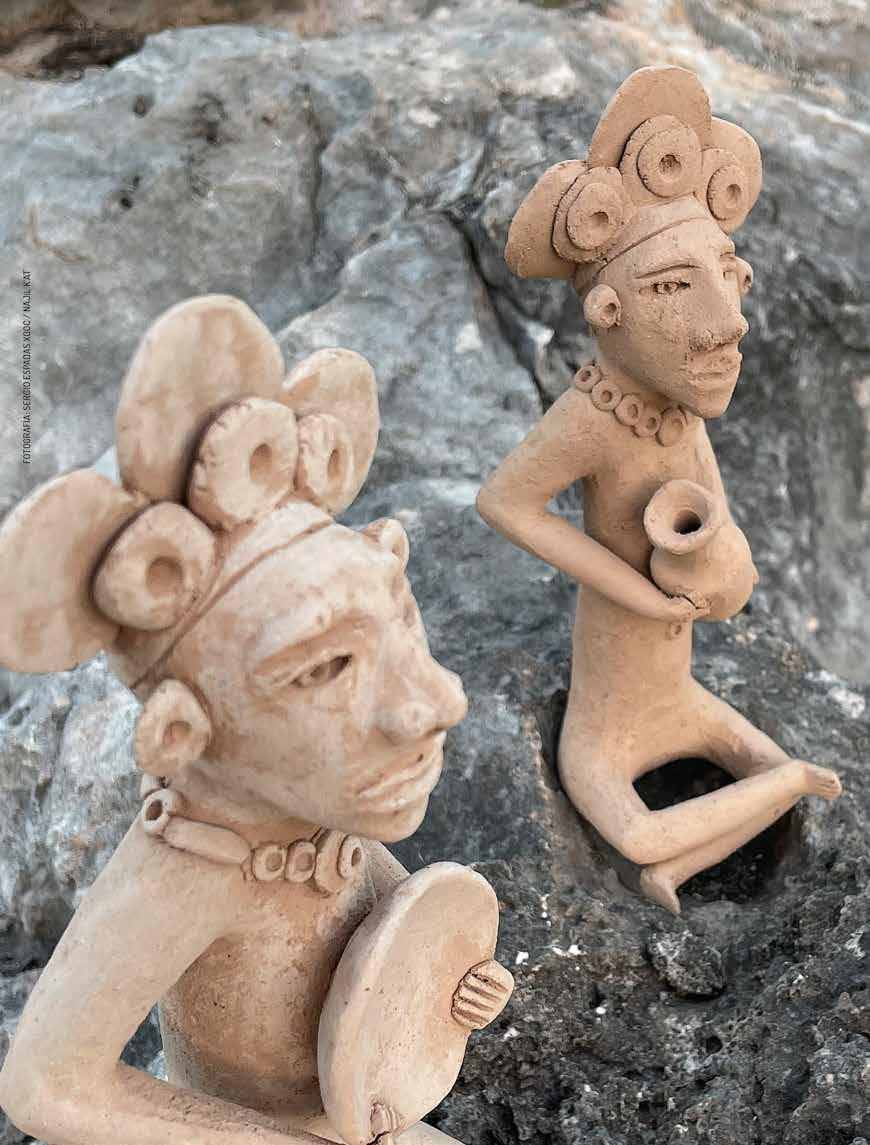
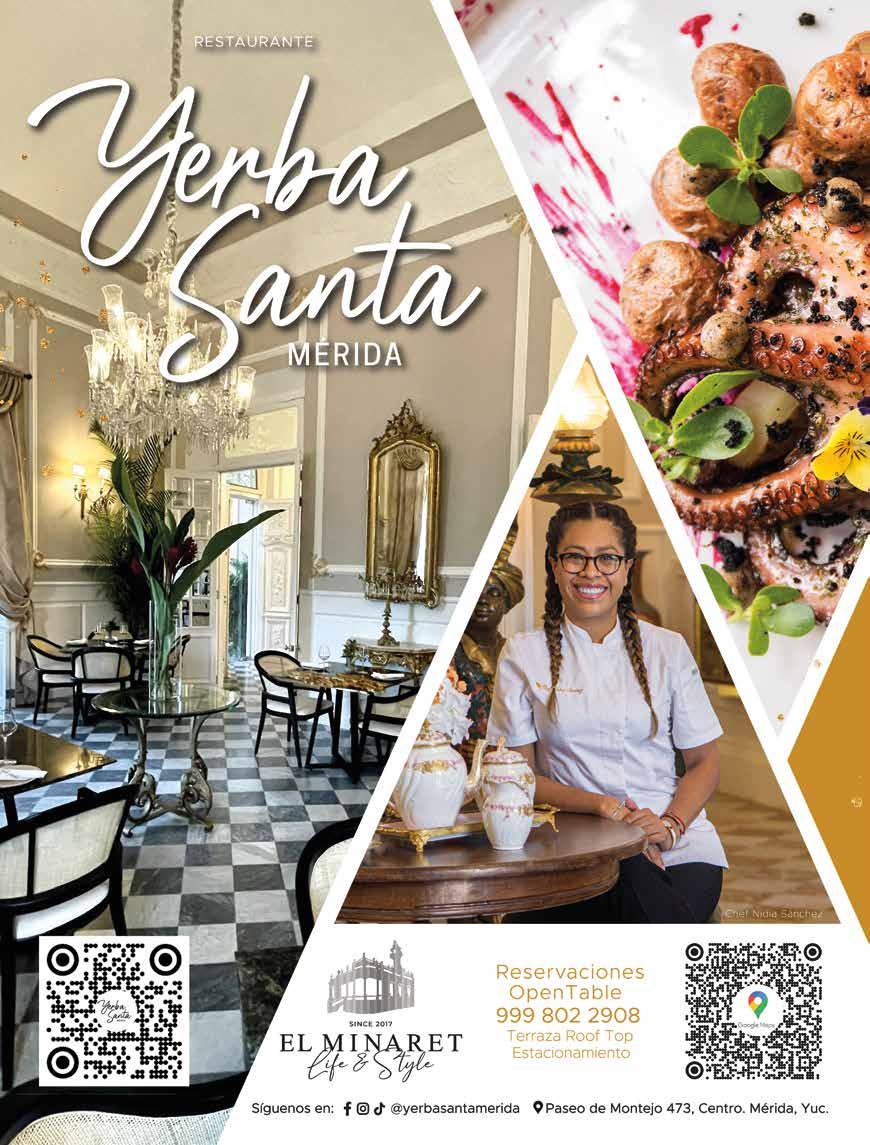
¿Qué sabes sobre Uayma?
What do you know about Uayma?
ayma, 20 minutos al noroeste de Valladolid, es más que sólo una iglesia muy distintiva. Aquí vive un legado que se ha transmitido de generación en generación: el taller Najil K’at, a cargo del maestro alfarero Emilio Espadas Dzul.
Su tienda contiene una variedad amplísima de piezas de barro exquisitamente delicadas, pero perfectamente imperfectas: claramente están hechas a mano, una por una, pero con un nivel de excelencia que te hace dudar si de verdad no hubo ningún molde de por medio (y no, no lo hubo).
Entrar a Najil K’at es un ejercicio de autocontrol: querrás comprar todo. Un juego de portavasos, porque nunca sobran, o unos tequileros, aunque ni te guste el tequila. Quizá te interese más un Alux para que cuide tu hogar o tu negocio, como los Espadas narran que sucede con los suyos.
Pero Najil K’at no es sólo una tienda; también es un taller familiar de alfarería, amorosamente mantenido y llevado por don Emilio, sus hermanos, sus respectivas esposas, sus hijos, sus nueras y sus nietas. Sólo el carácter ameno y pacífico de la familia Espadas es buena razón para visitar, pero el taller en sí es un lugar hermoso para pasar un día (o varios) desarrollando una nueva habilidad, disfrutando del ruido del viento y las aves en los árboles, y maravillándote por el fresco que hace, aun en los meses más calurosos, aun tan cerca de un literal horno.
Aquí, don Emilio y sus hijos, Sergio y José Virgilio, comparten sus habilidades y conocimientos con quien desee conocerlos. Te llevarán a ver sus hornos de piedra y el taller donde realizan sus obras de arte funcional; te contarán la historia del taller y te mostrarán, con mucho orgullo, las obras de sus aprendices, desde niños de Valladolid hasta artistas internacionales. Todas las obras están a la vista, esperando el siguiente paso de su proceso. Quizá notes que hay hojas de árboles por todos lados y te preguntes cómo el viento las hizo llegar hasta allá, y por qué nadie las ha recogido. Los Espadas, con su amabilidad y sonrisa característica, te lo explicarán con mucho gusto.
Uayma ofrece mucho más que sólo una parada fotográfica. Ven a descubrirlo por ti mismo, con una visita a la tienda, una clase en el taller, o incluso una estancia de algunos días (debido a la demanda de sus estudiantes, la familia Espadas habilitó unas cabañas para hospedaje sustentable, que ya ofrecen también al público en general).
Visita www.yuc.today/230401 para saber más sobre Najil K’at y ver fotografías adicionales.
ayma, 20 minutes northwest of Valladolid, is more than a very picturesque church. It’s also home to a living tradition, passed down generation after generation: workshop Najil K’at, led by master potter Emilio Espadas Dzul.

The store at Najil K’at holds an incredibly wide variety of delicate clay pieces. Each of them is perfectly imperfect: they’re clearly handmade, one by one, but with a level of craftsmanship that makes you wonder whether truly no casts were involved (they weren’t).
Walking into Najil K’at is an exercise in self-restraint: you’ll want to take everything home. A set of coasters, because you can never have too many, or tequila glasses, even if you don’t even like tequila. Maybe a clay Alux instead, so the figurine will guard your home of business.
But Najil K’at isn’t only a store; it’s also a family workshop, led by Don Emilio, but also his brothers, their respective wives, their children, spouses, and so on. The pleasant disposition of the Espadas family alone is good reason to visit, but the workshop itself is a beautiful place to develop a new skill, enjoying the sound of the wind and birds in the trees, and marveling at how nice the temperature is, even in Yucatán’s hottest months.
Here, Don Emilio and his family share their skills and knowledge with anyone willing to learn. They’ll take you to see the kilns and the workshop where they create functional art pieces, and they’ll show you, beaming with pride, the works of their apprentices. These include anyone from Valladolid children to internationally-renowned artists. All the works are on display, waiting for the next step in their own process. You may notice there are leaves everywhere, and wonder how the wind blew them in so far. The Espadases will be happy to explain.
Uayma offers more than just a photo-stop. Come see for yourself and visit the store, take a class at the workshop, or even stay for a few days; due to apprentice demand, the Espadas family now offers eco-sustainable cabins which they now offer to travelers in general.
Najil K’at
Tienda y taller de alfarería y cabañas ecoturísticas
Pottery store and workshop and eco-sustainable cabins
Calle 27 x 22 y 26, Uayma
m 984 105 7444 / 985 106 9308 / 985 107 0834
E Najilkat Uayma
Visit www.yuc.today/230401en to find out more about Najil K’at and see additional pictures.
1 Life and Culture
PORTADA • COVER STORY
U
FOTO: YUCATÁN TODAY
U
Don Emilio Espadas
POR / BY ALICIA NAVARRETE ALONSO Q atnavarrete
¿Por qué alguien comería algo que no fuera comida de desayuno? Why would anyone eat anything other than breakfast food?
—Leslie Knope
Querido lector,
Quiero que sepas que ha sido un placer enorme crear esta nueva edición, pensada para que le saques el máximo provecho a estos días en que el termómetro empieza a calentar motores.
Este mes celebramos la magia de la cotidianidad yucateca, y con ella, las maravillas que se esconden en donde menos las esperas. Huir del calor durmiendo en hamaca, y luego “tenderla” en un acto que, para los no iniciados, es tan rápido que parece prestidigitación. Ir al mercado a hacer las compras del día, saludando a los “venteros” que ofrecen frutas y verduras que dejan en ridículo a las del súper, tanto en calidad como en precio. Tomarse un momento para escuchar y ver a las aves que nos saludan con su canto. Ésas son sólo algunas de las prácticas que hacen de Yucatán el cálido lugar que atrae a visitantes de todos los rincones del mundo, y que te mostramos a lo largo de nuestras páginas.
Pero esta edición te trae también varias opciones para salir de lo cotidiano; por ejemplo, con alimentos extraordinarios, y vaya que aquí tenemos muchos. Como podrás adivinar por la cita con la que abrí esta carta, soy una gran entusiasta de los desayunos; este mes te traemos una lista de lugares fantásticos para iniciar el día. No importa si se trata de una reunión para ponerse al día, una ocasión especial para festejar a alguien, o darle gusto a la pancita, seguro encontrarás una opción que te interese.
La primavera nos espera; ¡vamos a aprovecharla!
DIRECTORIO • DIRECTORY
Todos los derechos reservados por Dynamic Offset SA de CV. Prohibida la reproducción total o parcial del contenido sin autorización por escrito de los editores.
La revista asume que el material aquí presentado es original y no infrige los derechos reservados de ley.
Reserva de derechos al uso exclusivo del título YUCATAN TODAY - Certificado de Derecho de Autor No. 050616181900 SECOFI.

Yucatán Today no se hace responsable por el contenido de los anuncios.

Yucatán Today is not responsible for the content of the advertisements.
TIRAJE MENSUAL 10,000

MONTHLY CIRCULATION 10,000
Calle 39 #483 interior 10, x 54 y 56, Centro Mérida, Yucatán, México, C.P. 97000 Tel. (999) 927 8531
Lun. - vie. / Mon. - Fri. 9 am - 5 pm
Dear reader,
Spring is in full bloom, and I want you to know it’s been an absolute pleasure making the magazine you’re holding, especially designed to help you make the most of these days when our thermometers start getting a workout.
This month we’re celebrating the magic of everyday Yucatán, and the wonders that come up where you least expect them. Escaping the heat by sleeping in a hammock, and then putting it away so quickly it might look like a sleight of hand. Going to the market for the day’s groceries, greeting the stall attendants who very warmly offer fruits and vegetables miles ahead of those at the supermarket, both in price and quality. Taking a few minutes to hear (and with some patience, see) the dozens of bird species whose songs greet us every day. These are just a few of the habits that make Yucatán a welcoming place that attracts visitors from all over the world, and which we’re happy to show off on our pages.
But this edition also brings you several options to escape, precisely, the everyday routine; for example, with extraordinary food, and, guess what, we have plenty of that here. As you may have guessed by looking at the quote above, I’m a breakfast food enthusiast; this month, we’re bringing you a list (in constant development) of fantastic places to start the day. Whether it’s to catch up with friends, a celebration for a special someone, or just to treat yourself (or yo’self, rather), you’ll surely find an option that catches your eye.
Spring awaits—let’s make the most of it!
Alicia Navarrete Alonso editor@yucatantoday.com
SOCIOS FUNDADORES • FOUNDING PARTNERS
Juan Manuel Mier y Terán Calero
Judy Abbott de Mier y Terán / judy@yucatantoday.com
DIRECTOR
Andrea Mier y Terán Abbott / andrea@yucatantoday.com
EDITOR • EDITOR
Alicia Navarrete Alonso / editor@yucatantoday.com
ASISTENTE EDITORIAL • EDITORIAL ASSISTANT


Sara Alba Prim / escribe@yucatantoday.com
ESCRITORES COLABORADORES • CONTRIBUTING WRITERS
Sara Alba, Alberto Chuc, Pame Fernández Greta Garrett, Alicia Navarrete, Arianne Osalde, Fernanda Pacheco, Cassie Pearse, Wuendy Salazar, Regina Zumárraga
DISEÑO GRÁFICO • GRAPHIC DESIGN
Magali Ramírez D. / diseno@yucatantoday.com
MERCADOTECNIA • MARKETING
Arianne Osalde / estrategia@yucatantoday.com
Carlos Guzmán Andrade / contenido@yucatantoday.com
Brenda Daniela Avila Acametitla / eventos@yucatantoday.com
Maria Fernanda Casanova Uc / jrdiseno@yucatantoday.com
ADMINISTRACIÓN • ADMINISTRATION
Renée Morales Jiménez / gerente@yucatantoday.com
Lic. Alitzel Muñoz Ornelas / contabilidad@yucatantoday.com
Yorgina Montalvo Pech / recepcion@yucatantoday.com
DISTRIBUCIÓN • DISTRIBUTION
Roberto Pérez Miguel / cobranza@yucatantoday.com
DISEÑO EDITORIAL • EDITORIAL DESIGN Gustavo Reyes Asid / 6US diseño
Yucatán Today, elegido como mejor creador de contenido turístico
Yucatán Today, chosen as best tourism content creator
Yucatán Today MEDIA KIT
2
LOGOTIPO
• LOGO & COVER DESIGN H
DISEÑO DE
Y PORTADA
Creativos
YUCATÁN TODAY ES LA GUÍA RECOMENDADA POR YUCATÁN TODAY IS THE GUIDE RECOMMENDED BY Yucatan Today YucatanToday yucatantoday yucatantoday www.yucatantoday.com PUBLICIDAD • ADVERTISING (999) 309 7762 / clientes@yucatantoday.com CARTA DE LA EDITORA • LETTER FROM THE EDITOR
VIDA Y CULTURA
Es muy yucateco: El arte de descolgar la hamaca
Un día en la vida: la vida en los mercados de Mérida
Xe’ek’: Elvia Carrillo Puerto Quiénes son los mayas: El ritual del Alux en Uayma
Enfoque: Hacienda Teya: Un legado más allá de sus platillos
Lo mejor de Yucatán este mes
Galerías / Museos / Teatros
Empecemos con el arte: La68, creando comunidad que invita al intercambio
¿Qué hay de nuevo?
Promociones y descuentos Eventos
Directorio de salud / DIR
COMER EN YUCATÁN
¿Vamos a desayunar? Siete opciones en Mérida
Dónde comer / DIR
Cocina yucateca
¡DÓNDE IR Y CÓMO!
Acerca de Yucatán
Acerca de Mérida
Centro de Mérida / MAPA
Barrios del Centro de Mérida
Santa Lucía
Paseo de Montejo
Ciudad de Mérida / MAPA
Mérida Norte / MAPA
Estancia de siete días Cómo llegar
Salidas familiares: Cómo visitar sitios arqueológicos con tus hijos
Descubriendo lugares: Plumas y cantos por doquier: aves en Mérida
Agencias de Viaje / Transportación / Bienes Raíces / DIR
Dónde hospedarse / DIR
DESTINOS
Grutas
Cenotes
Zonas arqueológicas mayas
Uxmal / Ruta Puuc
Chichén Itzá Haciendas
Maní y la Ruta de los Conventos / MAPA
Izamal
Valladolid / MAPA
Tekax
Sisal / Celestún
Progreso
Chuburná Puerto / Chelem / Chicxulub Puerto / MAPA
Telchac Puerto / San Crisanto / Dzilam de Bravo / MAPA
Tizimín / El Cuyo
San Felipe / Río Lagartos / Las Coloradas
REFERENCIA RÁPIDA
Consulados / Números teléfonicos de emergencia / DIR
LIFE AND CULTURE
It’s Very Yucatecan: The Art of Hanging up a Hammock
A Day in the Life: A Breath of Life at Mérida’s Markets
Xe’ek’: Elvia Carrillo Puerto
Who Are the Maya: From Uayma, the Alux Ritual
In Focus: Hacienda Teya: A Legacy
That Goes Beyond Food
Yucatán Top 10 This Month
Galleries / Museums / Theaters
Let’s Start With Art: La68, Creating Community via Cultural Exchange
What’s New?
Promotions and Discounts
Events
Health Directory / DIR
EATING IN YUCATÁN
Up for Brunch? Here are a few options in Mérida
Where to Eat / DIR
Yucatecan Cuisine
WHERE TO GO AND HOW!
About Yucatán
About Mérida
Mérida Downtown / MAP
The Barrios in Mérida’s Centro
Santa Lucía
Paseo de Montejo
Mérida City / MAP
North Mérida / MAP
A Seven-Day Stay
How to Get There
Family Outings: How to Visit Archaeological Sites With Your Kids
You’re Going Places: Maní: Feathers and Song Everywhere: Birdwatching in Mérida
Travel Agencies / Transportations / Real Estate / DIR
Where to Stay / DIR
DESTINATIONS
Caves
Cenotes
Maya Archaeological Sites
Uxmal / Ruta Puuc
Chichén Itzá
Haciendas
Maní and the Convent Route / MAP
Izamal
Valladolid / MAP
Tekax
Sisal / Celestún
Progreso
Chuburná Puerto / Chelem / Chicxulub Puerto / MAP
Telchac Puerto / San Crisanto / Dzilam de Bravo / MAP
Tizimín / El Cuyo
San Felipe / Río Lagartos / Las Coloradas
QUICK REFERENCE
Travel Tips / Emergency Phone Numbers / Consulates / DIR
3 ÍNDICE • CONTENTS PASEO DE MONTEJO & YUCATÁN MAPAS EN PÁGINAS CENTRALES • MAPS IN CENTERFOLD 4 5 6 7 8 9 10 11 12 13 14 16 17 20 22 23 24 25 26 27 28 29 30 31 32 33 34 I 35 36 37 38 39 40 I 41 42 43 44 45 46 47 48 49 50 I 51 52 53 54 55 56
ARTÍCULO NUEVO NEW ARTICLE
El arte de descolgar la hamaca
The Art of Hanging Up a Hammock
es contaré algo: cuando estoy en casa de mi papá, me gusta verlo descolgar su hamaca después de echarse una siesta. Se levanta y con agilidad suelta uno de sus lados, con una mano la sujeta por debajo de su brazo, la recoge en un par de vueltas y con el extremo libre, la rodea e introduce la punta por el medio, tira de ella y la cuelga en el gancho donde descansa el otro brazo. La hamaca queda allí: un ovillo estético y funcional que mantiene en orden el espacio.
He visto a mi padre hacer esa maniobra muchas veces y, a pesar del ejemplo, admito que nada más no me sale. Y vaya que lo he intentado; incluso he visto tutoriales en Internet.
Con mi torpeza siento que traiciono mi herencia yucateca: el arte de descolgar la hamaca es un conocimiento que debería ser común a los peninsulares y transmitirse de generación en generación: una habilidad para la vida que es a la vez una lección de orden y sencillez.
Sobre todo en las tardes calurosas de la Península, cuando nada es más rico que descansar tumbado en la hamaca y mecerse con la punta del pie mientras el sueño nos cierra los ojos. No olvidemos que la hamaca es un mueble indispensable en cualquier hogar yucateco que se respete.
De vuelta a casa de mi padre, cada habitación tiene al menos dos hamaqueros. El hamaquero es parte esencial de toda construcción en Yucatán. Un buen hamaquero es sencillo y modesto: no se hace notar, pero, cuando falta, se siente su ausencia.
Los hamaqueros más comunes están hechos de metal. En su forma más popular suelen constar de una concha de metal incrustada en la pared, con un par de agujeros en los que se inserta el gancho del que cuelga la hamaca. Esta pieza es conocida como “ese” (por su forma de “S”). Sin embargo, los hamaqueros pueden ser también una sola pieza en forma de cruz o de anzuelo; de forma más moderna y elegante, en forma de T, o también otros más decorativos de madera dura. Todos éstos van directamente en la pared.
Común en la región del Caribe, la hamaca es toda una industria y tradición en Yucatán. Las hay de varios tamaños, hechas en hilo de algodón o fibra sintética, fabricadas a mano o en serie, sencillas y refinadas. Incluso tiene su día nacional, el 22 de julio.
Mientras tanto, seguiré practicando el arte de descolgar la hamaca. No puede ser que a estas alturas aún no pueda levantarla como la tradición manda.
Here’s something I’d like to tell you: when I am at my dad’s house, I like to watch him hang up his hammock after a siesta. He gets up, unhooks one side and with one hand, hangs it around his forearm; he wraps it around like a rope, circles the free end around it, pulls on the loose end, and then hangs the hammock up on the hook on the wall. The hammock stays put, an attractive and functional ball that keeps the space in order.
I have seen my father go through these steps many times and I must admit that I still can’t copy him – it just doesn’t work for me. And, boy, have I tried. I’ve even watched all kinds of tutorials on the Internet.
With my clumsiness, I feel like a traitor to my Yucatecan heritage: the art of hanging up a hammock is something that should be innate to all residents of the Península, taught from generation to generation: it is a life skill that is also a lesson in order and simplicity.
Especially during the hot and humid afternoons of the Península, there is nothing more refreshing than settling into a hammock and slightly pushing your foot against the wall to rock yourself into a gentle snooze. Let’s not forget that this is an essential piece of furniture in any self-respecting Yucatecan home.
Back at my father’s house, each room has at least two hammock hooks. Decorative and useful at the same time, hammock hooks are an indispensable part of Yucatecan furnishings. A good hammock hook is simple and modest: it’s there without being seen, but when you don’t have one, you definitely feel its absence.
The most common Hamaqueros (hammock hooks) are made of metal. The most traditional, two-piece ones look like a metal shell embedded into the wall, with two holes to hold the actual hook from where you’ll hang the hammock. These hooks are known as “Eses,” as they are shaped like the letter “S.” However, more modern versions of Hamaqueros are now a single piece. Elegant T-shaped versions are now becoming the norm for newer homes, as well as decorative ones made of hardwood; both of these are embedded straight into the wall.
Common in the Caribbean, the hammock is a large industry and tradition in Yucatán. There are various sizes, made with cotton or synthetic fibers; woven by hand or in series; simple, or refined. There is even a National Hammock Day: July 22.
Meanwhile, I’ll continue to practice how to take down, fold, and hang up a hammock. I refuse to believe that at my age I still can’t do it as tradition dictates.

4 Vida y Cultura
ES MUY YUCATECO · IT’S VERY YUCATECAN
FOTO: ALBERTO CHUC
Q
POR / BY ALBERTO CHUC
albertochuc
L
La vida se respira en los mercados de Mérida A Breath of Life at Mérida’s Markets
n los mercados se respira vida. Claro, además de especias, frutas y verduras, gente, flores y ciertos olores que encontrarás imposible de descifrar. Una mañana en el Mercado Municipal Lucas de Gálvez (el más grande y uno de los más antiguos en la ciudad) inaugura el día. Niños corren olvidando cualquier responsabilidad (y a sus papás detrás de ellos), los claveles y las aves de paraíso pasan de unas manos a otras, se vierten las dulces aguas frescas y el olor a Cochinita Pibil permea la calle. Inicia un nuevo día.
En Yucatán, estos espacios mágicos llenos de sabor, música y energía son vastos. La orquesta comienza desde las cinco y media de la mañana y la música retumba: coches, risas, un vendedor gritando “¡marchante!” y los pasos de cientos de personas.
Tradicionalmente en Mérida, cada barrio tiene su propio mercado. La comunidad gira alrededor de ellos, ya que no sólo se utilizan para comprar, sino también para socializar y pasar el rato. Antes de dirigirte a un mercado, pregúntate qué tan importante es para ti el espacio personal, ya que puede ser un poco abrumador. La calle se llena de personas caminando con seguridad: señoras eligiendo hipiles (o joyería, o fundas para su celular), amigos desayunando mientras reviven la noche anterior; reconocidos chefs de la ciudad se encuentran en búsqueda de los ingredientes más frescos; cientos de meridanos pasan en su camino al trabajo.
A su vez, hay mercados más serenos donde la música no es tan fuerte pero el ritmo es igual de melódico. Los mercados de las colonias Miguel Alemán y Chuburná, por ejemplo, son geniales para obtener las frutas y verduras más frescas, además de carne, recados y flores. Los mercados de Santa Ana y de San Sebastián son especialmente ideales para un desayuno regional (prueba los Huevos Motuleños o unos Panuchos). Disfruta unos Tamales Colados en el mercado San Benito, Mondongo Kabic en el mercado de Santiago, o las Empanadas del mercado de la Alemán… cada espacio con una fama culinaria ganada a pulso.
La gente pasa y la vida sigue. Pasan los días y hay más flores, más frutas y verduras, más cochinita pibil y más niños corriendo. En los mercados, cada mañana es una nueva oportunidad para descubrir Yucatán de manera auténtica: su comida, su forma de vida y la música que hace su gente al comenzar un nuevo día— definitivamente una excelente manera de despertar.
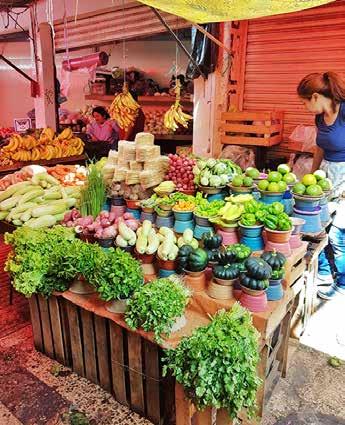
o to any one of our city markets and you’ll feel like you’re breathing in life. In addition, of course, to spices, fruits and vegetables, people, flowers, and certain scents you’ll find impossible to decipher. A morning at the Mercado Municipal Lucas de Gálvez (the biggest and one of the oldest in the city) marks the beginning of a new day. Children run around, leaving all responsibility (as well as their parents) behind them; carnations and birds of paradise are exchanged, fresh Aguas Frescas are poured, and the smell of Cochinita Pibil permeates the street. A new day begins.
In Yucatán, these magical spaces filled with flavor, music, and energy are vast. The orchestra chimes in at 5:30 in the morning and the music rumbles: cars, laughter, a salesperson shouting “Marchante!” (which is what they call would-be shoppers), and the footsteps of hundreds of people are only part of the sounds making up this melody.
In Mérida, each Barrio or neighborhood traditionally has its own market. The community orbits around them; besides using them as a place to shop, they also serve as a meeting place. But, before heading to a market, be sure to ask yourself: “How important is personal space to me?” Because it can be a bit overwhelming. The streets overflow with people walking with a purpose: ladies browsing for Hipiles (or jewelry, or cellphone cases), friends having breakfast while they reminisce over last night’s adventures, wellknown chefs hunting for the freshest ingredients, and Meridanos passing by on their way to work.
More serene markets exist as well, where the music is not as loud but the rhythm is equally melodic. The markets in Colonia Miguel Alemán and Colonia Chuburná, for example, are great if you’re on the lookout for the freshest fruits and vegetables, meat, flowers, or spices. The Mercado de Santa Ana and the Mercado de San Sebastián are great for shopping, but also perfect to try a regional breakfast (like Huevos Motuleños or Salbutes). You can also try tamales, Lechón, or Cochinita at the Mercado San Benito and Mondongo Kabic at the Mercado de Santiago. Each space has its own culinary fame.
People walk by and life goes on. Days pass and there are more flowers, more fruit and vegetables, more Cochinita, and more kids running wild. At the markets, each morning is a new opportunity to discover Yucatán in an authentic way: its food, its way of life, and the music its people make when a new day begins—definitely a great tune to wake up to.
5 Life and Culture
UN DÍA EN LA VIDA · A DAY IN THE LIFE
FOTO: CASSIE PEARSE
POR / BY GRETA GARRETT
Q great.mov
E G
Mercado Lucas de Gálvez
Elvia Carrillo Puerto y su legado a las mujeres
Elvia Carrillo Puerto and her legacy to women
arece lejana la época en la que las mujeres no tenían derecho al voto en México, sin embargo, ésa era nuestra realidad hace tan sólo 70 años. Este derecho y muchos otros se los debemos a una cantidad enorme de valientes mujeres que, en el pasado, nos abrieron camino a todos en la sociedad hoy en día; muchas de ellas, curiosamente, lo hicieron aquí en Yucatán. En esta ocasión, quiero contarte acerca de una de ellas.
Elvia Carrillo Puerto fue una líder feminista, poeta y política nacida en Motul en 1878. Junto al más célebre de sus hermanos, Felipe, Elvia fue una pieza fundamental durante y después de la Revolución Mexicana en Yucatán y el país entero.
En su juventud, por su amistad con la poeta Rita Cetina Gutiérrez, leyó a teóricas de los derechos de la mujer como Mary Wollstonecraft, Flora Tristán y Victoria Woodhull. Resulta interesante cómo las mujeres que nos inspiran fueron inspiradas por otras más. Y quizá nosotras, sin pensarlo, inspiramos a más de una mujer cercana a nuestra vida. Algo así como un ciclo sin fin.
En 1919, Elvia buscó abrir el debate sobre el voto femenino en cámaras legislativas; en 1923 se convirtió en la primera mexicana electa diputada a un Congreso Local.
Elvia no estaba sola; su hermano Felipe, gobernador de Yucatán de 1922 a 1924 y conocido por sus igual admirables luchas sociales, le brindó su apoyo hasta en pequeños detalles. Un ejemplo es aquella vez en la que le regaló una traducción al maya de la Constitución Mexicana de 1857; así, Elvia podría leer a sus alumnas los que también debían ser sus derechos.
Tras el asesinato de su hermano en 1924, Elvia se vio obligada a refugiarse en la Ciudad de México. Pasaron muchos años sin que hubiera resultados concretos para sus esfuerzos, pero fue el 17 de octubre de 1953 cuando el presidente Ruiz Cortines promulgó las reformas constitucionales para que las mexicanas gozaran de la ciudadanía plena y, por lo tanto, del sufragio.
Elvia Carrillo Puerto fue una de las mujeres que marcó la historia de Yucatán y el presente de todas las que pisamos las mismas tierras hoy en día. Más sus logros cobran importancia titánica al recordar el ciclo sin fin, ese que permite que las mujeres nos inspiremos unas a las otras, sin importar el lugar, sin importar la época.
Visita www.yuc.today/230406 para leer más sobre Elvia Carrillo Puerto, sus principios y su legado.
t seems women have had the right to vote forever, but in reality, in México this was just 70 years ago. We owe this very right and so many others to the many valiant women who in the past opened doors for all of us today. Many of these women, curiously enough, lived here in Yucatán. Today I want to tell you about one of them.
Born in Motul in 1878, Elvia Carrillo Puerto was passionate about women’s rights and was an openly feminist leader, poet and politician. Together with the most illustrious of her siblings , Felipe, Elvia was a key piece during and after the Mexican Revolution in Yucatán and the entire country.

In her youth, because of her friendship with the poet Rita Cetina, she read about the rights of women from authors like Mary Wollstonecraft, Flora Tristán, and Victoria Woodhull. It is interesting to see how the very women that inspire us were, in turn, inspired by other women. Kind of like a never-ending cycle.
In 1919, she tried to open the debate about the feminine vote in the legislature chambers but unfortunately her colleagues ignored her. However, Elvia was not alone: her brother Felipe, who was Governor of Yucatán from 1922 to 1924, was known as the “Red Apostle” for his also admirable defense of social struggles. It was during his term in office that she was the first Mexican woman to be elected as representative to the Local Congress in 1923.
It is said that her brother Felipe supported her even in the smaller details, like the time in 1857 when he gave her a Maya translation of the Mexican Constitution, so she could read it to her students, and they could learn about their rights.
After her brother’s assassination in 1924, Elvia was obligated to flee to Mexico City. Many years passed by with no concrete results for all her efforts, until October 17, 1953 when then President Adolfo Ruiz Cortines passed the constitutional reforms needed for Mexican women to claim full citizenship and, consequently, exercise the right to vote.
Elvia Carrillo Puerto was a woman who marked Yucatecan history and the present of all women who walk these lands today. Her achievements are of titanic importance when you remember the never-ending cycle that allows women to be inspired by other women, regardless of place, and regardless of time.
Visit
POR / BY PAME FERNÁNDEZ GARCÍA
6
Cultura
Vida y
XE’EK’: INCLASIFICABLE • XE’EK’: UNCATEGORIZABLE
to read more about Elvia Carrillo Puerto’s beliefs and legacy.
www.yuc.today/230406en
I P
FOTO: DOMINIO PÚBLICO
Elvia Carrillo Puerto
El ritual del Alux desde Uayma
From Uayma, the Alux Ritual
os Aluxes son seres que existen secretamente en nuestro entorno y que cumplen con una función dentro de la cosmovisión maya: proteger, hasta el fin de los tiempos, a la naturaleza y lo que proviene de ella. Suelen ser invisibles, pero se dice que puedes sentir su presencia en el viento estando en contacto con la naturaleza, cenotes, grutas, y milpas. En algunas zonas arqueológicas, como Uxmal, encontrarás su representación en piedra, pero lo más común es toparte con versiones hechas de barro. Éstas son colocadas en casas, negocios y milpas, más que como adornos, con el fin de cuidar estos lugares y ahuyentar a todo aquel que se acerque con malas intenciones. Tú también puedes encomendarte a los Aluxes y pedir su protección, pero, ¡ojo! Primero necesitas informarte, y aquí te vamos a ayudar.
La comunidad de Uayma es uno de esos lugares donde todavía se transmiten estas creencias a través del taller Najil K’at, un espacio completamente dedicado a la creación de objetos de barro. La familia Espadas, propietarios de Najil K’at, ha practicado la alfarería por generaciones, creando, entre muchas otras maravillas, representaciones de Aluxes que sobresalen por su delicadeza. Sucede que la familia Espadas ha considerado que los Aluxes son quienes resguardan su hogar, donde está también el taller; por ello, este año hicieron oficial el altar que tienen ahí a través del llamado Ritual del Alux, con el que dieron ofrenda y agradecimiento a los Aluxes y solicitaron continuar gozando de su protección.
Este ritual tuvo una duración de aproximadamente dos días, dirigido por un sacerdote maya que estuvo también encargado de solicitar los elementos necesarios para la construcción del altar. Al finalizar el ritual, el Alux fue trasladado a su casa de piedra, misma que podrás observar cuando visites Najil K’at. Cuando lo hagas, recuerda ser respetuoso y no tomar fotografías sin permiso.
Si te da curiosidad conocer más sobre el ritual del Alux en Najil K’at, puedes verlo en sus redes sociales, pues la familia quiso documentarlo para la posteridad.
Najil K’at, además de una gran cantidad de figuras de Aluxes en barro que puedes usar para encomendar tu casa o tu sitio de trabajo, ofrece talleres para que conozcas más del barro y crees tus propias piezas. Si te llevas un Alux, ellos mismos podrán ayudarte a realizar tu ritual por tu cuenta.
Así que ya sabes, visita Uayma, conoce su asombrosa iglesia virreinal, y date una vuelta por Najil K’at.
luxes (ah-loosh-es) are beings that secretly exist in our environment, carrying out an important function, according to the Maya worldview: to protect, until the end of time, nature and everything that’s born from it. They tend to be invisible, but it is said that one can feel their presence in the wind when you’re in contact with nature, at cenotes, in caves, or out in the field. At some archeological sites, such as Uxmal, you will find them represented in stone, but they’re most commonly represented in clay pieces. These are placed in locations like homes, workplaces, and Milpas (farm plots), not as ornaments, but for protection, to scare away anyone who approaches with bad intentions. You can also ask the Aluxes to protect your home, but you’ll need to do it right, and we’re here to help.
The community of Uayma is one of the places in Yucatán where these beliefs are still held and shared, for example at the Najil K’at workshop, a space that is completely dedicated to the creation of clay objects. The Espadas family, proprietors of Najil K’at, have worked with clay for generations, making exquisite Alux figurines. You see, the Espadas family considers the Aluxes to have guarded their home (where their workshop is) for years. For this very reason, this year they “consecrated” the altar they keep at the workshop through what they call an Alux Ritual, as an offer of gratitude to the Aluxes and to ask for continued protection.

This ritual took place over approximately two days, and was led by a Maya priest who asked them for the elements they would need to bring the Alux home. At the end of the ritual, the Alux was taken to its new stone home, the one you will see when you visit Najil K’at. When you are visiting please be respectful and do not take pictures without permission.
If you are curious and want to know more about the ritual of the Aluxes in Najil K’at, you can check it out on their social media pages, as the family wanted to document the ceremony for posterity.
Besides quite a selection of clay Alux figurines that you can use to protect your home or work space, Najil K’at offers workshops so that you can learn about clay and create your own pieces, Najil K’at. If you take an Alux home, they’ll tell you what you need to do to hold a ritual of your own.
So there you have it: visit Uayma, see their impressive viceroyalty church and make a visit to Najil K’at.
Q najilkat E Najilkat Uayma
7 Life and Culture
L
A ¿QUIÉNES SON LOS MAYAS? • WHO ARE THE MAYA? POR
Q fernanda.tpacheco
FOTO: YUCATÁN TODAY
/ BY FERNANDA PACHECO
Hacienda Teya: Un legado más allá de sus platillos
Hacienda
Teya: A Legacy That Goes Beyond Food
uando pensamos en restaurantes que han dejado una huella en la historia de Yucatán, seguramente viene a la mente de muchos el nombre de Hacienda Teya. Esto, gracias a don Jorge C. Cárdenas Gutiérrez y su visión para convertir una hacienda henequenera en uno de los restaurantes de comida yucateca más reconocidos a nivel internacional.
Cuenta la historia familiar que, en 1974, don Jorge decide comprarle la Hacienda San Ildefonso Teya a un amigo. En aquella época, la hacienda se encontraba en ruinas, por lo que, al principio, la familia Cárdenas se mostró escéptica ante esta compra. Sin embargo, don Jorge persistió en su restauración. En sus comienzos, Hacienda Teya sirvió como sala para eventos de la familia, en donde los platillos tradicionales de la cocina yucateca no podían faltar. Viendo la falta de propuestas gastronómicas de comida yucateca como un área de oportunidad, la familia abre un restaurante ahí mismo. Así inició la historia de la Hacienda Teya como uno de los sitios más emblemáticos de Yucatán. Hasta el día de hoy puedes ver fotos de diversos personajes de renombre mundial como la reina Sofía de España, Anthony Bourdain, Luis Miguel y muchos otros que han disfrutado de la deliciosa comida y espectaculares instalaciones.
En 2019, la familia Cárdenas trae sus inigualables sabores al centro de Mérida con el restaurante TEYA Gastronomía Viva, que busca reinterpretar los platillos yucatecos tradicionales en un espacio en donde convergen lo nuevo y lo tradicional. Poco tiempo después, inauguran el Restaurante Hacienda Teya ubicado en Santa Lucía. Con guiños a la arquitectura de Hacienda Teya, un menú tradicional y ubicado en el corazón de la ciudad, ésta es una excelente opción para personas que buscan vivir una experiencia gastronómica auténtica sin salir del Centro.
Entre los platillos más populares que se ofrecen en los tres restaurantes se encuentra el Nohoch Tun Yucateco, un plato diseñado para compartir y que contiene tres guisos tradicionales: Cochinita Pibil, Poc Chuc y Lomitos de Valladolid. Si hablamos de postres, el Flan de la Casa, preparado con la receta secreta de don Jorge, es el ideal para probar en tu visita.

Con su historia y tradición, la Hacienda Teya ya trascendió a la historia por ser una referencia de la gastronomía y cultura yucateca a nivel internacional; ahora, justificadamente, su historia se extiende hacia el futuro. ¿Qué esperas para ser parte de ella?
hen we think of restaurants that have left a significant mark in Yucatán’s history, surely Hacienda Teya comes to the minds of many. This happened in no small part due to Jorge C. Cárdenas Gutiérrez, and his vision to turn an abandoned hacienda into one of the most internationally prestigious Yucatecan cuisine restaurants.
The family story says that, in 1974, Don Jorge decided to buy Hacienda San Ildefonso Teya from a friend. Back in those days, the Hacienda was in a state of ruins, so the Cárdenas family was hesitant about the purchase. Despite this, he kept working on lovingly restoring it. In its beginnings, Hacienda Teya served as a banquet hall for family events, where they’d serve traditional dishes from Yucatecan cuisine. Seeing the lack of Yucatecan food restaurant options in the market as an area of opportunity, they decided to open a restaurant there. That’s how the history of Hacienda Teya as one of the most iconic places to visit in Mérida began. To this day, you can see pictures of different world-renowned personalities like Queen Sofia of Spain, Anthony Bourdain, Luis Miguel, and many others who have happily enjoyed the delicious food and breathtaking venue through the years.
In 2019, the Cárdenas brought their family flavors to Mérida Centro with TEYA Gastronomía Viva, which seeks to reinterpret traditional Yucatecan dishes, in a space where the new and the old converge. With the collaboration of Chef Roberto Solís, TEYA Viva offers an innovative menu and an enticing urban atmosphere that surrounds you the moment you step inside.
Some time later, Restaurante Hacienda Teya would follow in Santa Lucía. With hints of the Hacienda Teya architecture, a traditional menu, and located in the heart of the city, it’s an excellent option for people seeking an authentic foodie experience without the need to leave the city.
Among the three restaurants’ most popular options is the Nohoch Tun Yucateco, a platter designed to be shared and containing three traditional dishes: Cochinita Pibil, Poc Chuc, and Lomitos de Valladolid. If we’re talking about desserts, the Flan de la Casa, made with Don Jorge’s secret recipe, is the perfect choice to try on your visit.
With its history and tradition, Hacienda Teya has already transcended time for being a point of reference for Yucatecan culture and gastronomy on an international level: now, its history extends to the future. This is your chance to be part of it!
8 Vida y Cultura
C
W ENFOQUE •IN FOCUS
FOTO: AHCIENDA TEYA
HACIENDA TEYA ES ANUNCIANTE EN YUCATÁN TODAY • HACIENDA TEYA IS AN ADVERTISER IN YUCATÁN TODAY
POR / BY SARA ALBA

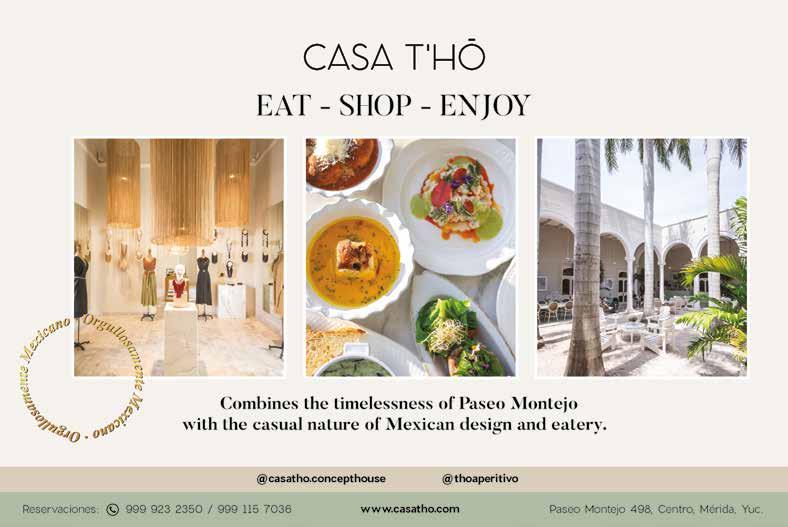

¡Llegó la temporada más esperada por los yucatecos! La liga de beisbol con los Leones de Yucatán da inicio el 23 de abril. Vive la experiencia en el Estadio Kukulkán.
The season Yucatecos love is finally here: baseball season kicks off on April 23, with our local Leones de Yucatán team as reigning champions! Don’t miss out on a game day at Kukulkán stadium.
www.leones.mx
Una noche “tranquila” en la gran ciudad de Mérida, pues aquí está el Bar Lagarto de Oro, con historial de buenas cervezas y un ambiente que no olvidarás. Si se te antojan más opciones consulta las páginas 20 y 21.
How about a “quiet” night in Mérida’s Bar Lagarto de Oro, known to be great for drinks and an atmosphere you won’t soon forget. For additional options, check out our pages 20 and 21.
E El Lagarto de Oro
Homún, el paraíso de los cenotes, es hogar también de Splash Parque Acuático, que recientemente inició su temporada. ¡Sus piscinas son otra excelente manera de refrescarse!
Homún is another great place to hide from the heat, as it’s cenote paradise, and now also home to recently reopened water park Splash. Cool down at their pools and try an ice-cold Michelada. Arrive early, as capacity is limited.
www.bit.ly/SplashHomun
El calorcito yucateco amerita playa y el puerto de Chelem nos pide que lo visitemos. Relájate en sus aguas color esmeralda y disfruta de su restaurante Costa Azul; dicen que sus mariscos no tienen comparación.
The rising Yucatecan heat calls for a beach visit, and so does the port of Chelem. Relax in its emerald-green water and enjoy the food at Restaurante Costa Azul; some say their seafood is unparalleled.
2 7
Se acerca el 30 de abril, ¡y los niños lo saben! Regálales el mejor Día del Niño en la Feria Infantil 2023 en el Siglo XXI. Encontrarás actividades, como brincolines, torneo de robótica y más. ¡La entrada es gratuita!
April 30 is Children’s Day in México! Celebrate yours at the Feria Infantil 2023 at the Siglo XXI convention center, with lots of activities. Free admission!
m 999 998 1916
10
Este mes This month
El 22 de abril es el Día de la Tierra, y Kaxil Kiuic es una buena idea para conocer más de la naturaleza y lo que proviene de ella. En esta reserva biocultural puedes hospedarte, hacer senderismo y visitar comunidades mayas.
April 22 is Earth Day, and Kaxil Kiuic is a great place to come in contact with everything it gives us. Stay at least one night, go hiking, and visit local Maya communities.
www.kaxilkiuic.org.mx
3 6
1 10 4 9 5 8
Aprovecha el puente del Día del Trabajo para lanzarte a Valladolid y visita el cenote Zací, que por mucho tiempo estuvo cerrado. Disfruta de sus nuevas instalaciones y de la frescura de sus aguas.
International Workers’ Day is a federal holiday in México. How about making the most of it by visiting the recently reopened cenote Zací, in Valladolid?
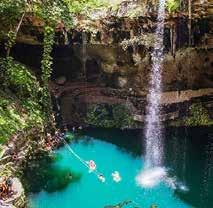 E Cenote Zací
E Cenote Zací
Cerca de Valladolid se encuentra la comunidad de Yokdzonot. Te aconsejamos hacer una parada para conocer su cenote y tomarte fotografías en las casas pintadas con representaciones yucatecas.
Near Valladolid you’ll find the village of Yokdzonot. Make sure to stop there to see its cenote and take some pictures of the many cute houses decorated with Yucatecan-themed murals.
www.yuc.today/yokdzonot
Este 10 de mayo vamos a celebrar a mamá como se debe; un buen desayuno siempre es una excelente opción. Mansión Mérida y Rosas & Xocolate son sólo algunas opciones; en la página 17 te damos una lista más amplia.
Mexicans celebrate Mother’s Day on May 10. Whether you celebrate then or on Sunday 14, brunch is always a great option. Mansión Mérida and Rosas & Xocolate are a few to consider; find a full list on page 17.
Tendremos todo un fin y un día más para festejar el Día de la Familia y del Maestro (15 de mayo). ¿Qué te parece pasarlos en Celestún? Date un tour por su ría, diviértete en Casa Peón y desayuna en su mercado.
The International Day of Families and Teacher’s Day are both on May 15. Thinking of celebrating? How about Celestún? Take a tour of the estuary, have fun at Casa Peón, and enjoy breakfast at the market.
9 Life and Culture LO MEJOR DE YUCATÁN ESTE MES • YUCATÁN TOP 10 THIS MONTH
TOP
FOTOS: ESTEBAN DUPINET
Cenote Zací
GALERÍAS / MUSEOS / TEATROS • GALLERIES / MUSEUMS / THEATERS
GALERÍAS • GALLERIES
Agustín Galería / Studio
Av. Rómulo Rozo #483 x 25 y 25-A, Itzimná
m 999 262 4510 E Agustin Galería
Centro Cultural La Cúpula
Calle 54 x 41 y 43, Centro, Mérida
Q E Centro Cultural la Cúpula
El Caimito
Calle 7 x 26 y 28, García Ginerés, Mérida
m 999 287 4417 E El Caimito
El Zapote Galería
Calle 57 #545-A x 66 y 68, Centro, Mérida
m 999 923 1391 E El Zapote
Filux Lab
Calle 64 #383-A x 45 y 47, Centro, Mérida
Q E Filux lab
Galería Arte Municipal •
Municipal Art Gallery
Calle 56 x 65 y 65-A, Centro, Mérida
m 999 923 6869
Galería de Historiadores y Exploradores
Historians and Explorers Gallery
Interior / Inside Hotel Hacienda Uxmal
m 999 445 9845
Galería Nahualli
Calle 60 #405 x 43 y 45, Centro, Mérida
Q Nahualli Gallery E Galería Nahualli
La Galería
Calle 64 #562-A x 73 y 71, Centro, Mérida
Q E La Galería Hotel Boutique
Lux Perpetua Art Centre
Calle 20 #87-E x 15, Col. Itzimná, Mérida
Q E Lux Perpetua Art Centre
Milagro Galería
Calle 25 #177 x 36 y 38, Col. Buenavista
Q E Milagro Galeria
SoHo Galleries
Calle 60 #400-A x 43 y 41, Centro, Mérida
m 999 344 7463
E SOHO Galleries
www.sohogalleriesmx.com
MUSEOS • MUSEUMS
FUERA DE MÉRIDA • OUTSIDE MÉRIDA
Casa de los Venados
Calle 40 #204 x 41, Centro, Valladolid
Donativo $100 pesos
Choco-Story • Chocolate Museum
Uxmal & Valladolid
E Choco-Story Mexico
Entrada / Entry: $150 pesos
Hacienda Sotuta de Peón • Living Henequén Museum
Carr. Mérida - Peto, salida Tecoh
m 999 941 6441
Recorridos / Tours 9 am, 1 pm (español)
Entrada / Entry: $850 pesos adultos / adults, $499 pesos niños / children
Hacienda Yaxcopoil • Henequén Museum
Carr. / Highway Mérida - Uxmal Km 220
Entrada / Entry: $125 pesos (niños gratis/ kids free)
Museo Comunitario de Yaxunah
Calle 25, Centro, Yaxcabá m 999 268 9216
Museo de Felipe Carrillo Puerto
Calle 29 x 28, Centro, Motul m 991 915 1766
Museo del Meteorito
Malecón Tradicional x 66 y 68, Progreso Entrada / Entry:
$250 pesos mexicanos / Mexicans
$350 pesos extranjeros / foreigners
$100 pesos niños y adultos mayores con INAPAM / kids and seniors with INAPAM
Museo de Ropa Étnica de México
Calle 49 x 40 y 42, San Juan, Valladolid
m 985 113 6334
Entrada por donación / Entry by donation
Museo San Roque
Calle 41 #193 x 38 y 40, Centro, Valladolid
Gratis / Free
EN MÉRIDA • IN MÉRIDA
Casa de Montejo
Calle 63 x 60 y 62, Centro, Mérida
Casa Museo Montes Molina • House Museum
Paseo de Montejo #469 x 33 y 35, Mérida
E La Quinta Montes Molina
El Minaret
Paseo de Montejo #473, x 35 y 37, Mérida
E El Minaret Paseo Montejo
Gran Museo del Mundo Maya de Mérida
Calle 60 Norte, Col. Cordemex, Mérida
m 999 341 0435 ext. 1005, 1070
E Gran Museo del Mundo Maya de Mérida
www.granmuseodelmundomaya.com.mx
Montejo 495 Casa Museo • House Museum
Calle 45 #495 x 43, Paseo de Montejo
E Montejo 495
www.montejo495.com
Entrada / Entry: $50 pesos a $250 pesos
Museo Conmemorativo Inmigración
Coreana • Korean Immigration Museum
Calle 65 #397-A x 44 y 46, Centro, Mérida
E Museo Conmemorativo de la Inmigración Coreana a Yucatán
Gratis / Free
Museo de Arte Popular • Folk Art Museum
Calle 50-A #487 x 57, Centro, Mérida
Q E Museo de Arte Popular Yucatán
Gratis / Free
Museo de la Canción Yucateca • Yucatecan Song Museum
Calle 57 #464-A x 48, Centro, Mérida
E Museo de la Canción Yucateca A.C.
Entrada / Entry: $50 pesos
Museo de la Ciudad • City Museum
Calle 56 x 65 y 65-A, Centro, Mérida
E Museo de la Ciudad de Mérida
Gratis / Free
Museo del Pueblo Maya •
Museum of the Maya People
Dzibilchaltún
CERRADO / CLOSED
Museo Fernando García Ponce - MACAYArte Contemporáneo • Contemporary Art
Calle 60 x 61 y 63, Centro, Mérida
E MACAY
www.linktr.ee/museo_macay
Museo Pinacoteca “Juan Gamboa Guzmán”
Calle 59 x 58 y 60, Centro, Mérida
CERRADO / CLOSED
Museo Palacio Cantón • Anthropology Museum
Paseo de Montejo x Calle 43, Mérida
E Museo Palacio Cantón
Entrada / Entry: $90 pesos
Palacio de la Música
Calle 59 x 58, Centro, Mérida
E Palacio de la Música - Centro Nacional de la Música Mexicana
TEATROS • THEATERS
Teatro De La Rendija
Calle 50 #466 x 51, Centro, Mérida
m 999 329 1313
E Teatro de la Rendija
10 Vida
y Cultura
La68: creando comunidad que invita al intercambio
La68: Creating Community via Cultural Exchange
implemente entrar a La68 te llenará del aire de serenidad que se respira. Éste es un espacio que te sumergirá en un entorno cohesivo de reflexión y convivencia, hogar de cautivadores espacios con una identidad única, que te obligan a querer saber más sobre su origen y razón de ser.
Al adentrarte un poco más, es inevitable percibir la enorme pasión de sus creadores, evidente en cada uno de los proyectos que habitan en ella. El nuevo concepto de La68 brinda diversos ambientes que invitan al consumo del arte y la cultura desde una perspectiva colectiva.
Durante mi visita, Daniela Camacho, directora de La68, me muestra entusiasmadamente la galería que conforma un espacio donde el arte se vive en movimiento y el conocimiento se comparte mediante talleres que invitan al intercambio. Según me cuenta, esta sala ha sido sede de eventos de todo tipo, desde clases de cumbia hasta charlas que buscan generar un diálogo.
Más allá de sus constantes eventos, La68 alberga una variedad de proyectos que coexisten de manera fija en el centro cultural.
La Retorno
Q laretorno
Una tienda de ropa enfocada en el consumo consciente y sostenible de la moda.
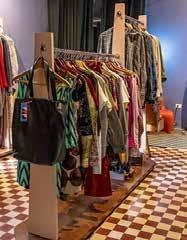
Plants of Wonder
Q plantsofwonder.mx
Visita la tienda física de esta marca de alimentos elaborados 100% a base de plantas, o disfrútalos en el patio central de las instalaciones.
Leídos
Q leidos.mx
Encuentra tu siguiente lectura en esta acogedora librería, con ejemplares tanto nuevos como de segunda mano.
Onfalia Yoga
Q onfaliayoga
Aquí encontrarás clases de vinyasa, hatha y yoga restaurativo para personas con diferentes habilidades y objetivos.
Pasatiempo Fortuna
Q pasatiempofortuna
Un laboratorio que invita a explorar el tarot desde diferentes aproximaciones, por medio de clases y experimentos.
Cómo visitar el centro cultural
La68 se encuentra abierta al público los jueves, viernes y domingos de 10 am a 3 pm, y los sábados de 10 am a 7 pm. Para más información sobre sus talleres y eventos, te invito a visitar sus redes sociales.
ust walking into La68 will fill you with serenity and peace. This is a space that will immerse you in a cohesive environment of reflection, home to captivating spaces with a unique identity, which makes you want to find out more about their origin.
When you take a closer look, you can’t help but feel the great passion the creators have poured here, which is evident by every project housed within. The concept at La68 provides many atmospheres that encourage the consumption of art and culture from a collective perspective.
During my visit, Daniela Camacho, director of La68, enthusiastically showed me the gallery where you will find art in movement along with workshops that invite exchange. She shared with me that this hall has been the site of all genres of events with everything from cumbia dance classes to lectures.
Beyond the constant events, La68 houses several permanent projects worth checking out:
La Retorno
Q @laretorno
A clothing store that focuses on conscientious and sustainable fashion consumption.
Plants of Wonder
Q @plantsofwonder.mx
Visit this shop that has its own brand of 100% plant-based food. You can also savor their exquisite vegan dishes served directly to your table in the indoor patio.
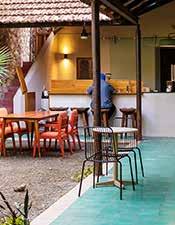
Leídos
Q @leidos.mx
This cozy bookshop offers a selection of new and second-hand books.
Onfalia Yoga
Q @onfaliayoga
Onfalia facilitates classes of vinyasa, Hatha and restorative yoga.
Pasatiempo Fortuna
Q @pasatiempofortuna
A laboratory that invites you to explore Tarot from different perspectives through classes and experiments.
How to visit the Cultural Center
La68 is open on Thursday, Friday, and Sunday from 10 am to 3 pm and Saturday from 10 am to 7 pm. For more details, visit their social media.
Calle 68 #468 x 55 y 57, Santiago
m 999 924 95 40
Q @la68.mx E La68
11 Life and Culture
EMPECEMOS CON EL ARTE · LET’S START WITH ART
S
J
FOTOS: REGINA ZUMARRAGA
POR / BY REGINA ZUMÁRRAGA Q reginaz97
La Retorno Plants of Wonder, La68
MÚSICA Y UN BRUNCH INIGUALABLE EN BC66 / MUSIC AND AN UNFORGETTABLE BRUNCH AT BC66
Déjate deleitar por un exquisito brunch al estilo francés acompañado de música en vivo todos los fines de semana de 10:30 am a 12 pm en el Bistro Cultural.
Relish in an exquisite French-style brunch, along with live music every weekend from 10:30 am to 12 pm at Bistro Cultural.
Q bistro_cultural E BC66
CELEBRA EN BISTROLA 57 / CELEBRATE AT BISTROLA 57

Celebra tus momentos más especiales con nosotros. ¡Reserva con tiempo!
Celebrate your most special moments with us. You can book in advance!
m 999 254 0048
Q & E Bistrola 57 / www.bitly.bistrola57_menu
PAUSA Y REFRÉSCATE EN CASA KIOOL / PAUSE AND REFRESH AT CASA KIOOL
¿Calor intenso? Pausa & refresh: ven y disfruta nuestro Facial Purifresh, con unos toques de menta y cítricos para refrescar tu rostro y darle un apapacho a tu cuerpo 60 min de absoluto placer.
Intense heat? Pause & refresh: come and enjoy our Purifresh Facial, with hints of mint and citrus to refresh your face and give your body 60 minutes of absolute pleasure, you deserve it!
Appointments: +52 999 216 0874
E CASA KIOOL Mérida
CELEBRA TUS MOMENTOS ESPECIALES / CELEBRATE YOUR SPECIAL MOMENTS
Prepara tu evento con nosotros y vuelve ese momento inolvidable.
Prepare your event with us and turn it into unforgettable memories.
Q casatho.concepthouse
E CASA T’HŌ www.casatho.com / eventos@casatho.com
AMUEBLA TU ESPACIO CON DUPUIS / FURNISH YOUR HOME WITH DUPUIS
En el espectacular showroom de Dupuis, encontrarás cientos de opciones de muebles y acentos para entrega inmediata y con el estilo contemporáneo que caracteriza a esta marca mexicana.
In Dupuis’ phenomenal showroom, you’ll find hundreds of pieces of furniture and accent options for immediate delivery and with the contemporary style and that defines this Mexican brand.
Plaza Sinergia Local 5, km 11 Carr. Mérida-Progreso
m 999 357 6679
Q dupuis_mx
www.dupuis.com.mx
BRUNCH TRADICIONAL EN HACIENDA XACANTUN / TRADITIONAL BRUNCH AT HACIENDA XCANATUN
¡Ahora ya puede disfrutar todos los domingos de nuestro tradicional brunch Xcanatun en el restaurante Casa de Piedra! Brunch abierto al público desde las 9 am. You can now enjoy our traditional Xcanatun brunch every Sunday at the Casa de Piedra restaurant! Brunch open to the public from 9 am.
L 999 640 5243
EXPERTOS EN AIRBNB / EXPERTS IN AIRBNB
¿Compraste una propiedad y no tienes quien te la decore o administre? Nosotros nos encargamos de todo: Manejo de la cuenta en la app, limpieza, jardinería, fotografía, piscinas y mantenimiento en general. Llámanos y pregunta por Fabiola y Matías. Did you buy a property and want someone to decorate or manage it? We’ll handle everything: vacation rental apps, housekeeping, gardening, photography, pools, and maintenance in general. Call us and ask for Fabiola and Matías.
m 999 965 8953
Q & E hamaka.mx
GASTRONOMÍA YUCATECA / YUCATECAN CUISINE
Aprende sobre la gastronomía yucateca preparando deliciosos guisos tu mismo en el taller de cocina tradicional que ofrecemos a los huéspedes del Hotel Del Peregrino. Learn about Yucatecan cuisine by preparing delicious dishes by yourself in the traditional cooking classes we have to offer to our guests.
Reserve now at Hotel Del Peregrino info@hoteldelperegrino.com www.hoteldelperegrino.com
MÁS QUE UNA LIBRERÍA / MORE THAN A BOOKSTORE
¡Between the Lines es tu librería indie local! Tenemos una gran variedad de ficción, no ficción, historia Maya, gastronomía, y un rincón para niños.
Between the Lines is your local indie bookstore! We have an eclectic variety of fiction, non-fiction, Maya history, gastronomy, and we have a great kids’ corner.
Calle 62 x 53, Centro, in Plaza Carmesí
m 999 242 3528
Q & E Between the Lines Merida
MÚSICA Y BAILE EN LAGOS TAVERNA GRIEGA / MUSIC AND DANCE AT LAGOS TAVERNA GRIEGA
Música en vivo con violinistas; además, un show de Belly Dancers, mientras te deleitas con nuestro increíble menú
mediterráneo. Todo esto en nuestra Taverna Griega. Live music with violinists as well as a Belly Dancers show, while you delight in our incredible Mediterranean menu, all this in our Greek Taverna.
Q & E Lagos Taverna Griega
https://linkin.bio/lagostavernagriega
Vie y sáb. / Fri. and Sat. 8:30 pm - 11:30 pm.
CONOCE LO NUEVO EN MANSIÓN MÉRIDA / CHECK WHAT’S NEW IN MANSIÓN MÉRIDA
¡Huevos Mansión! Ven y disfruta de lo mejor en desayunos de lunes a domingo.
Huevos Mansión! Come and enjoy the best of breakfasts from Monday to Sunday.
m 999 924 4642 / 999 101 9817
Q & E Mansión Mérida
NUEVA LÍNEA DE MOBILIARIO EN MET / NEW FURNITURE LINE AT MET
Conoce nuestras Líneas: MET Muebles a Consignación, Metamorfosis, muebles restaurados y nuestra Línea de Muebles Nuevos METODO. ¡Tenemos el mobiliario ideal para tu espacio!
MET Consignment Furniture, Metamorfosis our restoration furniture and the New Furniture Line: METODO. We have the ideal furniture for you!
Q & E Muebles En Transito
www.mueblesentransito.com
CONOCE MEXLAW / DISCOVER MEXLAW
Mexlaw es una firma canadiense establecida en México y regulada por el Colegio de Abogados de Canadá. Nuestro propósito es asistir a extranjeros interesados en vivir, invertir, hacer negocios, o retirarse en México.
Mexlaw is a Canadian Law firm established in México and regulated by the Canadian Bar Association. Our main goal is to assist foreigners interested in living, investing, doing business, or retiring in México.
m+52 984 803 1240 / Toll Free Canada
m USA: 855 851 5000
www.mexlaw.com
SHOW DE TITERADAS EN PASEO 60 / PUPPET SHOW AT PASEO 60
El domingo 30 de abril te esperamos en Paseo 60 con un show de Titeradas en el Patio Central. ¡Festejemos a los más pequeños de la familia y celebremos el día del niño!
Come join us on Sunday, April 30 at Paseo 60 where Titeradas, a regional puppet show, will be held on the Central Patio to celebrate the youngests members of the family for Children’s Day.
Calle 60 x 35 y Av. Colón, Centro
E Paseo 60
12 Vida y Cultura ¿QUÉ HAY DE NUEVO? • WHAT’S NEW
NOCHES DE MÚSICA EN LA TERRAZA /
TERRACE FILLED WITH LIVE MUSIC
Deleita tus sentidos y vive un gran momento en la terraza con nuestra cartelera musical de jueves a sábado a partir de las 8 pm. Informes y reservaciones: Delight your senses and have an amazing time at the terrace with our musical program from Thursday to Saturday starting at 8 pm. Further information and reservations at: m 999 923 9964
Q teyasantalucia
https://linkr.bio/RestauranteHaciendaTeya

JAZZ SENSITIVE EN ROSAS Y XOCOLATE /
JAZZ SENSITIVE AT ROSAS & XOCOLATE
Noches de Jazz en vivo con “Jazz Sensitive” todos los jueves en nuestra terraza con la increíble vista a Paseo de Montejo de 9:30 pm a 11:30 pm, los viernes y sábado sube a conocer nuestro Moon Lounge de 9:30 pm a 11:30 pm y disfruta de un ambiente relajado. Domingo de brunch de 10:00 am a 12:00 pm
Live Jazz nights with “Jazz Sensitive” every Thursday on our terrace with the incredible view of Paseo de Montejo from 9:30 pm to 11:30 pm, on Fridays and Saturdays go up to our Moon Lounge from 9:30 pm to 11:30 p.m. and enjoy a relaxed atmosphere.
Sunday brunch from 10:00 a.m. to 12:00 p.m.
Q & E Rosas y Xocolate
www.rosasandxocolate.com
MÚSICA EN VIVO EN SANBRAVO / LIVE MUSIC AT SANBRAVO

En Sanbravo disfruta las noches con nuestro DJ en vivo los viernes y sábados a partir de las 9 pm. Enjoy your nights with our live DJ every Friday and Saturday, starting at 9 pm.
E Sanbravo
https://linktr.ee/Sanbravo
UNA NUEVA PROPUESTA GASTRONÓMICA EN YERBA SANTA / A NEW GASTRONOMY PROPOSAL AT YERBA SANTA
Yerba Santa es una nueva propuesta gastronómica que fusiona la cultura y tradición de la gastronomía mexicana, a través de ingredientes de la tierra que conectan todos los sentidos. Ubicada en El Minaret sobre Paseo de Montejo.
Yerba Santa is a new cuisine proposal that fuses the culture and tradition of Mexican cuisine, through ingredients that connect all senses. Located in El Minaret in Paseo de Montejo. Reservations at m 999 802 2908
Q & E yerbasantamerida
www.yerbasantamx.com/merida
¡Nuestro programa de lealtad te recompensa! Q Between the Lines Merida


Tarta Alsaciana, ensalada, bebida y postre por $220 pesos. Q bistro_cultural
Promociones todos los días de la semana, te esperamos. E Bistrola 57
Con tu revista, 10% de descuento en servicios de masaje pagando en efectivo. E CASA KIOOL Mérida

Cerveza gratis con tu platillo en Paseo 60. Aplican restricciones.
Servicio de interiorismo sin costo, renueva tus espacios con Dupuis. Q dupuis_mx
Celebra a mamá en el spa de Hacienda Xcanatun by Angsana. m 999 930 2140
Aspirados de piscina gratis durante el primer mes de servicio (Planes Luxe o Luxe Max). Q hamaka.mx
Hospédate 3 noches y obtén 10% de descuento en la clase de cocina.
Buffet especial en Mansión Mérida para celebrar a mamá el 10 de mayo.
Desayuno completo por $149 pesos: jugo, fruta, pan dulce, plato fuerte y café.
Tour de snorkel en dos cenotes y almuerzo con una familia maya.
10% de descuento en pago en efectivo. No incluye muebles a consignación.
Vive la vida frente al mar con nuestra promoción de cervezas a $25 pesos.
Renta tu bici en Paseo 60 y rueda por las calles de Mérida.
Degusta nuestras variedades de Pox.
Q posheriamerida
Cócteles seleccionados al 2x1.
Q teyasantalucia
Cervezas gratis con el consumo de tu plato fuerte. Consulta restricciones.
We have three ways to reward you with our Customer Loyalty Program!
Q Between the Lines Merida
Alsaciana tart, salad, drink, and dessert for $220 pesos. Q bistro_cultural
Special offers every day of the week, come visit us! E Bistrola 57
Show your magazine and get 10% off in massage services paying in cash
E CASA KIOOL Mérida
Free beer with your main. Restrictions apply. Valid in Crabster Paseo 60.

Free interior design service; renovate your spaces with Dupuis.




Q dupuis_mx


Treat your mom with a spa day at Hacienda Xcanatun by Angsana. m 999 930 2140


Free pool cleanings during your first month of service (Luxe or Luxe Max plans). Q hamaka.mx
Stay 3 nights at Hotel del Peregrino and get 10% off on your cooking class.

Celebrate your mom at Mansión Mérida! Special buffet on May 10.

Full breakfast for $149 pesos: juice, fruit, pastry, main course, and coffee are included.
Two-cenote snorkeling tour and lunch with a Mayan Family
10% Off on cash pay only. Doesn’t include furniture on consignment.

Savour life at sea with our promotion of beers at $25 pesos.
Rent your bike at Paseo 60 and cycle through the streets of Mérida.
Free tasting of our different kinds of Pox.
Q posheriamerida
Enjoy a selection of our favorite cocktails with our 2x1 deal. Q teyasantalucia
Free beer along with the consumption of your main course. Restrictions apply.
13 Life and Culture PROMOCIONES Y DESCUENTOS • PROMOTIONS AND
DISCOUNTS
CARTELERA MENSUAL EN MÉRIDA • MONTHLY CALENDAR IN MÉRIDA
Biciruta nocturna / Biciruta at night:
Paseo de Montejo
Primer sábado de cada mes, 6 - 10 pm
First Saturday of each month, 6 - 10 pm
Festival Gastronómico / Food Festival:
Séptima Edición del Yucatán Food Fest
26 -28 abril
April 26- 28
www.clubsubarita.mx
E Club Subarita
Artes Visuales / Visual Arts:
“Ecos de Ecúmene”
Abril - 12 de mayo, lun. - dom. 8:30 am - 5:30 pm y dom. 8:30 am - 4:30 pm; Bistro Cultural.
April - May 12, Mon. - Sun. 8:30 am - 5:30 pm and Sun. 8:30 am - 4:30 pm; Bistro Cultural
Artes Visuales / Visual Arts: Hibridaciones (ORLAN)
Dic. - 7 de mayo, mié. - lun. 9 am - 5 pm
December - May 7, Wed. - Mon. 9 am - 5 pm
Gran Museo del Mundo Maya
$150 pesos (extranjeros / Foreigners)
$100 pesos (mexicanos / Mexicans)
$50 pesos (yucatecos / Yucatecans)
Arte / Art:
Van Gogh: The Immersive Experience
A partir del 21 de marzo, lun. - dom. 10 am a 9 pm; Siglo XXI. Desde $280 pesos
Starting on March 21, Mon. - Sun. 10 am to 9 pm; Siglo XXI. Starting at $280 pesos www.feverup.com/m/124901
Concierto / Concert: Camilo
5 de mayo, 9 pm; desde $580 pesos
May 5, 9 pm; starting at $580 pesos Foro GNP Seguros www.eticket.mx
Concierto / Concert: Orquesta Infantil y Juvenil de Mérida
23 de abril, 5 pm; Evento gratuito
April 23, 5 pm; Free admission Centro Cultural de Mérida Olimpo
Tributo a Coldplay en Mérida
Tribute to Coldplay in Mérida
28 de abril; 9 pm; desde $400 pesos
April 28, 9 pm; starting at $400 pesos Teatro Carlos Acereto www.tusboletos.mx
Leyendas Legendarias en Mérida
Leyendas Legendarias podcast in Mérida
29 de abril, 9 pm; desde $450 pesos
April 29, 9 pm; starting at $450 pesos
Auditorio La Isla Mérida
www.tusboletos.mx
Concierto / Concert:
María José
12 de mayo; 9 pm, desde $810 pesos
May 12, 9 pm; starting at $810 pesos
Foro GNP Seguros
www.eticket.mx
Bazar Artesanal en BC66
Artisanal Bazaar at BC66
7 de mayo; 8:30 am - 3:30 pm
May 7, 8:30 am to 3:30 pm
Bistro Cultural, Calle 66 x 41 y 43, Centro.
E BC66
Leones de Yucatán / Baseball New Season
Compra tus boletos para la temporada que comienza el 20 de abril
Buy your tickes for the new season that starts on April 20.
E Leones de Yucatán
EVENTOS SEMANALES IN MÉRIDA • WEEKLY EVENTS IN MÉRIDA
.............. LUNES / MONDAY ...................
Recorrido Gratuito / Free Walking Tour
(Bilingual) 9:30 am, Palacio Municipal
Conversaciones con amigos /
Language exchange
9 am - 1 pm, Merida English Library
Recorrido Gratuito / Free Walking Tour
(Bilingual) 6:30 pm, Módulo información en Paseo de Montejo x Av. Colón.
Vaquería / Traditional Yucatecan Dancing
9 pm, Palacio Municipal
............... MARTES / TUESDAY ...............
Recorrido Gratuito / Free Walking Tour
(Bilingual) 9:30 am, Palacio Municipal
Cata de Miel / Honey Tasting (Bilingual)
5 - 7 pm, www.mielnativa.com/experiencias
Recorrido Gratuito / Free Walking Tour
(Bilingual) 6:30 pm, Módulo información en Paseo de Montejo x Av. Colón.
Martes de Trova: 8 pm, C. C. Olimpo
Remembranzas Musicales
8:30 pm, Parque de Santiago
......... MIÉRCOLES / WEDNESDAY .........
Tour: House and Garden Tour
9 am, Merida English Library; $400 pesos
Recorrido Gratuito / Free Walking Tour
(Bilingual) 9:30 am, Palacio Municipal
Cata de Miel / Honey Tasting (Bilingual)
5 - 7 pm; $450 pesos www.mielnativa.com/experiencias
Recorrido Gratuito / Free Walking Tour
(Bilingual) 6:30 pm, Módulo información en Paseo de Montejo x Av. Colón
Miércoles de Trova
7 pm, Museo de la Canción Yucateca
MEL Talks: 7 pm, Merida English Library
Video mapping:
Diálogos del Conquistador
8 pm, Miércoles / Wednesday. Gratis / Free Casa Montejo, Plaza Grande, Mérida
............... JUEVES / THURDAY ..............
Recorrido Gratuito / Free Walking Tour (Bilingual) 9:30 am, Palacio Municipal
Recorrido Gratuito / Free Walking Tour (Bilingual) 6:30 pm, Módulo información en Paseo de Montejo x Av. Colón.
Serenata / Santa Lucía Serenade
9 pm, Parque de Santa Lucía
................ VIERNES / FRIDAY ................
Recorrido Gratuito / Free Walking Tour
(Bilingual) 9:30 am, Palacio Municipal
Recorrido Gratuito / Free Walking Tour
(Bilingual) 6:30 pm, Módulo información en Paseo de Montejo x Av. Colón.
Recorrido Nocturno: Noche de Leyendas
Night Tour: Noche de Leyendas
7 pm, Catedral de Mérida
Video mapping: Piedras Sagradas
8 pm Viernes / Friday. Gratis / Free
Catedral de Mérida, Calle 60 x 61 y 63
............. SÁBADO / SATURDAY .............
Mercado Slow Food Mérida Norte
8:30 am - 1 pm, Parque Pista Roja
Mercado Riqueza Local: 8:30 am - 1:30 pm
Parque Gonzalo Guerrero E Riqueza Local
Mercado Slow Yucatán
9 am - 1 pm, Av. Reforma x 33-D, Mérida
E Slow Food Yucatán
Recorrido Gratuito / Free Walking Tour
(Bilingual) 9:30 am, Palacio Municipal
El Minaret mirador / Tower View
10 am - 10 pm, $50 pesos P. de Montejo
Pok Ta Pok: 8 pm, Plaza Grande, Mérida
Noche Mexicana: 8 pm Remate de Paseo de Montejo
.............. DOMINGO / SUNDAY ..............
Biciruta (Bicicletas en Renta)
Biciruta (Bikes for Rent) 8 am - 12 pm, Paseo de Montejo
El Minaret mirador / Tower View
10 am - 10 pm, $50 pesos P. de Montejo
14 Vida y Cultura
ABRIL - 14 MAYO · EVENTS THIS MONTH: APRIL 15 - MAY 14
EVENTOS DEL MES: 15
EN YUCATÁN • IN YUCATÁN
Chichen Itzá:
Video mapping Noches de Kukulcán: Suspendido hasta nuevo aviso Suspended until further notice https://nochesdekukulkan.com.mx/
Dzibilchaltún:
Video mapping Paseos de Luz
7:30 - 10 pm todos los dias / every day
$719 pesos; boletos en taquilla (efectivo)
Tickets at the box office (cash only) https://nochesdekukulkan.com.mx/evento/4
Izamal:
Video mapping Senderos de Luz
Jue. - sáb., 8 pm
Thu. - Sat. 8 pm
Parque de los Cañones, Izamal
$149 pesos (extranjeros/ foreigners)
$104 pesos (mexicanos / Mexicans)
Maní:
Tour del Convento / Tour of the Convent
Lunes a viernes agenda en: Monday to Friday reserve at: direccionturismo2022@gmail.com
Sábado y domingo / Saturday and Sunday
12 pm, 1 pm, 2 pm y 3 pm,
Admisión / admission: $35 pesos
Info: 999 442 8899 y 999 746 6946
Uxmal:
Video mapping Ecos de Uxmal
7:30 y 8:15 pm todos los dias / every day
$719 pesos; boletos en taquilla (efectivo)
Tickets at the box office (cash only)
https://nochesdekukulkan.com.mx/evento/2
Tetiz:
Jardín de Girasoles Suut K’iin Lool
Sunflower Garden
Nueva temporada: 6 abril - 10 mayo
New season: April 8 - May 10
E Jardín Suut K’iin Lool
Valladolid:
Exposición “Del Telar al Teatro”
10 am - 6 pm todos los dias / every day
Entrada por donación / entrance by donation
Museo de Ropa Étnica de México https://www.murem.org/
Valladolid:
Festival de la Santa Cruz en Xocén
Santa Cruz Festival in Xocén
2 y 3 de Mayo / May 2 and 3
Info: 985 858 2551 ext 114 o www.yuc.today/XocenMap
E Xocen Birding Trail
................ LUNES / MONDAY .................
6 pm, La Negrita, Calle 62 x 49, Centro
7 pm, El Cardenal Cantina, C. 63 x 70 Centro
7:30 pm, Dzalbay Cantina, Centro
8 pm, Paseo 60, Calle 60 x 35, Centro
8 pm, Avec Amour, Parque Santa Lucía
9 pm, Mercado 60, Calle 60 x 51, Centro
10 pm, La Fundación Mezcalería
............... MARTES / TUESDAY ...............
6 pm, La Negrita, Calle 62 x 49, Centro
7 pm, El Cardenal Cantina, C. 63 x 70 Centro
7:30 pm, Dzalbay Cantina, Centro
8:30 pm, Paseo 60, Calle 60 x 35, Centro
8 pm, Avec Amour, Parque Santa Lucía
8 pm, Martes de Trova, C. Cultural Olimpo
8 pm, Trópico 56, remate Paseo de Montejo
8:30 pm, Remembranzas Musicales, Santiago
9 pm, Mercado 60, Calle 60 x 51, Centro
10 pm, La Fundación Mezcalería
......... MIÉRCOLES / WEDNESDAY .........
6 pm, La Negrita, Calle 62 x 49, Centro
7 pm, El Cardenal Cantina, C. 63 x 70 Centro
7:30 pm, Dzalbay Cantina, Centro
8 - 10 pm, Avec Amour, Parque Santa Lucía
8:30 pm, Hennessy’s Irish Pub, P. de Montejo
8:30 pm, Paseo 60, Calle 60 x 35, Centro
8:30 pm, Trópico 56, remate P. de Montejo
9 pm, Bistrola 57, Calle 60 x 57, Centro
9 pm, Mercado 60, Calle 60 x 51, Centro
10 pm, La Fundación Mezcalería
.............. JUEVES / THURSDAY ..............
5 y 7:30 pm, Dzalbay Cantina, Centro
6 pm, La Negrita, Calle 62 x 49, Centro
7 pm, El Cardenal Cantina, C. 63 x 70 Centro
7 pm, Jazz en Wayam, Av. Colón x 6 y Reforma
8 pm, Avec Amour, Parque Santa Lucía
8 pm, Cadadía bar café, Calle 53 x 46, Centro
8 pm, Restaurante Hacienda Teya, Sta. Lucía
8:30 pm, Hennessy’s Irish Pub, P. de Montejo
9 pm - 2 am, Catrín, DJ en la terraza
9 pm, Fah, Calle 60 x 53 y 55, Centro
9 pm, Jazz en Maya de Asia, Plaza The Harbor
9 pm, Jazz en Rosas&Xocolate
9 pm, Mercado 60, Calle 60 x 51, Centro
9 pm, Paseo 60, Calle 60 x 35, Centro
9 pm, Serenata en Parque de Santa Lucía
9:30 pm, Bistrola 57, Calle 60 x 57, Centro
10 pm, La Fundación Mezcalería
10 pm, Trópico 56, remate P. de Montejo
................ VIERNES / FRIDAY ................
10:30 am, Bistro Cultural, C. 66 x 43, Centro
3 - 8 pm, Catrín, DJ en el salón
6 pm, La Negrita, Calle 62 x 49, Centro
6 pm, El Cardenal Cantina, C. 63 x 70 Centro
6:30 pm, Jazz at CASA T’HŌ
7:30 pm, Mercado 60, Calle 60 x 51, Centro
8 pm, Avec Amour, Parque Santa Lucía
8 pm, Restaurante Hacienda Teya, Sta. Lucía
8 pm, Hennessy’s Irish Pub, P. de Montejo
8:30 - 11:30 pm, DJ en Maya de Asia
8:30 - 11:30 pm, Lagos Taverna Griega
9 pm, Cadadía bar café, Calle 53 x 46, Centro
9 pm, Casa Chica, P. de Montejo x 45
9 pm - 2 am, Catrín, Dj en la terraza
9 pm, Jazz en Rosas&Xocolate
9 pm, Mercado 60, Calle 60 x 51, Centro
9 pm, Paseo 60, Calle 60 x 35, Centro
9:30 pm, Bistrola 57, Calle 60 x 57, Centro
9:45 pm, Trópico 56, remate P. de Montejo
10 pm, La Fundación Mezcalería .........................
SÁBADO
10:30 am, Bistro Cultural, C. 66 x 43, Centro
3 - 8 pm, Catrín, DJ en el salón
6 pm, La Negrita, Calle 62 x 49, Centro
6 y 10:45 pm, Trópico 56, remate P. Montejo
6:30 pm, Jazz at CASA T’HŌ
7:30 pm, Mercado 60, Calle 60 x 51, Centro
8 pm, Avec Amour, Parque Santa Lucía
8 pm, Restaurante Hacienda Teya, Sta. Lucía
8 pm, Patio Petanca, C. 57 x 48, Centro
8:30 pm, Hennessy’s Irish Pub, P. de Montejo
8:30 - 11:30 pm, DJ en Maya de Asia
8:30 - 11:30 pm, Lagos Taverna Griega
9 pm, Cadadía bar café, Calle 53 x 46, Centro
9 pm, Casa Chica, P. de Montejo x 45
9 pm - 2 am, Catrín, DJ en la terraza
9 pm, Fah Mérida, C. 60 x 53 y 55, Centro
9 pm, Jazz en Rosas&Xocolate
9 pm, Maya de Asia, Plaza The Harbor
9 pm, Mercado 60, Calle 60 x 51, Centro
9 pm, Paseo 60, Calle 60 x 35, Centro
9:30 pm, Bistrola 57, Calle 60 x 57, Centro
10 pm, La Fundación Mezcalería
......................
DOMINGO .......................
9:30 am, Jarana en Mansión Mérida
10 am, Jazz en Rosas&Xocolate
10:30 am, Bistro Cultural, C. 66 x 43, Centro
6 pm, La Negrita, Calle 62 x 49, Centro
6:30 pm, Hennessy’s Irish Pub, P. de Montejo
8 pm, Avec Amour, Parque Santa Lucía
8 pm, Cadadía bar café, Calle 53, 46, Centro
9 pm, Casa Chica, P. de Montejo x 45
9 pm, Mercado 60, Calle 60 x 51, Centro
9 pm, Paseo 60, Calle 60 x 35, Centro
10 pm, La Fundación Mezcalería
15 Life and Culture
MUSICA EN VIVO • LIVE MUSIC www.yuc.today/eventos www.yuc.today/events CONSULTA LA CARTELERA COMPLETA EN:
OUT THE FULL PROGRAM AT:
CHECK
........................
BIENESTAR • WELLNESS / DIRECTORIO DE SALUD • HEALTH DIRECTORY
érida, y todo el estado de Yucatán, ha sido por mucho tiempo un polo de salud para el sureste de México, e incluso Centroamérica. Con una gran infraestructura de servicios médicos, modernos y equipados hospitales y profesionales de clase mundial, no es difícil entender por qué cada vez más personas eligen venir a atenderse aquí para todo tipo de dolencias y tratamientos.
Sin embargo, eso no es todo. Yucatán ofrece también una amplia gama de opciones para practicar deportes, sobresaliendo tanto en instalaciones como en entrenadores, en disciplinas que van desde el atletismo hasta el ajedrez, pasando por las artes marciales, deportes acuáticos, y deportes de equipo. Si el deporte no es lo tuyo, pero deseas mantenerte en forma, también hay un sinfín de opciones de gimnasios y estudios para practicar distintos estilos de danza, spinning, crossfit, y decenas de otras disciplinas.
Tampoco es necesario descuidar tu salud mental y emocional, con opciones para prácticas de meditación, arte y muchos otros hobbies, además de terapias que van desde los masajes hasta tratamientos de medicina alternativa y tradicional, psicoterapia, etc.
Mérida, and all of Yucatán, has long been a healthcare hub for southeast México, and even Central América. With outstanding infrastructure, modern and fully equipped hospitals, and world-class health professionals, it isn’t hard to understand why a growing number of travelers, now even from up north, are choosing to come here to be treated for all sorts of ailments, dental work, and even optional procedures, like cosmetic surgery.
That’s not all, however. Yucatán also offers a wide array of options to stay healthy, for example, through sports, from baseball to chess, including martial arts and water sports, just to name a few local favorites. If organized sport isn’t your thing but you still want to stay active, there’s also plenty of gyms and studios where you can try different practices, including different kinds of dance, spinning, crossfit—in short, more than we could possibly list.
You don’t need to set your mental and emotional health aside while you’re here, either. All over the state you’ll find places to practice meditation, art, and many other hobbies, in addition to therapies that go from massage to alternative and traditional medicine, psicotherapy, etc.
HOSPITALES • HOSPITALS
Centro Médico Americano
Progreso
m 969 935 0951 www.cmaprogreso.com.mx
Centro Médico de las Américas (CMA)
Mérida
m 999 926 2111 www.centromedicodelasamericas.com.mx
Clínica de Mérida
Mérida
m 999 942 1800 www.clinicademerida.com.mx
Faro del Mayab
Mérida
m 999 689 4500 www.hospitalfaro.com
Star Médica
Mérida
m 999 930 2880 www.starmedica.com
SALUD Y BIENESTAR • HEALTH AND WELLNESS
Casa Ki’óol & Spa # + 52 999 216 0874 / www.kiolspa.blogspot.com

Q casakiool E CASA KIOOL Mérida
Shaman Hermano Maya
# 988 954 5366 / www.shamanismomaya.com
Q mayahermano E Hermano Maya
Yaxkin Spa en Chichén Itzá
m 999 920 8407
E Hacienda Chichen Resort and Yaxkin Spa
DENTISTAS • DENTISTS
Control Odontológico

Dr. Víctor Gámez

m 999 926 4429
E Control Odontologico Integral
Quality Dental
Dr. Javier Cámara
m 999 167 9444
Q qualitydentalmid1 E Quality Dental

16 Vida y Cultura
M
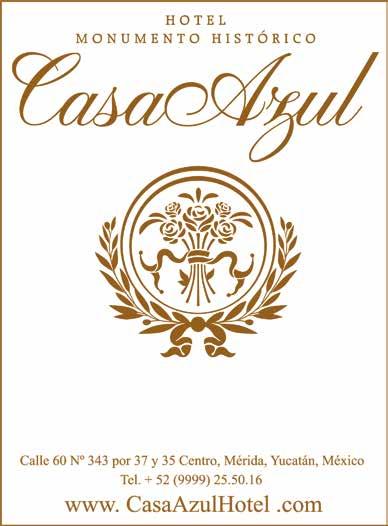


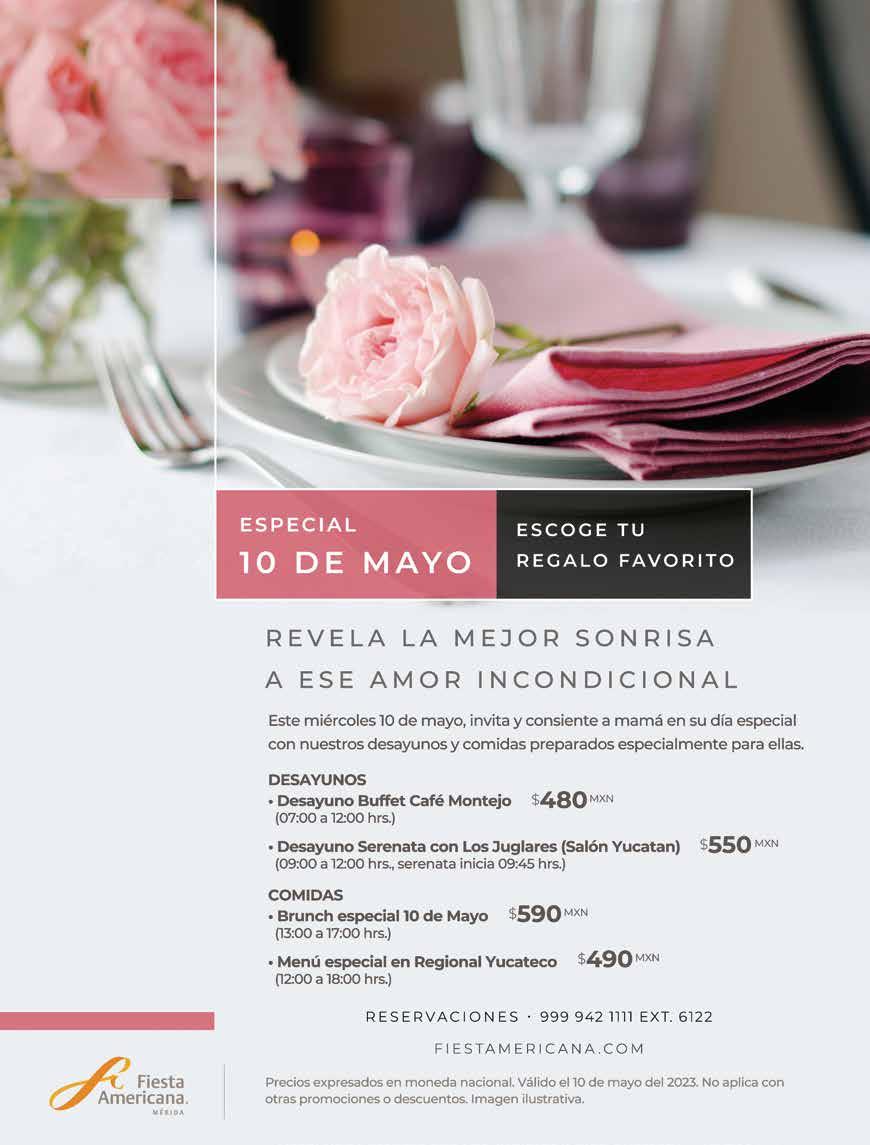
¿Vamos a desayunar? Siete opciones en Mérida
Up for Brunch? Here are a few options in Mérida

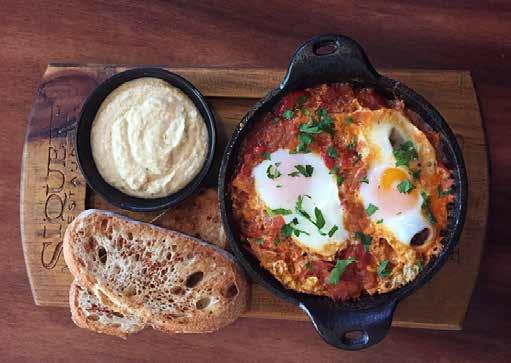
En mi opinión, no hay como iniciar el día con un buen café, un pan dulce fuera de este mundo y algún platillo que, por alguna razón, sabe todavía mejor antes del mediodía
What could possibly be better than a good breakfast? There’s nothing like starting the day with good coffee, pastries out of this world, and a dish that, for some reason, tastes even better before noon.
BACHOUR
Para ser justos, Bachour no se especializa únicamente en desayunos, pero no podríamos no mencionarlo. Su carrito de panes tiene 100 en presentación, y a partir de ahí sólo mejora. Sería fácil creer que panes tan bonitos y vistosos van a ser más facha-
SIQUEFF RESTAURANT
Quizá ya sepas que Siqueff inició originalmente en Motul, y que su fundador, don Jorge Siqueff, es considerado inventor de los famosos Huevos Motuleños. Aunque podría decirse que este platillo ya es del dominio público, Siqueff sigue siendo uno de los lugares con más tradición para disfrutarlos. Sin embargo, su amplio (y original) menú de desayunos tiene un sinfín de opciones para hacerte entrar en una crisis de decisión: los huevos árabes con kafta, por ejemplo, servidos con labne y pan árabe; o los huevos pochados con hummus (disponibles únicamente en la sucursal Centro), servidos sobre una cama de crema de pimiento; el omelette de berenjena; la Shakshuka… El problema será decidirte si no vas con alguien dispuesto a compartir. En la sucursal norte cuentan además con hot cakes, sándwiches y panadería de especialidad.
You may already know that Siqueff’s history began in Motul, and that its founder, Don Jorge Siqueff, is considered the inventor of the famous Huevos Motuleños. Although it could be said that this dish is already in the public domain, Siqueff continues to be one of the most traditional places to enjoy them. However, its extensive (and original) breakfast menu has endless options that could easily take you into paralysis by analysis: the Arabic eggs with Kafta, for example, served with Labneh and flatbreads; or the poached eggs with hummus (available only at the Centro restaurant), served with cream of bell peppers; the eggplant omelet; the Shakshuka... Your biggest problem will be deciding. Their restaurant at Plaza Luxury also offers pancakes, sandwiches, and specialty bakery.
Centro / Av. Andrés García Lavín
m 999 925 5027 / 999 406 3763 www.siqueffrestaurant.com E Siqueff Restaurant
da que sustancia, pero no por nada Antonio Bachour ha sido reconocido como el mejor repostero del mundo en más de una ocasión. Si te gustan los desayunos dulces, el French Toast es un sueño hecho realidad; si no, las opciones son amplias, pero no dejes de echarle un ojo a los huevos revueltos estilo español, y al sándwich cubano Bachour (apto para dos personas). Volviendo al carrito de panes de mis sueños (y seguramente de los tuyos), sospecho que es difícil elegir mal, pero el croissant de fresas y mascarpone realmente es único en su tipo.
To be fair, Bachour doesn’t specialize solely in breakfast, but I couldn’t not mention it in this article. Their pastry cart gets an A+ for looks, and it only gets better from there. It would be easy to believe that such beautiful and colorful pastries are going to be all style and little substance, but there’s a reason chef Antonio Bachour has been recognized as the best pas-
17 Eating in Yucatán
COMER EN YUCATÁN • EATING IN YUCATÁN
FOTO: ARIANNE OSALDE
FOTO: SIQUEFF
Siqueff
La Libertad
COMER EN YUCATÁN • EATING IN YUCATÁN
try chef in the world on more than one occasion. If you have a sweet tooth for breakfast, the French Toast is a dream come true; if not, you’ll have plenty to choose from, but be sure to check out the Spanish-style scrambled eggs, and the Bachour Cuban sandwich (suitable for two people). But back to the pastry cart of my dreams (and probably yours too): I suspect it’s hard to go wrong, but the Strawberry Mascarpone Croissant really is one of a kind.


Plaza City 32, Av. García Lavín
Q y E bachourmerida
I like to go and reminisce from time to time, accompanied by good coffee and a few Bolitas de Queso (cream cheese pastries). This brunch is the real deal: juices, fruit, and cereal, yes, but also house baked goods, a cold cut counter, an eggs station, regional dishes, chilaquiles, desserts... truly everything you need to treat yourself, and maybe some of your favorite people.
Hotel Fiesta Americana
Paseo Montejo #451 x Av. Colón, Centro m 999 942 1111 Q f.a.merida
ceive (and can explain) the difference between different roasts and origins, or who can tell if a latte is well made by the texture of the microbubbles in the milk foam. But you don’t need to be in this category to appreciate breakfast at Márago Coffee. Their Bailey’s French Toast has to be tasted to be believed, but the Márago Mix is a great way to eat a little of everything: scrambled eggs with chaya sauce and a chocolate-chip pancake.
Paseo de Montejo / Centro Q y E maragocoffee.mx
CAFÉ MONTEJO, FIESTA AMERICANA
A mi Chichí (abuelita) le encantaba salir a desayunar, y uno de sus lugares favoritos siempre fue Café Montejo, o, como ella le llamaba, “el buffet del Fiesta Americana”. Es así que tengo muchos lindos recuerdos de ese lugar, a donde me gusta ir y recordar de vez en cuando, acompañada de buen café y unas cuantas bolitas de queso. Este brunch es cosa seria: jugos, fruta y cereal, sí, pero también panadería de la casa, barra de carnes frías, estación de huevos al gusto, platillos regionales, chilaquiles, postres… todo lo que necesitas para darte un gusto, y quizá compartirlo con algunas de tus personas favoritas.
My Chichí (my grandma) loved to go out for breakfast, and one of her favorite places was always Café Montejo, or, as she called it, “the Fiesta Americana buffet”. That’s why I have so many beautiful memories of that place, where
MÁRAGO COFFEE
Hay de amantes del café a amantes del café Me refiero a aquellas personas que disfrutan probar distintos métodos de extracción, que perciben (y pueden explicar) la diferencia entre distintos tuestes y orígenes, o que pueden determinar si un latte está bien hecho por la textura de las microburbujas en la espuma de la leche. No necesitas pertenecer a estas categorías para disfrutar los desayunos de Márago Coffee, pero sí es una razón adicional. El French Toast de Bailey’s hay que probarlo para creerlo, pero el Márago Mix es una buena manera de comer un poco de todo: incluye huevos estrellados con salsa de chaya y un pancake (hot cake) de chispas de chocolate.
I know that many of us are coffee lovers, but I also know that there are people who are coffee lovers. I’m talking about people who enjoy trying different extraction methods, who per-
AL ALBA
Relativamente lejos de las zonas más turísticas de Mérida, sobre la Avenida Yucatán, se encuentra un rinconcito lleno de sorpresas; si eres desvergonzadamente fan del pan, como yo, te encantará descubrirlas. Quizá lo más visualmente impactante de su menú (además de su vitrina de panes) sean sus sándwiches, que te enamoran nada más verlos pasar, pero su Toast de Betabel, con arúgula y queso de cabra sobre pan de masa madre, es muestra de que algunas cosas son mucho más que la suma de sus partes. El favorito de la mesa: su croissant de limón con merengue y láminas de “oro”.
Relatively far from the most touristy areas of Mérida, on Avenida Yucatán, there is a little spot that could easily go unnoticed. However, let me tell you that Al Alba is full of surprises; if you’re an unashamed lover of bread, like me, you’ll be delighted to visit for your-

18
Comer en Yucatán
Merci
Café Montejo, Fiesta Americana
Márago Coffee
FOTO: MERCI
FOTO: COLOR NATIVO
FOTO: MÁRAGO COFFEE
self. Perhaps the most visually impressive section of its menu (in addition to its bread display) are its sandwiches, which will catch your eye on their way to other diners’ tables, but its Beet Toast (Toast de Betabel), with arugula and goat cheese on sourdough bread, is proof that some things are much more than the sum of their parts. My party’s top pick: the lemon croissant, with meringue and sheets of “gold”.
Av. Yucatán #351 x 40, Los Pinos
Q y E alalbamid
Cerrado los martes / Closed on Tuesdays
el menú a la carta. Ya sea en el interior del restaurante Casa de Piedra o en su maravillosa terraza con vista a los interminables jardines, árboles y aves, es una experiencia única para convertir tu domingo en una mini-vacación.
Now any Sunday can be a special occasion with a breakfast fit for kings at Hacienda Xcanatun by Angsana. Starting in March, their wonderful breakfast menu can be complemented with their buffet brunch every weekend. It’s true you can have a great break-
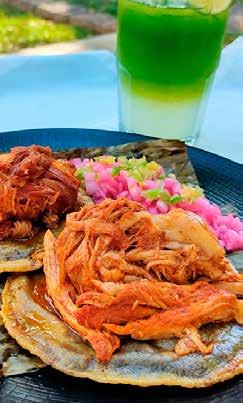
Este espacio no es suficiente para enlistar todos los lugares que ya probé y me encantan, y aquéllos a los que muero por ir y todavía no llego; por lo pronto, espero que esta lista te lleve a descubrir un lugar (o un platillo) que no conocías, y que, si sabes de un lugar igual de bueno que éstos, me lo compartas para agregarlo a mi lista.
Visita www.yuc.today/230418 para leer sobre Justo Bread Studio, Merci Homemade Food y La Libertad, y ver fotos adicionales de cada lugar.
CASA DE PIEDRA, XCANATUN
Ahora cualquier domingo puede ser una ocasión especial con un desayuno de reyes en la Hacienda Xcanatun by Angsana. Desde el mes de marzo, además de sus deliciosos desayunos a la carta, su buffet/brunch dominical ya está disponible todos los fines de semana. Sí, es verdad que puedes ir cualquier día de la semana a disfrutar de un delicioso desayuno de su menú (con clásicos regionales, internacionales y, desde luego, fusión), pero los domingos, además, tienes la posibilidad de agregar la barra de buffet, que incluye panes de especialidad, fruta, postres, y una barra caliente que incluye, entre otras cosas, quesadillas con tortillas hechas a mano, huevos al gusto, lechón al horno y cochinita pibil. Y sí, agregar, porque este brunch incluye también todo
fast at Casa de Piedra any day of the week, off a menu that includes regional, international, and fusion classics, but on Sundays, the buffet includes all the items on said menu, plus specialty pastries, fruit, dessert, and a line that includes quesadillas with handmade tortillas, eggs your way, Lechón al Horno, and Cochinita Pibil.
Whether you choose to sit inside the Hacienda halls, or at their marvelous terrace with a view of their breathtaking gardens, among trees and bird songs, this brunch experience is a great way to turn your Sunday into a mini-vacation.
Hacienda Xcanatun by Angsana Carr. Mérida - Progreso Km 12 Q xcanatuncasadepiedra Dom. / Sun. 9 am - 2 pm
The space I have for this article is definitely not enough to list all the places that I have already tried and love (like El Barrio and Artemia), and those that I am dying to but haven’t gotten the chance to (like Rosas & Xocolate or Luun). While I get the list to grow (check for updates on our website), I hope this unfinished version leads you to discover a place (or a dish) you didn’t know about. Now, finally, please, if having read this you think of a place that isn’t listed and which you believe I should try, by all means, share it with me so I can add it to my list.
Visit www.yuc.today/230419 to read about Justo Bread Studio, Merci Homemade Food, and La Libertad, and see additional pictures of each place.

19 Eating in Yucatán COMER EN YUCATÁN • EATING IN YUCATÁN
CAFÉ
ANUNCIANTES EN YUCATÁN TODAY •
ARE ADVERTISERS IN YUCATÁN TODAY
POR / BY ALICIA NAVARRETE A. Q atnavarrete
MONTEJO, SIQUEFF, ROSAS & XOCOLATE Y XCANATÚN SON
CAFÉ MONTEJO, SIQUEFF, ROSAS & XOCOLATE, AND XCANATÚN
Al Alba
Casa de Piedra, Xcanatún
FOTO: ATNAVARRETE
FOTO: HACIENDA XCANATÚN
Cervecería artesanal Thodes Brewery
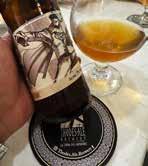
Esta multipremiada cervecería 100% yucateca celebra este mes su quinto aniversario con Thodes Fest, una serie de eventos, promociones y una cerveza NEIPA (New England India Pale Ale) conmemorativa de producción limitada.
Conoce su catálogo y el calendario de eventos en sus redes sociales: Q thodes.brewery
This multi-award-winning artisanal local brewery is celebrating its fifth anniversary with Thodes Fest, a series of events, special offers, and a commemmorative limited-edition New England IPA beer. Get to know the Yucatecan couple behind this microbrewery, their product lines, and the upcoming event calendar on their social media: Q thodes.brewery
Pago con tarjeta / Credit cards Terraza / Terrace Aire acondicionado / Air conditioned Mascotas bienvenidas / Pet-friendly Servicio a domicilio / Delivery Estacionamiento / Parking Bebidas alcohólicas / Alcoholic beverages Opciones vegetarianas / Veggie options Zona de niños / Kids zone Anunciante / Advertiser
Texas Roadhouse Frente a The Harbor / Caucel x Periférico, Mérida
Backyard 44 Calle. 44 #492 x 25, Col. Los Pinos, Mérida
Boston’s Pizza La Gran Plaza / Plaza Altabrisa / Caucel / Jacinto Canek
Hey Joe! Calle. 44 x 21 Diagonal y 23, Col. Los Pinos,Mérida
Lapa Lapa Altabrisa / Caucel / Dorada / Kukulcán
Orson Burgers Av. García Lavín / Plaza Kukulkán, Mérida
Truck Chef Av. Cámara de Comercio x 15, Montecristo, Mérida
Asai Hotel Villa Mercedes: Av. Colón #500 x Calle 60, Centro, Mérida
Bangkok Casa Thai Av. Yucatán #280 x 32 y 34, Col. La Florida, Mérida
Choga Seoul Calle 18 #101-B x Av. Correa Rachó, Frac. Del Arco, Mérida
Little India Calle 57 #529 x 64 y 66, Centro, Mérida
Wah Bao Calle 36 # 254-A x 73 y 75, Montes de Amé, Mérida
Café Kuun Fiesta Americana: Paseo de Montejo x Av. Colón, Mérida
Café La Habana Calle 62 x 59, Centro, Mérida
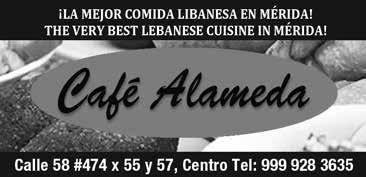
Café Montejo Fiesta Americana: Paseo de Montejo x Av. Colón, Mérida
Café Orgánico Calle 33-D #498 x Av. Reforma, Mérida

Domo Gelato Plaza Ateneum: Av. Andrés García Lavín x 27, Montebello
Ki’Xocolatl Calle 60 #471 Int. 5, Parque Santa Lucía, Centro, Mérida
Mansión Mérida Calle 59 #498 x 58 y 60, Centro, Mérida
Al Alba Av Yucatán #351 x 40, Col. Los Pinos, Mérida
Artemia Calle 39 # 140 px 26 y 28, Montes de Amé, Mérida
Cate de mi Corazón Calle. 47 #504-A x 60 y 62, Centro, Mérida
Estación 1888 Calle 20 x 11, Calotmul, Mérida
La Libertad Av. Andrés García Lavín #334 x 43, San Antonio Cucul, Mérida
Márago Coffee Paseo de Montejo #48 x 39 y 41, Centro, Mérida
Márago Coffee Calle 60 #491 x 57, Centro, Mérida

Menta y Rosa Paseo de Montejo #422 x 47, Centro, Mérida
Merci Paseo 60 / Plaza San Ángelo, Mérida
Bar La Hach Fiesta Americana: Paseo de Montejo x Av. Colón, Mérida
La Fundación Mezcalería Calle 59 #509 x 60 y 62, Centro, Mérida
La Negrita Calle 62 x 49, Centro, Mérida
Palmar Bar Tropique Calle 70 #476 x 57 y 59, Centro, Mérida
Salón Gallos Calle 63 #459-B x 50 y 52, Centro,Mérida
E Texas Roadhouse México
E Backyard 44
E Boston’s Mérida
Q heyjoe.mx
E Lapa Lapa
E ORSON Mérida
E Truck Chef
Q asai.merida
E Bangkok.mx Casa Thai
E Choga Seoul
E Little India MID
E Wah Bao
E Kuun by Nespresso FAMD
m. 999 928 6502
Q cafemontejofamd
E Cafe Organico de Merida
Q domogelato
E Ki Xocolatl
Q E Mansion Merida
Q alalbamid
E Artemia Restaurante
E Cate de mi Corazón
E Café Estación 1888
E La Libertad
E Márago Coffee
Q maragocoffee.mx
Q mentayrosa_cafe
E Merci
E Bar La Hach
E La Fundación Mezcalería
Q
E La Negrita Cantina
E Palmar Bar Tropique
Q salongallos
20 Comer en Yucatán
DÓNDE COMER • WHERE TO EAT
CAFÉ/BRUNCH • CAFÉ/BRUNCH AMERICANO • AMERICAN ESTE MES • THIS MONTH
CANTINAS • SNACK BARS
• ASIAN
ASIÁTICO
FOTO: RENÉE MORALES
Crabster Paseo 60 Paseo 60: Calle 60 x 35 y Av. Colón, Mérida
Crabster Progreso Malecón Tradicional de Progreso x 74 y 76, Progreso
Q crabstermx
Q crabstermx
Mobula Malecón Tradicional de Progreso x 74, Progreso Q mobulamx
Agua de Mar Calle 49 #502 x 60 y 62, Centro, Mérida
Almadía Malecón Tradicional de Progreso x 62 y 64, Progreso
Almar Marisquería Av. Industrias no contaminantes #501 x 71 y 73, Mérida
El Sazón de Calín Av. José Díaz Bolio #202 x 16, México Oriente, Mérida
La Pigua Av. Cupules x 62, Centro, Mérida
Muelle 8 Calle 21 #142 x 30 y 32, Buenavista, Mérida
Silver Fish Av. 19 #111 x 4, Montecristo, Mérida
BC66 Calle 66 x 43 #377, Centro, Mérida
E Agua de Mar Restaurante
E Almadía Mx
Q almar.marisqueria
E El sazón de Calin
Q lapiguamerida
E Muelle 8
Q silverfishmx
E Bistro Cultural
Lagos Taverna Griega The Harbor: Calle 60 x Periférico, Mérida Q lagostavernagriega
Pecatto Calle 60 #465 x 53, Centro, Mérida
m 999 750 3575
T’HŌ Aperitivo Casa T ‘HŌ: Paseo de Montejo x 45, Centro, Mérida Q thoaperitivo
Oliva Enoteca Calle 47 x 54, Centro, Mérida
Osteria Piccoli Calle 30 #112 x 23 y 25, Col. México, Mérida
La Bierhaus Calle 23 x 18, Col. México, Mérida
Spasso Cucina Italiana Hyatt Regency: Calle 60 x Av. Colón, Mérida
Bistrola 57 Calle 60 x 57, Centro, Mérida
Casa Chica Paseo de Montejo x 45 y 47, Centro
Maya de Asia The Harbor: Calle 60 x Periférico, Mérida
Paseo 60 Calle 60 x 35 y Av. Colón, Mérida
Rosas & Xocolate Paseo de Montejo #480 x 41, Centro, Mérida
Sanbravo Prol. Paseo de Montejo x 45, Benito Juárez Nte., Mérida
Yerba Santa Paseo de Montejo #473 x 35 y 37, Centro, Mérida
Anónima Av. José Díaz Bolio #66 x 10 y 12, Col. México, Mérida
Avec Amour Calle 60 #471 x 53 y 55, Parque Santa Lucía, Mérida
Bachour City 32: Av. García Lavín x Periférico, Mérida
Cuna Hotel Wayam: Av. Colón #508, García Ginerés, Mérida
Gran Lumière Calle 60 #453-A x 51, Centro, Mérida
Mercado 60 Calle 60 #461, Santa Lucía, Centro, Mérida
Café Alameda Calle 58 #474 x 55 y 57, Centro, Mérida
Siqueff Centro Calle 60 #350 x 35 y 37, Centro, Mérida
Siqueff Norte Plaza Luxury: Av. García Lavín x 27 y 29, Mérida
Habibi City 32: Av. García Lavín x Periférico, Mérida
Casa de Piedra Hacienda Xcanatún: Calle 20 S/N x 19 y 19-A, Mérida
Catrín Cocina Cantina Calle 47 #463-B x 52 y 54, Centro, Mérida

Chuc Calle 60 x 53, Centro, Mérida
Colonos Calle 58 #479 x 53 y 55, Santa Lucía, Centro, Mérida
Hda. Sotuta de Peón Poblado de Sotuta de Peón
Hacienda Teya Carretera a Cancún Km 12, Mérida
Hda. Teya Santa Lucía Calle 60 #468 x 53 y 55, Centro, Mérida
K’uxub Cocina de Arte Calle 42 #188-A x 33 y 35, Candelaria, Valladolid
La Casta Divina Calle 59 #513 x 62, Calle 59, Centro, Mérida
Los Almendros Fiesta Americana: Paseo de Montejo x Av. Colón, Mérida
Matilda Calle 63 #516 x 62 y 64, Centro, Mérida
Teya Viva Paseo 60: Calle 60 x 35 y Av. Colón,Mérida
María Raíz y Tierra Hotel Villa Mercedes: Av. Colón #500 x Calle 60, Mérida
Taquería Mixe Campestre / Altabrisa / Caucel / Las Américas / Kanasín
www.olivamerida.com
E Osteria Piccoli
E La Bierhaus
Q spassomid
E Bistrola 57
E Casa Chica
E Maya de Asia
E Paseo 60
E Rosas & Xocolate
E Sanbravo
Q yerbasantamerida
Q anonimamid
E Avec Amour - Merida
E Bachour Mérida
E Cuna Merida
E Gran Lumière
E Mercado 60
E Cafe Alameda
E Siqueff Restaurant
E Siqueff Norte
E Habibi México
E Hacienda Xcanatún
E Catrín
E Café Chuc
E Restaurantes Colonos
E Hacienda Sotuta de Peón
E Hacienda Teya
Q teyasantalucia
Q kuxub_restaurante
E La Casta Divina
Q losalmendrosfamd
E Matilda Salón Mexicano
Q teyaviva
Q mariaraizytierra
E Taqueria Mixe
21 Eating in Yucatán
DÓNDE COMER • WHERE TO EAT EUROPEO • EUROPEO FUSIÓN • FUSIÓN LIBANÉS • LEBANESE MEXICANA • MEXICANA DEL MAR • DEL MAR
COCINA YUCATECA
no de frijol en la tortilla. También se pueden pedir de Relleno Negro o carne asada.
Cochinita Pibil. Uno de los platos más conocidos de la cocina yucateca. Se elabora con carne de cerdo marinada en achiote y naranja agria, se envuelve en hojas de plátano y se hornea lentamente, o bien, enterrada al estilo yucateco. Se come en tacos, tortas o sola, acompañada de cebolla morada.

Poc Chuc. Filete de cerdo asado que se sirve acompañado de naranja agria, cebolla morada, chiltomate, aguacate y frijol colado. Es una gran opción si buscas un platillo más ligero en la gastronomía yucateca.
Papadzules. These tacos are filled with chopped hard-boiled egg and covered in two sauces: one is made with toasted pumpkin seed and the other is a tomato sauce. Ideal for vegetarians and omnivores alike.
A TRADITIONAL BREAKFAST
Huevos Motuleños. This dish consists of a tortilla with beans and fried eggs. Tomato sauce is added on top as well as chopped ham, cheese, and peas. It is usually adorned with fried plantains.
ICONIC DISHES
ucatán es hogar de una rica tradición gastronómica que combina ingredientes como el maíz, el tomate y el frijol, así como algunos propios de la región como el chile habanero, la naranja agria y el famoso achiote que da color y sabor a los platillos. Es reconocida internacionalmente por su riqueza cultural tradicional que mantiene la identidad maya, y por reunir influencias españolas y libanesas. Te presentamos algunos de sus platillos más representativos.
ENTRADAS CON SABOR
Sopa de Lima. Un exquisito caldo de pollo sazonado con lima de la región. Se sirve con pollo o pavo deshebrado, tiras de tortilla frita y rodajas de lima.
Papadzules. Tacos rellenos de huevo duro finamente picado, cubierto con salsa de pepita de calabaza molida y salsa de tomate.
EL DESAYUNO TRADICIONAL
Huevos Motuleños. Sobre una tostada con frijoles refritos negros se sirve un huevo frito o estrellado, cubierto con salsa de tomate, jamón en cubos, queso y chícharos y se adorna con plátano macho.
PLATILLOS ICÓNICOS
Salbutes y Panuchos. Tortilla fritas hecha a mano con pollo o pavo desmenuzado, lechuga, tomate, pepino, cebolla y aguacate. El Salbut es suave y el Panucho tiene relle-
Queso Relleno. Se prepara con queso de bola (holandés) relleno de carne molida de res y cerdo con almendras, pasas, chile dulce y especias de la región. Va cubierto con una salsa blanca (conocida como K’óol) a base de harina, manteca y caldo de pollo, y salsa de tomate.
Relleno Negro. Pavo sazonado con condimento hecho a base de chiles asados y especias que le dan un sabor ligeramente picante y el tradicional color negro. Se acompaña con un relleno de carne molida (llamado But) preparado con tomate y huevo picado. Posteriormente, se sirve el caldo con el pavo y una rebanada de But. Este platillo es uno de los más antiguos de nuestra gastronomía.
Lomitos de Valladolid. Lomo de cerdo en trozos preparado con una rica salsa de tomate ligeramente picante y aderezado con especias. Se sirve acompañado de huevo duro.
Para leer la versión completa visita: www.yuc.today/cocina-yucateca
Yucatán is home to a rich and traditional cuisine that mixes ingredients such as corn, tomato, and beans, with many unique local products such as Habanero pepper, bitter orange, and the annatto paste that gives color and flavor to many meals. Yucatecan food is also globally renowned for of its culturally rich traditions that bring together Maya, Spanish, and Lebanese influences. Here are a few of its most traditional offerings.
TASTY APPETIZERS
Sopa de Lima. A very flavorful chicken broth seasoned with local Yucatecan lime. It is served with shredded chicken or turkey, fried tortilla strips, and lime slices.
Salbutes and Panuchos. Fried, hand-made tortilla topped with shredded chicken or turkey, lettuce, tomato, cucumber, onion, and avocado. The difference between the two? A Salbut is soft and the Panucho is filled with beans. They’re now also available with toppings such as Cochinita Pibil, Relleno Negro, or Carne Asada.
Cochinita Pibil. One of Yucatán’s most famous dishes is this pork marinated in Achiote paste and sour orange juice. It’s then wrapped in banana leaves and baked either in a regular oven or Pib-style (underground). You eat it in tacos, Tortas, or by itself with red onion.
Poc Chuc. Roasted pork filet served with sour orange, red onion, a spicy chili and tomato sauce, and avocado. It’s accompanied by black beans. It’s a great choice if you’re looking for a somewhat lighter option while eating out in Yucatán.
Queso Relleno. Prepared with a hollowed-out Queso de Bola (Edam cheese), which is then filled with ground beef and pork, almonds, raisins, green pepper, and local spices. It’s covered in a white sauce known as K’ool made with flour, lard, and chicken broth, and finally it’s topped with tomato sauce.
Relleno Negro. This traditional turkey dish is seasoned with a spice blend made from charred chilies and herbs that give it a slightly spicy flavor and its emblematic black coloring. This dish is typically served at weddings and it’s one of the oldest recipes in our regional cuisine.
Lomitos de Valladolid. Diced pork loin prepared with a slightly spicy tomato sauce. It’s served with chopped hard-boiled eggs.
Visit www.yuc.today/yucatecan-cuisine to read the full version.
22 Comer en Yucatán
Y
TODAY
Panuchos
FOTO: YUCATÁN
ACERCA DE YUCATÁN • ABOUT YUCATÁN
l estado de Yucatán se encuentra poblado por aproximadamente dos millones de personas. Al suroeste colinda con el estado de Campeche, al sureste con el estado de Quintana Roo, y al norte con el Golfo de México. Sus principales industrias están relacionadas con la pesca, la producción de puerco y aves, la manufactura, el turismo y otros servicios.
Yucatán vio crecer la civilización maya, particularmente conocida por sus estudios avanzados de astronomía, matemáticas y medicina, además de la fundación de grandes ciudades que sobreviven hasta hoy.
Francisco de Montejo y León “El Mozo” fundó la ciudad de Mérida en 1542. Una vez que los españoles se instalaron, ejercieron en el estado una enorme influencia religiosa y cultural que duraría tres siglos.
En 1847, estalló la Guerra de Castas entre la población maya y la de origen español, la cual acaparaba el poder político y económico. Entre las causas de la insurrección figuraban las terribles condiciones laborales que se volvían más comunes, en gran parte debido a la creciente industria de henequén en Yucatán. Hacia el final del conflicto, Yucatán se consolidó como el principal productor de fibras del mundo, lo cual llevó a un tiempo de prosperidad económica en el estado.
La cultura yucateca de hoy es definitivamente mestiza: una mezcla de la maya y la española, que incluye a menor grado influencias como las de Francia, Cuba, Países Bajos, Corea y Líbano, lo cual puede verse particularmente en nuestra cocina regional y arquitectura.

La lengua maya aún se habla extensamente, con aproximadamente 520,000 hablantes nativos en el estado. El español que se habla en Yucatán frecuentemente emplea palabras de origen maya, tales como “tuch” (ombligo) o “xiix” (el resto de algo). Este dialecto tiene un gran significado en la identidad cultural de nuestra región.
Con el tiempo, la influencia de diferentes culturas y la belleza natural de la península
la han convertido en un destino que lo tiene todo. Camina por las calles de ciudades coloniales y pueblos mágicos; visita haciendas históricas; nada en las aguas cristalinas de nuestros cenotes, playas y ojos de agua; explora grutas misteriosas; mira a flamencos en su hábitat natural; baila al ritmo del bambuco, trova y bolero y disfruta deliciosa gastronomía con raíces precolombinas. ¡Ya queremos que conozcas nuestro estado!
he state of Yucatán is populated by approximately two million people and is bordered by the state of Campeche to the southwest, the state of Quintana Roo to the southeast, and the Gulf of México to the north. Its main industries are related to fishing, pork and poultry production, manufacturing, tourism, and other services.
Yucatán saw the rise of the Maya civilization, particularly well-known for its advanced studies in astronomy, math, and medicine (not to mention the founding of large cities).
Francisco de Montejo y León “El Mozo” founded the city of Mérida in 1542. Once the Spanish were settled, they wielded heavy religious and cultural influence throughout the region for three centuries.
In 1847, the “Guerra de Castas” broke out between the Mayas and the population of Spanish descent, which held the political and
economic power. Among the causes for the insurrection were the terrible working conditions, which were worsening in part due to Yucatán’s growing henequén industry. Towards the end of the conflict, Yucatán established itself as the world’s most important suppplier of natural fibers, which led to a time of economic prosperity in the state.
Today’s Yucatecan culture is definitely “Mestizo,” a mix of Spanish and Maya, and to a lesser degree other influences such as French, Cuban, Dutch, Korean, and Lebanese, which can particularly be seen in our regional cuisine and architecture.
The Maya language is still widely spoken by approximately 520,000 native speakers throughout the state, but even the Spanish spoken in Yucatán employs words of Maya origin such as “tuch” (bellybutton) and “xiix” (the last bit of something). Language holds enormous significance to the cultural identity of the region.
With time, the influence of different cultures and the natural beauty of the peninsula have created a destination which has it all. Walk through the streets of colonial cities and Pueblos Mágicos; visit historic haciendas; dive into the clear, blue waters of our cenotes, beaches, and natural springs; explore mysterious caves; see pink flamingos in their natural habitat; dance to the rhythm of bambuco, trova, and bolero; and eat mouthwatering food with pre-Columbian roots. We can’t wait for you to see our state.

23
E
T
FOTO: ATNAVARRETE
Hacienda San Francisco Tzacalhá
Where To Go and How!
érida se ubica en el noroeste de Yucatán y es la capital del estado. Con cerca de un millón de habitantes en su área metropolitana, también es la ciudad más poblada de la Península y una de las ciudades con mayor crecimiento en todo México. Puede que esto te sorprenda, porque cuando nos visites verás que Mérida mantiene las tradiciones, las costumbres y el encanto que pocas ciudades modernas pueden presumir.

La ciudad fue fundada en 1542 por Francisco de Montejo “El Mozo” sobre los restos de la ciudad maya T’hó. Fue Montejo quien la bautizó como Mérida, por su ciudad natal en España. Estas raíces mayas y coloniales están aún muy visibles en muchos de los edificios del Centro Histórico al día de hoy. Incluso se pueden llegar a observar en un mismo edificio, como es el caso de la Catedral de San Ildefonso, una construcción colonial con glifos mayas claramente visibles.
Las principales áreas de interés para los visitantes suelen ser el Centro Histórico y Paseo
de Montejo. Estos son ideales para explorar por la mañana y tarde gracias a los tradicionales barrios y mercados, espléndidas casonas, así como museos y monumentos históricos. Pero no te equivoques, también de noche están llenos de vida, gracias a que en años recientes se han establecido numerosos restaurantes y bares modernos que mantienen vibrantes al Centro y Montejo a todas horas.
Nuestro clima tropical, arquitectura, calidez humana, proximidad a la playa y formaciones geológicas impresionantes, como cenotes y grutas, han enamorado a más de uno que ha “tomado agua de pozo”, un dicho local para aquellos visitantes que terminan quedándose para siempre. Esto ha ocasionado que la ciudad tenga una influencia más internacional, incluyendo nuevas y diversas ofertas gastronómicas.
Esperamos que disfrutes nuestros museos, recorridos, actividades culturales gratuitas disponibles todas las noches de la semana, centros comerciales grandes y pequeños, tiendas de artesanías y, sobre todo, los deliciosos sabores de nuestra comida regional y nacional. Cuando estés satisfecho, sabemos que seguirás gozando tu aventura al descubrir el resto de nuestro estado. ¡Bienvenido a Mérida!
érida is located in the northwestern part of Yucatán and is the capital of the state. With close to one million residents in the metropolitan area (accounting for roughly half of the state’s population), it is also the most populated city in the Yucatán Península, and one of the fastest growing cities in México. You might be surprised by this, because once you’ve visited our city, you’ll see that it maintains the traditions, customs, and old-city charm that few cities can boast.
It was founded in 1542 by Francisco de Montejo “El Mozo,” on the remains of the Maya city of T’hó, and was named Mérida after his own hometown in Spain. These Maya and colonial roots are still very visible in the buildings of the Centro Histórico today. Sometimes, you can even see both represented in the same building, such as on the Catedral de San Ildefonso which is a colonial construction; if you look very closely, you will see Maya glyphs etched on the stones of the building.
The main areas of interest for visitors are usually the Centro Histórico and Paseo de Montejo. Here, we find the traditional city “barrios” and markets, grandiose homes, several museums, and historical monuments, which make them ideal for exploring in the morning and afternoon. But don’t be fooled, these areas are equally lively in the evenings, as in recent years they have seen the birth of many modern restaurants, entertainment venues, and bars which keep Centro and Montejo buzzing throughout the whole day.

Our tropical climate, architecture, warm people, proximity to the beach, and impressive geological formations such as cenotes and caves have enamored more than one visitor who “tomó agua de pozo”—or “drank from the well,” a local saying of visitors who wind up staying forever. This has caused the city to have an increasingly international fame which includes a growing renowned and diverse food scene.
We hope you enjoy our museums, city tours, free cultural activities available every night of the week, shopping centers both big and small, handcraft shops, parks, friendly locals, and especially, the delicious flavors of our regional and national cuisine. When you’ve had your fill, we expect you’ll continue to enjoy your time adventuring through the rest of our state. Welcome to Mérida!
24 ACERCA DE MÉRIDA • ABOUT MÉRIDA
M
FOTO: OLIVIA CAMARENA CERVERA
M
¡Dónde ir y Cómo!
El Pinar
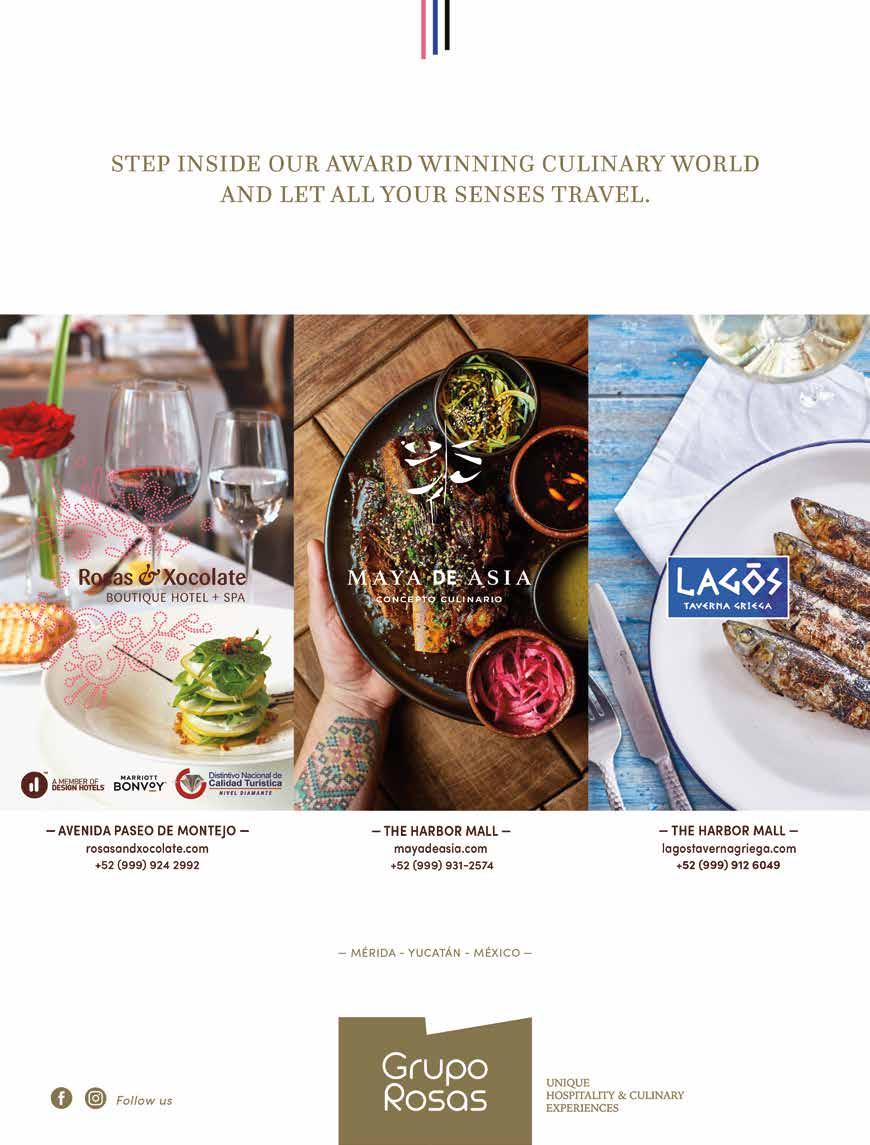
¡110 Años!
Breve Historia de la Residencia
Ernesto y María Cámara Zavala en 1904 le comisionaron al afamado y premiado arquitecto francés Gustave Umbdenstock los planos originales.
En 1964, Fernando Barbachano Gómez Rul adquiere la residencia y con su esposa e hijos hacen de ésta su hogar. La familia Barbachano Herrero la ha vivido ininterrumpidamente hasta el día de hoy.
Construida como la residencia más moderna de su época, Montejo 495, Casa Museo no ha tenido modi caciones ni en su estructura, ni en su estilo; la decoración es original de principios del siglo XX; conserva los muebles de manufactura Francesa, comisionados a los mas renombrados ebanistas de París; sus premiadas lamparas de Baccarat; sus cuadros y esculturas re ejan el exquisito diseño Art Nouveaux muy apreciado en Yucatán durante el auge henequenero.

Más allá de la larga lista de personalidades que han convivido con la familia Barbachano. Montejo495, Casa Museo, es un hogar que re eja en cada rincón la historia de esta afamada familia pionera de la industria turística en México.

Visitas Guiadas - Guided Visits Martes a Domingo de 9 am a 5 pm 999 924 0037 • 999 995 6761 • montejo495 Paseo de Montejo 495, Esquina 45, Centro, Mérida de Yucatán, México 97000 www.montejo495.com
Monumento Histórico de México y Patrimonio Cultural de Francia en el Exterior
Hoy en día, lo que conocemos como “el centro” de Mérida abarca una superficie de unos 10 kilómetros cuadrados; sin embargo, durante mucho tiempo, ésta fue la extensión total de la ciudad. El centro era, básicamente, la Plaza Grande, y todo a su alrededor, los barrios residenciales, distribuidos alrededor de sus respectivas iglesias.
Actualmente, el centro de Mérida se divide en ocho barrios, muy distintos a las colonias que se encuentran fuera de él. Hay muchos motivos para amar los barrios: su arquitectura, monumentos históricos, dinámica vida cotidiana, diversidad gastronómica. En la página 27 te hablaremos de Santa Lucía, y aquí, sobre San Sebastián, La Ermita y San Juan. Para saber sobre los cuatro restantes (Santa Ana, Santiago, Mejorada y San Cristóbal) continúa leyendo en nuestro sitio web.

San Sebastián (Calle 70 x 75): Es uno de los más antiguos y de mayor tradición en Mérida, y sigue siendo residencial. Cuenta con un diverso mercado; su iglesia está dedicada a la Virgen de la Asunción. Cada agosto se realizan peregrinaciones y gremios en honor de la Santa Patrona. Tiene valor gastronómico inigualable al ser la cuna del panucho y la sede del Festival del Pib, delicia yucateca que se realiza para el Día de Muertos.
La Ermita (Calle 66 x 79): La Ermita de Santa Isabel se encuentra en el corazón del que podría ser el barrio más singular de los ocho. En la plaza se encuentra un kiosco que acompaña a la iglesia, y que está rodeado por muy lindo jardín con bancas, enmarcado por hermosas casonas de estilo colonial; las calles de adoquín y su particular trazo, evocan la historia de la Ermita como el límite de la ciudad y última parada antes de salir al Camino Real a Campeche.
San Juan (Calle 64 x 69): La iglesia alrededor de la cual se asienta este barrio fue construida por ahí de 1770; la plaza que se encuentra frente al templo se estableció en 1883. Fue poco después que la plaza se fue adornando, por ejemplo, con la fuente de “La Negrita”, que hasta hoy podemos ver y que fue traída de París a principios del siglo XX. En este barrio encontrarás la mayoría de los sitios de taxis que salen de Mérida.
Conoce los demás barrios: www.yuc.today/barrios-merida
NO TE LO PIERDAS
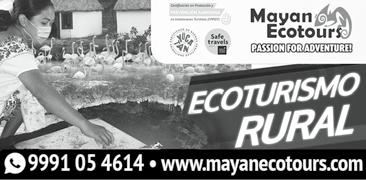
San Sebastián Panuchos frente al parque El campo de softbol
La Ermita
El jardín a un costado de la iglesia Marquesitas en el parque
San Juan
El monumento a Benito Juárez, erigido en 1909 La fuente de “La Negrita”
The area we currently know as “Centro,” the city’s historical center, covers about 4 square miles; however, for a long time, that was the extension of the entire city. The center back then was the main square, and everything around it, the city’s Barrios or neighborhoods.
So now we consider the Centro to be divided into eight Barrios, very different in name and concept to the Colonias (also neighborhoods) that make up the city today. There are plenty of reasons to love our Mérida’s Barrios: their architecture, historical monuments, their food— you take your pick. You’ll read about Santa
Lucía on page 27; in this issue, we’ll be telling you about San Sebastián, La Ermita, and San Juan. To learn about the other four (Santa Ana, Santiago, Mejorada, and San Cristóbal), visit the link at the end of this page.

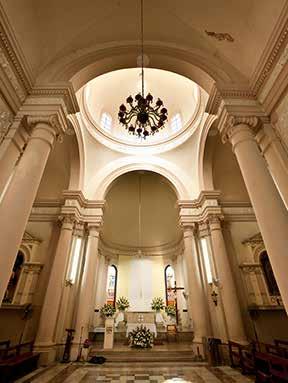
San Sebastián (Calle 70 x 75): One of the oldest, most traditional Barrios in Mérida. It features a very diverse market, and a church devoted to Our Lady of the Assumption. Every year, in August, there are regional parades in her honor. Plus, it offers amazing gastronomic value, as it is the birthplace of Panuchos and home of the Festival del Pib, a Yucatecan delicacy made for Janal Pixan (our Día de Muertos).
La Ermita (C. 66 x 79): An Ermita refers to a somewhat remote religious temple, where there aren’t regular services as it is usually on the outskirts of a community. This one is devoted to Saint Elizabeth. The square across the church features a lovely gazebo, and a garden with benches, surrounded by colonial-style homes. The stone-lined streets and their peculiar layout evoke the history of the Ermita as being beyond the city limits, the last stop for travelers taking the Camino Real (royal road) to Campeche.
San Juan (Calle 64 x 69): The church in this Barrio was built around 1770; the square across from it was established in 1883. It was from then on that the beautification of the area began, like“La Negrita” fountain we can see to this day, which was brought from Paris in the early 20th century. This Barrio is where you’ll find most of the public transportation vans going from Mérida to most towns in the state.
Visit www.yuc.today/meridas-barrios to learn about more Barrios.
NOT TO MISS
San Sebastián Panuchos by the park The softball field
La Ermita
The garden by the church Marquesitas at the park
San Juan
The monument to Benito Juárez, built in 1909 The “La Negrita” fountain
26 ¡Dónde ir y Cómo!
LOS BARRIOS DEL CENTRO DE MÉRIDA • THE BARRIOS IN MÉRIDA’S CENTRO
FOTO: GOBIERNO DEL ESTADO
San Sebastián
l Barrio de Santa Lucía se ha convertido en una de las zonas favoritas del Centro Histórico. Tiene un pasado lleno de historia y vida gracias a que es una de las áreas más antiguas de la ciudad.
Entre los principales atractivos del barrio están la iglesia y el parque (ambos ubicados en Calle 60 x 55). Los inicios de esta área remontan a 1565, tan sólo unos años después de la fundación de Mérida. Lo que ahora conocemos como Santa Lucía empezó únicamente como una ermita y plazuela para los servicios religiosos de los esclavos y fungió así por varios años. Fue hasta 1804 que se construyó la agradable plaza que conocemos hoy en día y que se fue modificando a lo largo de los años.
La amplia gama gastronómica de la zona incluye restaurantes ubicados dentro de los arcos del parque y en las calles aledañas. Podrás disfrutar desde modestos esquites y marquesitas en puestos ambulantes, hasta sofisticados platillos inspirados en sabores mexicanos e internacionales.
Aprovecha caminar por las calles del barrio para contemplar arquitectura colonial, hoteles boutique e irresistibles tiendas para comprar el regalo ideal; una excelente opción es Between the Lines, en Plaza Carmesí, donde encontrarás libros, papelería y mucho más (Calle 62 x 53). Si sientes mucho calor, encontrarás opciones de helados y frappés para refrescarte mientras te sientas en alguna de las bancas o te tomas una foto en la Sillas Confidentes gigantes del parque y disfrutas de sus áreas verdes que dan un ambiente muy tropical.
Si coincides con este parque un jueves por la noche, quédate a la Serenata a disfrutar la música y los bailes que han sido tradicionales de esta sede desde 1965. Si visitas
un domingo por la mañana, deléitate con los mejores pasos de baile de nuestros residentes y únete a ellos si lo deseas. También puedes visitar el mercado que se instala ahí en este día o la clásica Biciruta que pasa por la calle 60.

Vístete fresco y disfruta uno de los barrios más queridos y tradicionales de la Ciudad.
NO TE LO PIERDAS / WHAT TO SEE
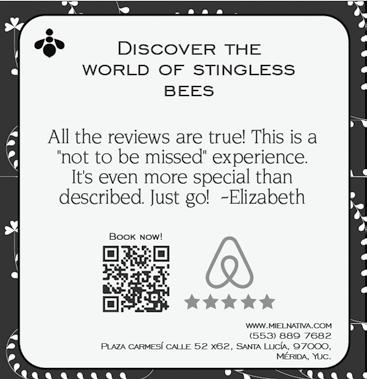
La Serenata, jueves 9 pm.
· Restaurantes bellos.
· Tiendas boutique y de artesanías.
· Una foto en las “Sillas Confidentes” gigantes.
· The Serenata, Thursdays 9 pm.
· Charming restaurants.
· Boutiques and handcraft shops.
· A selfie in the giant “Confidente” chairs.
Today, Santa Lucía has become one of the Centro Histórico’s favorite areas, but it also has a past that’s full of history because it’s one of the city’s oldest neighborhoods.
Amongst Santa Lucía’s main attractions are the church and the park (both located on Calle 60 x 55). This area’s beginnings go way back to 1565, just a few years after the founding of the city of Mérida. What we now know as Santa Lucía started out just as a shrine for slaves to hold their religious services, and it continued this way for many years. The pleasant plaza we know today wasn’t built until 1804 and has been modified throughout the years.
The zone’s culinary offering includes restaurants that are located both in the archways of the park and on nearby streets. You can enjoy everything from modest Esquites and Marquesitas served by food carts, to sophisticated dishes inspired by Mexican and international flavors.

Walk down the streets of Santa Lucía and gaze at colonial architecture, boutique hotels, and

irresistible stores to pick up the perfect souvenir; among them stands out Between the Lines, where you’ll find books, stationery and more (Calle 62 x 53). If you’re feeling particularly hot, you’ll find refreshing ice creams and frappés that will help you cool off while you sit on one of the park benches, snap a picture in the giant Confidente chairs, or just wander around enjoying the green gardens and tropical ambiance.
If you’re around on a Thursday evening, stay for the Serenata and enjoy the traditional shows that has been held each week since 1965, and which combines traditional Trova singers with Jarana dancers, and other performances. If you’re at the park on a Sunday morning, you’ll also have plenty to see and do. Check out some sweet dance moves and join in if you’d like. You can also visit the market that sets up there or the classic Biciruta that runs up Calle 60.
Dress nice and cool, and enjoy one of Mérida’s most beloved Barrios.
27 Where To Go and How!
SANTA LUCÍA FOTO: GOBIERNO DEL ESTADO
Santa Lucía
no de los lugares más icónicos de la ciudad de Mérida es el espléndido Paseo de Montejo que es sin duda no sólo la más bella avenida de nuestro estado, sino también la más importante. Gracias a los frondosos árboles, así como diversos hoteles, cafés y restaurantes que delinean la avenida, es conocida como “los Campos Elíseos” de Mérida.
El majestuoso boulevard fue inaugurado en 1888 para conmemorar al fundador de la ciudad de Mérida, Francisco de Montejo y León, justo en el marco del “oro verde”, una época de gran prosperidad económica debido a la producción del henequén en el estado, que era exportado a todo el mundo. Esta riqueza sin precedentes vio nacer las majestuosas casonas y mansiones que aún son puntos de referencia de Paseo de Montejo tales como Montejo 495, El Minaret y el Palacio Cantón, hogar del Museo de Antropología e Historia. Con el tiempo, muchas de las mansiones de esta avenida fueron abandonadas para dar lugar a bancos, compañías de seguros y otros negocios en su lugar.
La mejor forma de recorrer esta avenida es caminando bajo la sombra de sus árboles. Empieza por El Remate del Paseo de Montejo (por la Calle 47) y dirígete hacia el norte. Pasarás llamativos restaurantes, glorietas con historias especiales, simpáticos cafés, irresistibles tiendas, y bares acogedores. Llega al Monumento a la Patria y regresa por el otro lado de la avenida para ver lo que se ha instalado ahí con el tiempo.
Caminar por esta avenida es un nostálgico viaje al pasado de Yucatán; pero no hay que olvidar que también es parte de su vibrante presente. Una gran variedad de actividades culturales se presentan aquí cada semana, tal como la Noche Mexicana cada
sábado a partir de las 8 pm en el Remate y la Biciruta y Corredor de Arte todos los domingos a partir de las 8 am. El Mercado de Santa Ana, justo al lado del Remate es algo que no puede faltar en tu lista para una experiencia gastronómica yucateca.
ne of the most iconic places in the city of Mérida is Paseo de Montejo, which is the most beautiful and important avenue in our state. Thanks to the lush tropical vegetation and trees, along with many hotels, cafés, and restaurants that line the streets, it’s known as the “Champs Elysées” of Mérida.
This majestic boulevard was inaugurated in 1888 to commemorate the city’s founder, Francisco de Montejo y León, and was built in the midst of the “green gold,” an era of great economic prosperity due to the production of henequén in the state, which was exported to countries around the world to make rope and textiles. This unprecedented wealth saw the birth of grand mansions and residences which are still landmarks of Paseo de Montejo today, including Montejo 495, El Minaret, and the Palacio Cantón, which is also home to our Anthropology and History Museum.
¿YA SABÍAS? / DID YOU KNOW?
Fue construido en 1888 para celebrar la fundación de Mérida.

Inicia en la Calle 49 y termina en el Monumento a la Patria.
¡También tiene mucha cultura! Existen increíbles museos por descubrir: Montejo 495, la Casa Museo Montes Molina, El Minaret y el Palacio Cantón.
It was built in 1888 to celebrate the founding of Mérida.
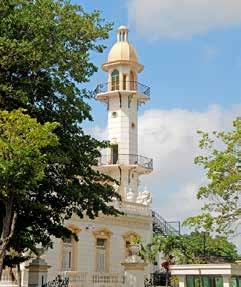
It begins at Calle 49 and ends at the Monumento a la Patria.
It’s also full of culture! There are incredible museums to discover: Montejo 495, Casa Museo Montes Molina, El Minaret, and Palacio Cantón.
With time, many of the mansions of this avenue were abandoned, and in their stead, banks, insurance companies, and other businesses set up shop.
The best way to explore this promenade is by walking under the shade of its lush and abundanttrees. Start at El Remate de Paseo de Montejo (the beginning, at Calle 47) and take a stroll up one side of the avenue. You will pass both traditional and modern restaurants, roundabouts with fascinating stories behind them, cute cafés, irresistible stores, and cozy bars. Once you reach the Monumento a la Patria, snap a picture, and then walk back south on the other side of the street.
Walking down Paseo de Montejo is a nostalgic trip to Yucatán’s past, but one mustn’t forget that it’s also a part of its vibrant present. Different cultural activities take place here each week, such as the Noche Mexicana, which happens every Saturday at El Remate at 8 pm, as well as the Biciruta and Art Corridor, which you can find every Sunday morning starting at 8 am. The Santa Ana Market, right next to El Remate, is also something that has to go on your list for a very foodie experience.
28 ¡Dónde ir y Cómo!
U O
PASEO DE MONTEJO
FOTO: JUAN MANUEL MIER Y TERÁN C.
Paseo de Montejo - El Minaret

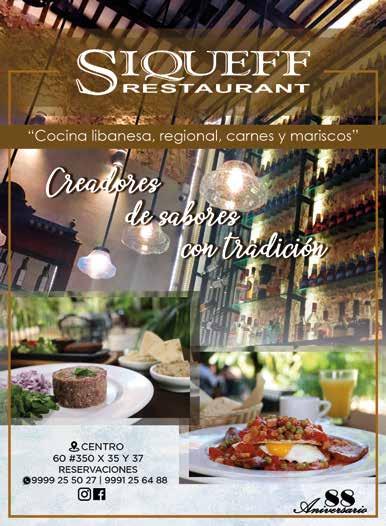
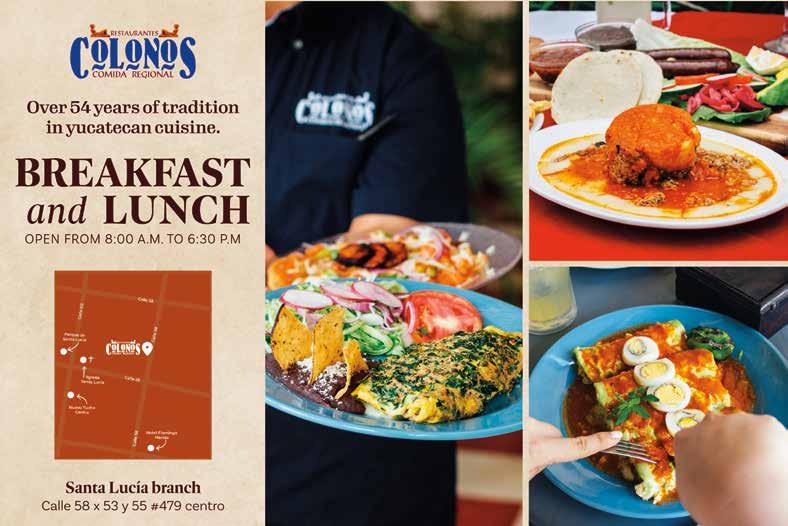





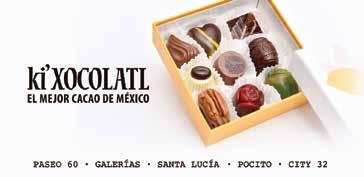
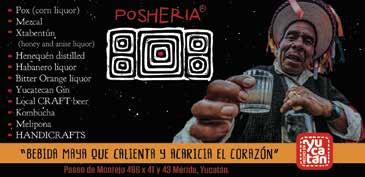

Colonia Centro Fraccionamiento del Norte Colonia Jesús Carranza Colonia Itzimná Colonia México Colonia Yucatán Colonia Buenavista Colonia Pedregales de Tanlum Colonia Campestre Colonia Chuburná Av. Colón Av.Cupules Av. José Díaz Bolio Calle 60 Av. Alemán Circuito Colonias Circuito Colonias AvenidaCampestre Av.Reforma PaseodeMontejo Av.PérezPonce PASEO COLEGIO ROGER’S HALL SANJUANISTAS COLEGIO MÉRIDA LA PLANCHA (Art.123) Ferrocarriles MONUMENTO A LA PATRIA CIC CENTRO INTERNACIONAL DE CONGRESOS DE YUCATÁN ESTADIO SALVADOR ALVARADO TELMEX REMATE DE PASEO DE MONTEJO SANTA ANA ESAY SANTA LUCÍA ITZIMNÁ MÉXICO INM - INSTITUTO NACIONAL MIGRACIÓNDE Calle 47 Calle 45 Calle 43 Calle 43 Calle 35 Calle 51 Calle 55 Calle54 Calle50 Calle54 Calle46 Calle 42 Calle 64 Calle52 Calle56 Calle 33-A Calle 49 Calle 53 Calle 37 Calle 37 Calle44 Calle48 Calle 66 Calle 39 Calle60 Calle56 Calle62 Calle62 Calle58 Calle 41 Calle 41 Calle 33-B Calle62-A Calle 39 Calle 21 Calle20 Calle15 Calle33 Calle20 Calle 37 Calle 27 Calle36 Calle40 Calle 35 Calle20 Calle 21 Calle 21-A Calle 19 Calle7 Calle 13 Calle 35 Calle 60 Calle22Calle20 Calle Walmart Plaza de Toros Dr. Javier Cámara SoHo Galleries Centro de Artes Visuales Agustín Galería Las Cruces Consulado EUA Yaaxtal Trotter’s Super Akí Palacio Cantón Montejo 495 Rosas & Xocolate El Minaret Fiesta Americana Villa Mercedes Paseo 60 CEM CMA La Negrita Café La Habana La Mezca BC66 Casa Ki’ool · Between the Lines · Miel Nativa Café Alameda Artesanaria Casa Museo Poshería Hostik Hostal Cada día Bar-Café Ábito Café Kuun Café Montejo Los Almendros Yucatán Giving Outreach Bistrola 57 Teya MET Muebles en Tránsito Soriana Burger King Casa T’HŌ · Café Orgánico · Mercado Slow Food Casa Consciente CENTRO PAG. 20 Siqueff Catrín Colonos Casa Azul El Pinar Pan Montejo Ábito Crabster Ki’Xocolatl Teya Viva · María Maíz y Tierra · Asai Centro Comercial Colón Mexico International Real Estate Office Depot Galería Lux Perpetua Mansión Mérida Hamaka Professional Co. Hosting Casa Chica Mex Law
PASEO DE MONTEJO Y PROLONGACIÓN
Colonia Chuburná de Hidalgo
Colonia Gonzalo Guerrero
Colonia Juan B. Sosa
Colonia Xcumpich
Colonia Cordemex




Colonia Sodzil Norte
Colonia Campestre


Colonia Villas La Hacienda
Colonia Benito Juárez Norte
Colonia Montes de Amé
Colonia San Ramón Norte

Calle 60 Calle 9
Cámara de Comercio
Av. Temozón
a Progreso
ProlongaciónMontejo
o c i r é f i r e P
Carretera
COSTCO CLUB CAMPESTRE DE YUCATÁN INSTITUTO TECNOLÓGICO DE MÉRIDA CENTRO DE CONVENCIONES SIGLO XXI GRAN MUSEO DEL MUNDO MAYA DE MÉRIDA SECRETARÍA DE SEGURIDAD PUBLICA UNIVERSIDAD MARISTA Centro Universitario Montejo DECATHLON INAH SAT SAM’S CLUB HOME DEPOT CHEDRAUI SELECTO LA GRAN PLAZA Calle 42 Calle 39 Calle 38 Calle 21 Calle 5B Calle 42 Calle 17 9 6 e l l a Calle 71 Calle 33 Calle 31 Calle 40 Calle 23 Calle 21 5 7 Calle 75 Calle20 CalleCalle1H 3 Calle1GCalle1FCalle1ECalle1D Calle 36C Calle 36D Calle 14 Calle 12 Calle 16 Calle 79 Uxmal & Ruta Puuc Aeropuerto Celestún Campeche Río Largartos Izamal Valladolid Cancún C PLAZA GALERÍAS Texas Roadhouse 261 Dupuis Yucatán Country Club Hacienda Xcanatún by Angsana Foro GNP Plaza La Ceiba Club de Golf La Ceiba Dzibilchaltún Progreso Bayside Real Estate Telchac Puerto Sanbravo Starbucks HolidayExpressInn · Ábito · Ki’Xocolatl THE HARBOR · Lagos Taverna Griega · Maya de Asia · Secretaría de Relaciones Exteriores Hampton Inn Walmart Express Espacio Quiropráctico Francés PROFESSIONAL BUYER & SELLER REPRESENTATION Visit us at our office located on the Malecon, beside Barloventos! MX 999.418.4827 info@BaysideYucatan.com
RESTAURANTE YA’AXCHE

Hosted by Chef Wilson Alonzo
 Halachó, Yucatán
Halachó, Yucatán
l clima tropical, el estilo de vida relajado y las calles seguras de Mérida la han convertido en una de las ciudades de más rápido crecimiento en el país. El Centro Histórico siempre será el lugar de museos, galerías, eventos culturales y la hermosa arquitectura colonial. Sin embargo, se ha visto un fuerte crecimiento en los alrededores de la ciudad; entre los más significativos, en el norte de Mérida.
Esto se está reflejando sobre todo en la incorporación de poblaciones ubicadas al norte de Mérida que antes se consideraban pueblos independientes, como ha ocurrido con Dzityá, Temozón Norte, Cholul y Conkal. Esto significa que hay una amplia variedad de inmuebles nuevos en esta zona; la oferta incluye departamentos, condominios, casas y townhouses con todo tipo de amenidades, y que además se encuentran cerca de importantes centros educativos, comercios y servicios de salud.
Tanto el norte como el centro ofrecen todo tipo de comercios nacionales e internacionales, incluyendo una amplia variedad de restaurantes, tiendas y muchos otros productos y servicios. Una importante diferencia entre la vida en estas zonas es la accesibilidad peatonal: el norte está hecho para ser experimentado en auto, y las opciones de transporte público son algo limitadas.
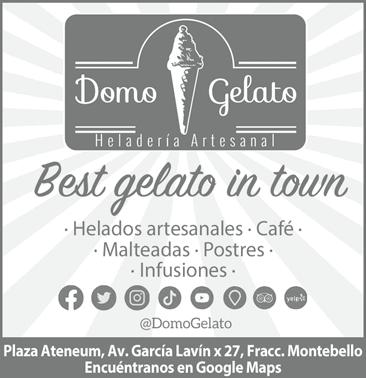
Sin embargo, el norte de Mérida destaca por su amplia oferta de productos y servicios, especialmente dentro de plazas comerciales de lujo. Éstas ofrecen (además de tiendas, restaurantes y supermercados) eventos para niños y mascotas, opciones de entretenimiento que van desde salas de cine hasta auditorios para conciertos, e incluso actividades como tirolesa, kneeboarding o patinaje sobre hielo (¡imagínate eso en Yucatán!).
The tropical climate, laid-back lifestyle, and safe streets of Mérida have made it one of the fastest-growing cities in México. The Centro Histórico will always be the place for museums, galleries, cultural events, and beautiful colonial architecture. However, there has been significant growth in the suburbs, and especially in the north of Mérida.
This is especially evident as areas that used to be considered independent villages, such as Dzityá, Temozón Norte, Cholul, and Conkal, are now part of the city. This has created a wide array of new real estate offerings in the area, including apartments, condos, houses and townhouses with all sorts of amenities, all boasting their closeness to the most important educational, shopping, and healthcare centers.
ized stores, shopping malls, and many other products and services. An important difference between life in Centro and Norte is that, in the latter, it’s much harder to get by without a car; distances are longer, and public transportation options are limited.
In north Mérida, you can definitely find all kinds of national and international businesses, including a wide range of restaurants, special-
Still, north Mérida stands out for the many products and services it offers, especially within luxury shopping malls. These offer (in addition to all kinds of stores, dining options from food courts to high-end restaurants, and supermarkets), events geared at children and pets, entertainment options ranging from multiplexes to concert halls, and even activities like ziplining, kneeboarding, or ice skating (in Yucatán? Who’d have thought?).
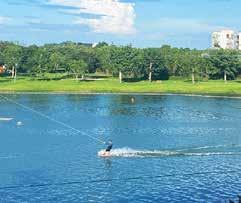
30 ¡Dónde ir y Cómo!
MÉRIDA NORTE • NORTH MÉRIDA
E FOTO: YUCATÁN TODAY
Ábito LOMA BONITA XCUMPICH CAMPESTRE CHUBURNÁ SAN RAMÓN NORTE SANTA GERTRUDIS COPÓ BENITO JUÁREZ NORTE SOL CAMPESTRE CORDEMEX MONTECARLO MÉXICO NORTE MONTEALBÁN MONTEVIDEO VILLAS LA HACIENDA Tecnológico Calle 17 Calle 17 Calle 40 Calle 21 Calle 38 Calle 42 Calle 19 Calle 22 Calle 19 Calle23 Calle 10 Calle 23 Calle 71 Calle33 Calle 39 Prol.Montejo ShutánMedina Campestre Calle 9 Calle 5 Calle18 Calle 33 Periférico Periférico Calle23 Calle36Diagonal Andrés García Lavín PASEO DE MONTEJO CENTRALES SALIDA Progreso 36 km Hacienda Xcanatun 3 km Dupuis A 6 3 e l l a C Av.Dr.Fdo.Dájer CámaradeComercio Av. Líbano Calle 20 • CENTERFOLD Gran Plaza Sam’s Club Plaza Galerías Chedraui Costco Gran Museo del Mundo Maya Mangus City 32 Faro del Mayab La Isla Cabo Norte City Center Victory Platz Town Square Siqueff · Lagos Taverna Griega · Maya de Asia · Secretaría de Relaciones Exteriores Texas Roadhouse The Harbor Alta Especialidad Altabrisa Monumento a las Haciendas Club Campestre Ki’Xocolatl · Ábito · Ki’Xocolatl Glorieta El Centrito Glorieta El Pocito Sanbravo Uptown Mérida Star Médica Dr. Javier Cámara · Ábito · Ki’Xocolatl · Urología del Sureste Domo Gelato Mex Law Siglo XXI
Wakeskate en la Isla
Altabrisa, City Center, City 32, Galerías Mérida, La Isla, Plaza Mangus, The Harbor y Uptown. PLAZAS / MALLS MÉRIDA NORTE © YUCATÁN TODAY
Ruta Mérida, Santa Rosa, Celestún, Sisal
Mérida, Santa Rosa, Celestún, Sisal: A Route
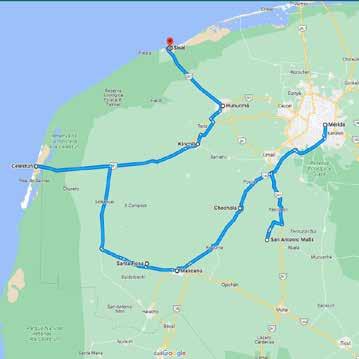
Monday
Iniciamos en Mérida, la ciudad blanca. Aquí encontrarás muchos atractivos turísticos para visitar; en el centro histórico puedes tomar el recorrido gratuito ofrecido por el Ayuntamiento, y luego escápate a alguno de los mercados para curiosear y comerte un taquito; en la página 5, Greta te cuenta qué verás en ellos.
¡Nos vamos a San Antonio Mulix! Este sitio es ideal para los que gustan de la bicicleta y los senderos; nada en sus dos cenotes y come platillos yucatecos al estilo rural. Muy recomendable para familias y grupos de amigos. Hospédate en sus cabañas o dirígete a Chocholá para quedarte en Cenote San Ignacio.
Hoy seguiremos hacia la villa de Maxcanú; visita su iglesia, su plaza principal, y el mercado municipal; puedes comer ahí o en el restaurante Oxkintok, que es también la posada donde pasarás la noche, y la zona arqueológica que puedes visitar. Hay mototaxis disponibles desde Maxcanú.
¿Qué tal una estancia en una hacienda? Nada mejor que un día en la Hacienda (y hotel) Santa Rosa de Lima. Visita su jardín botánico con plantas medicinales, el meliponario y las casitas mayas, y luego relájate con un libro en su alberca mientras disfrutas los sonidos de la naturaleza. Llevarás tu experiencia en el corazón para siempre.
Ya que disfrutaste de la selva, nos llama la costa: sigue el puerto de Celestún. Haz el recorrido por la Ría (lee al respecto en la pág. 49) y luego disfruta de la playa y los mariscos más frescos. Después de un espectacular atardecer sobre el mar, recorre el centro del poblado y disfruta un helado en la plaza principal.
Hoy el viaje es el destino: de camino a Sisal pasaremos por Kinchil y Hunucmá, donde verás maravillosas iglesias coloniales, coloridos mercados y gente maravillosa. En Hunucmá puedes visitar también el cenote “El Pocito” y conversar con los propietarios de la casa donde se encuentra. No te vayas sin probar la comida regional de Doña Guinelia, o unos ricos tacos de mariscos con El Amigo Cariño.
Terminamos la semana en el Pueblo Mágico de Sisal. Visita los edificios históricos del primer puerto de Yucatán y luego decide si pasar un día de relajación en la playa, o de aventura con alguno de los tours que se ofrecen, con opciones como snorkel, pesca o bicicleta.
We’ll be starting in Mérida, the White City, where there is plenty to do in Centro alone. Take the free walking tour offered by the city government. Then, pick a market to escape to, check out, and have a taco, a torta, or both. Greta tells you what you’ll find at some of the city markets; turn to page 5 to check it out.
Tuesday
We’re off to San Antonio Mulix! This is the perfect place for cycling and trail hiking, but you can also swim in their two cenotes or try some rural-style Yucatecan cuisine. This is a great option for families and groups of friends. Stay at their cabins or head to Chocholá and stay within the Cenote San Ignacio facilities.
Our route goes on to the village of Maxcanú. Visit the church, the main square and the local market. You can eat there or head to restaurant Oxkintok, which is also the name of your inn for the night, and a nearby archaeological site you can visit. If you don’t want to drive, you can take a tuk tuk from Maxcanú.
Thursday
How about a stay at a hacienda? Take off even the hardest of days at (Hotel) Hacienda Santa Rosa de Lima. Visit the botanical gardens to find out about local medicinal plants, the beehives, and the Maya houses. Then relax near the pool with a good book while enjoying the sounds of nature. This will be one of those experiences that stay in your heart forever.
Now that you’ve enjoyed the jungle, it’s time to head to the coast: we’re going to Celestún. Take the boat tour in the tranquil waters for the Ría (more details on page 49.) Afterwards, enjoy some time on the beach and have a fresh seafood lunch. After watching the sunset (always a treat on the west coast), stroll the main square and have a delicious ice cream.
Saturday
Today’s journey is our destination: the road from Sisal goes through the villages of Kinchil and Hunucmá, where you will see marvelous churches, colorful markets and wonderful people. Visit the cenote “El Pocito (the well)” in Hunucmá and talk to the home owners where it is located. Don’t leave without trying Doña Guinelia’s regional food or some seafood tacos at El Amigo Cariño.
Sunday
We will finish the week in the Magical Town of Sisal. Check out the historical buildings in Yucatán’s first port and then decide if you want a relaxing beach day or an adventurous day with a snorkeling, fishing, or bicycle trip.
31 Where To Go and How!
ESTANCIA DE SIETE DÍAS • A SEVEN-DAY STAY
Lunes Martes Miércoles Jueves Viernes Sábado Domingo
Wednesday Friday
Yucatán tiene tanto por ver y hacer que puede ser difícil hacer planes. En las siguientes páginas encontrarás información sobre algunos de los mejores destinos en Yucatán incluyendo lo que no te puedes perder y costos. Combínalo con nuestro Mapa Peninsular a color para planear tu itinerario sin problemas.
Para más consejos útiles para tu estancia aquí, checa nuestra página 56. ¡Que comience la aventura!
TRANSPORTE PÚBLICO
Yucatán has so much to see and do that you’re bound to be overwhelmed by the choices! On the following pages, you will find information on some of Yucatán’s best destinations, including highlights and entry fees. Pair it perfectly with our color Map of the Peninsula so that you can plan your itinerary hassle-free.
Check out our page 56 to get additional tips that will be useful during your stay in our area. Let the adventure begin!
EN MÉRIDA • PUBLIC TRANSPORTATION IN MÉRIDA
DIRECTORIO DE RUTAS E INDICACIONES • ROUTES AND DIRECTIONS
https://merida.transpublico.com/category/rutas/ www.yuc.today/moovitapp
SERVICIO VA Y VEN • VA Y VEN SERVICE
Con boleto (a la venta en el aeropuerto) o tarjeta recargable / With ticket (available at the airport) or rechargeable card
Recarga en los cajeros (Periférico) o en tiendas Oxxo /
Top-ups at ATMs on Periférico and Oxxo stores
Ubicación de autobuses en tiempo real mediante app
Va y Ven / Bus GPS tracking through Va y Ven app
Rutas / Routes
Ruta aeropuerto / Airport route
Tarifa / Fee: $45 pesos (sin tarjeta / non-cardholders)
Paradas / Stops: Terminal de Autobuses (TAME) 68, Santa Lucía, Paseo 60, Fiesta Americana, Centro Internacional de Congresos y TAME 69.
Periférico
Tarifa / Fee: $12 pesos (5 am - 11 pm)
$14 pesos (11 pm - 5 am)
Circuito Metropolitano
Tarifa / Fee: $12 pesos
Horario / Hours: 5 am - 11 pm
OTROS SERVICIOS • OTHER SERVICES
Circuito Aventura / Adventure circuit
Conecta / Connects Centenario, Animaya y Parque de Deportes Extremos
Gratuito / Free
Horario / Hours: Mar. - dom. / Tue. - Sun. 8 am - 8 pm
Ruta / Route: www.yuc.today/circuitoaventura
TOUR DE LA CIUDAD • CITY TOUR
Turibus
Salidas / Starting point: Catedral de Mérida, Paseo 60 www.turibus.com.mx/merida
Carnavalito
Salidas / Starting point: Parque de Santa Lucía www.carnavalitocitytour.com.mx E carnavalitocitytour TOLL
La carretera de cuota se encuentra en obras, por lo que hay secciones con carriles reducidos, embotellamientos y velocidad reducida.
Toma tus precauciones.
Servicios: baños públicos, parador con tiendas, restaurantes, cafetería y gasolinera (Km 153, a la altura de Valladolid)
There is currently construction going on around the toll road; there are lane closures, traffic jams, and slow-moving traffic.
Please drive carefully.
Services: restrooms, rest stops with shops, restaurants, coffee shop, and gas station (Km 153, by the exit to Valladolid)
FORÁNEOS • BEYOND MÉRIDA
SERVICIOS DE LUJO •
LUXURY SERVICES
· Terminal ADO Mérida Paseo 60
Calle 60 x 35, Centro
· Terminal ADO Mérida Altabrisa
Calle 26 x Av. República de Corea www.ado.com.mx
Sólo destinos en otros estados / Destinations in other states only:
Cancún, Aeropuerto de Cancún y Playa del Carmen (Quintana Roo), Villahermosa (Tabasco)
PRIMERA Y SEGUNDA CLASE •
FIRST- AND SECOND-CLASS SERVICES
Terminal ADO Mérida Centro Histórico
Calle 69 x 68 y 70, Centro, Mérida
Tel. 999 924 0830
Destinos en Yucatán / Destinations in Yucatán: Chichén Itzá, Uxmal, Valladolid, Tizimín, Oxkutzcab, Peto, Tekax, Ticul, Tzucacab
Destinos en otros estados / Destinations in other states: Calkiní, Campeche, Ciudad del Carmen, Champotón, Escárcega (Campeche), Villahermosa (Tabasco), Cancún, Playa del Carmen, Cobá, Tulum (Quintana Roo)
SEGUNDA CLASE •
SECOND-CLASS SERVICES
Terminal de Autobuses Noreste – LUS
Calle 67 x 50 y 52, Centro, Mérida
Tel. 999 924 6355 y 999 924 7865
www.autobusesdelnoreste.com.mx/horarios
Destinos en Yucatán / Destinations in Yucatán: Acanceh, Baca, Buctzotz, Cansahcab, Chumayel, Conkal, Dzidzantún, Dzilam de Bravo, Dzilam González, Dzoncauich, Mamita (Mama), Maní, Mocochá, Motul, Oxkutzcab, Petectunich, Sucilá, Suma, Teabo, Tecoh, Tehuitz, Tekat, Tekit, Telchaquillo, Temax, Tepich, Tipikal, Tizimín
CONECTIVIDAD AÉREA • AIRLINES
Vuelos directos / Non-stop flights: Internacionales / International Miami (AA), Houston (UA), Dallas (AA), Toronto (WJ), Guatemala (TAG), La Habana (VA), Flores (TAG) Nacionales / Domestic Ciudad de México (AM, V, VA, MC), Cancún (MA, MC), Guadalajara (V, VA), Guanajuato (V, VA), Monterrey (V, VA), Oaxaca (V), Quéretaro (VA), Tijuana (V), Toluca (VA), Tuxtla Gutiérrez (VA), Veracruz (VA), Villahermosa (VA)
Leyenda / Legend:
Tarifas
AA: American Airlines (www.aa.com) / AM: Aeromexico (www.aeromexico.com) / MA: MAYAir (www.mayair.com.mx) / MC: Magnicharters (www.magnicharters.com) / TAG: Transportes Aéreos Guatemaltecos (www.tag.com.gt) / UA: United Airlines (www.united.com) / V: Volaris (www.volaris.com) VA: VivaAerobus (www.vivaaerobus.com) / WJ: WestJet (www.westjet.com)
32 ¡Dónde ir y Cómo!
• HOW TO GET THERE
CÓMO LLEGAR
Sólo
$609.00 $385.00 $321.00 $223.00 $94.00 $129.00 $544.00 $458.00
en pesos para vehículos de dos ejes; costo adicional por eje y/o carga. Rates in pesos for two-axle vehicles; tolls increase by additional axle and/or weight.
efectivo / Cash only
ROAD TO CANCÚN AND PLAYA DEL CARMEN AUTOPISTA DE CUOTA A CANCÚN Y PLAYA DEL CARMEN Mérida Cancún Chichén Valladolid Cancún Mérida Mérida Valladolid Playa del Carmen Mérida Mérida Playa del Carmen Cedral (Holbox)
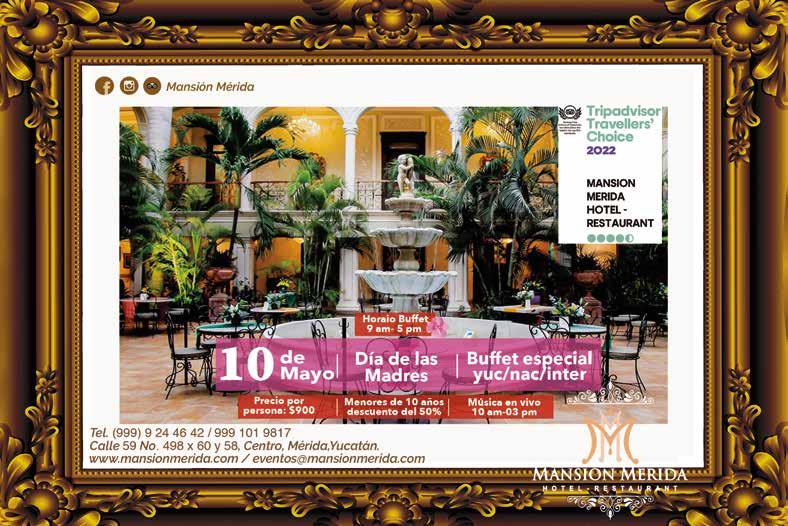
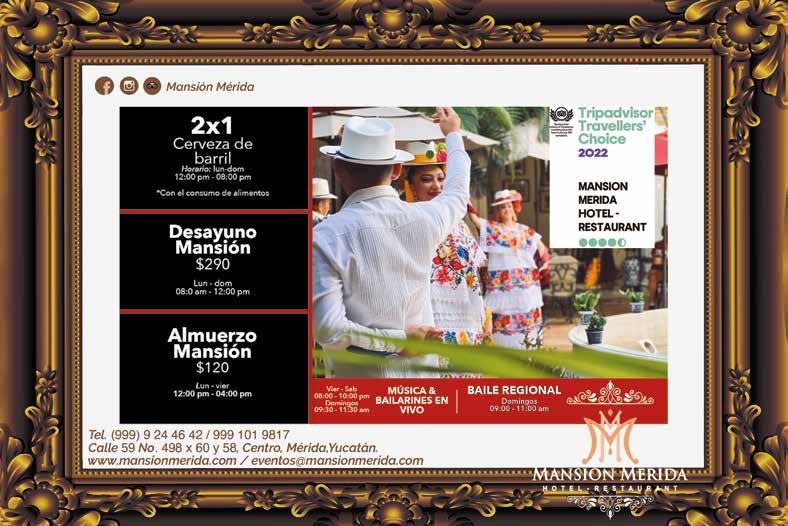
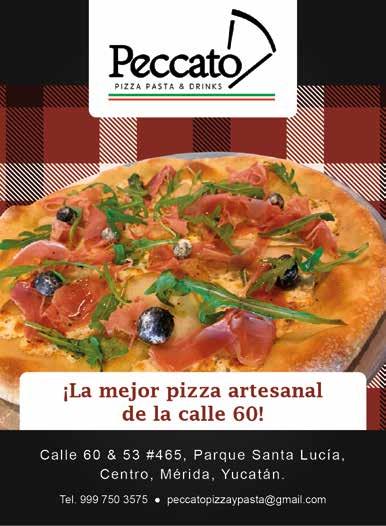


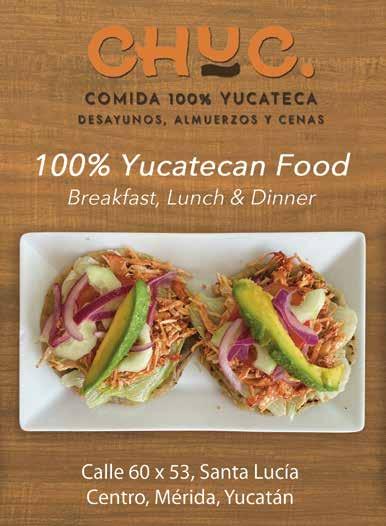
Cómo visitar sitios arqueológicos con tus hijos
How to Visit Archaeological Sites With Your Kids
o te rías, es en serio. Nosotros frecuentemente visitamos los sitios arqueológicos de la Península de Yucatán con nuestros hijos. De hecho, ellos lo consideran divertido. Cuando llegamos a México nuestros hijos tenían dos y cuatro años, y desde entonces hemos pasado todo este tiempo explorando los sitios arqueológicos del país.

¿Cómo es que no se aburren los niños cuando vamos a una zona arqueológica? Pues muy sencillo: intentamos no sobrecargarlos de información. Cuando vamos con ellos, nunca vamos en tours. Tenemos que ser realistas en cuanto a lo que los niños pueden soportar y personalizar la experiencia a ellos.
Cuando estaban chiquitos, solíamos ir a los sitios para subirnos a árboles y corretear por ahí; sobre todo, el reto era empezar a sembrar en ellos la curiosidad por conocer más. ¿Qué mejor manera de fomentar pasión por la exploración y el aprendizaje que convertirla en parte de la vida cotidiana?
Ahora que los niños están un poco más grandes les hablamos sobre la historia de México y los mayas. Para involucrarlos, les contamos historias, jugamos a que viajamos en el tiempo y hablamos sobre lo que veremos. Nos gusta hacerlo relevante a sus vidas: “Imagínate haber sido un niño aquí hace 600 años…” Esto inicia todo tipo de conversaciones y juegos imaginativos.
Varios sitios aún tienen edificios y pirámides a los que nos podemos subir. Esto nunca deja de ser emocionante para mis hijos y los hace sentir valientes. Aman subir con confianza y también les encanta recibir una galletita y agua como premio cuando llegan a la cima de una subida particularmente retadora.
Yucatán también tiene un reino animal muy diverso, ¡no lo ignoren! Deténganse a ver filas de enormes hormigas, o busquen orugas en los árboles; e invita a los niños a escuchar el sonido que hacen las alas de una mariposa o los aullidos de un mono.
¿A dónde ir para la diversión de tus hijos?
Bueno, nuestro favorito (¡shh!) es Mayapán. No muy lejos de Mérida está este precioso sitio en donde los niños pueden correr con libertad. Los sitios de la Ruta Puuc también son maravillosos para explorar, lo cual permite que los niños se sientan como verdaderos aventureros. También cerca de Mérida está X’Cambó; aquí encontrarás un pequeño sitio completamente rodeado por la jungla.
Aun cuando piensen visitar sitios más grandes como Uxmal o Chichén Itzá, claro que es posible convertirlo en una aventura. Y si esto no funciona, sobornarlos también suele ser efectivo: promételes un helado o una visita al cenote cuando terminen.
on’t laugh. Seriously. We regularly take our children to visit the archaeological sites around the Yucatán Peninsula, and, in fact, our kids think it’s a treat. We arrived in México when our kids were two and four and we’ve been checking out the country’s archaeological sites all this time.
How are our kids not bored when we go? It’s simple really: we just don’t overload them with facts. When we’re with them, we never join a tour, because we need to be realistic about what children can manage. Tailor the experience to them.
When they were tiny we would run around, climb trees and, crucially, plant the seeds of curiosity. What better way to foster a love of exploration, learning, and understanding than to make it all part of normal life? Just as museums around the world now tailor experiences to the agerange, so do we with our activities.
Now that they’re a little older, we do talk a lot more about Mexican history, and the Maya civilization, To make it interesting to them we tell stories, we pretend we’ve gone back in time, and talk about what we might see. We also make it relevant to their lives. We talk about what they would have done: ‘Imagine being a kid here 600 years ago…’ sparks many conversations and imaginative games.
And, of course, handily, many of the sites have buildings and pyramids we can still climb. This never ceases to excite my kids. They feel intrepid and strong. They love that they can climb confidently and they love the reward of a cookie and water when we reach the top of a particularly challenging climb.
Yucatán has a wide and varied animal kingdom too. Don’t ignore it! Stop and watch the trails of enormous ants going about their business, the caterpillars on the trees, call the kids to listen to the noise a butterfly makes or the slightly louder howler monkeys calling to each other.
So where
should you go to excite your children?
Well, our personal favorite (shh!) is Mayapán. Not far from Mérida is this beautiful site where the kids can run and climb to their hearts’ content. The Ruta Puuc sites are also great for exploring with children because they’re often empty, really letting kids feel like explorers. Another option is the site of X’Cambó, completely surrounded by jungle.
Even if you’re taking them to bigger sites like Uxmal or Chichén Itzá, it’s possible to turn it all into an adventure. And if that doesn’t work, bribery almost always will! Promise them an ice cream or a cenote swim when you’re done.
33 Where To Go and How!
N SALIDAS FAMILIARES • FAMILY OUTINGS
FOTO: CASSIE PEARSE
D
POR / BY CASSIE PEARSE
Q
Mayapán
mexicocassie
DESCUBRIENDO LUGARES • YOU’RE GOING PLACES
Plumas y cantos por doquier: aves en Mérida
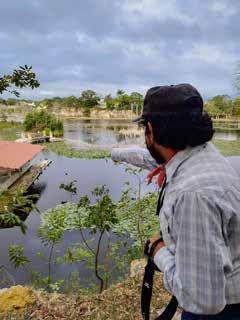
Feathers and Song Everywhere: Birdwatching in Mérida

E
s bien sabido que Yucatán es tierra mágica, llena de vida y colores por donde voltees, y justo eso, en ocasiones, no nos permite admirar totalmente la belleza que hay a nuestro alrededor. Hoy quiero compartir contigo una de las experiencias más bellas que me han tocado vivir y que ha hecho que me sienta desconectada de todo, excepto de la naturaleza, y sin salir de la ciudad de Mérida.
Esta experiencia es impulsada por el Colectivo Cardenales, que surgió durante el confinamiento como una manera de ayudar a personas de cualquier edad con su bienestar emocional y mental a través del avistamiento de aves. Su enfoque principal son las personas que no conocen nada sobre esta actividad; es decir, principiantes.
Si lo tuyo es fotografiar cada lugar que visitas, dejame decirte que estarás encantado, ya que al principio recibirás una breve clase de digiscoping, para que aprendas a tomar fotos con tu celular a través de los binoculares. No te preocupes si nunca has usado unos binoculares o si, como yo, usas lentes; Arturo y Ali son unos magníficos guías que te orientarán en todo momento.
El destino elegido fue el Acuaparque, ubicado en el oriente de Mérida. Debo confesar que me llevé una gran sorpresa; en toda mi vida en esta ciudad, y habiendo visitado este parque, nunca hubiera imaginado la cantidad de aves (y otras especies) que se alojan ahí. Quizá tú, querido lector, seas un gran conocedor de los sitios más concurridos por la naturaleza (o quizá no), pero puede ser que incluso el parque de tu colonia albergue más sorpresas de las que puedas imaginarte.
La aventura inicia con un pequeño desayuno (café/jugo y pan/fruta, incluido en el tour). El recorrido en sí fue de aproximadamente tres horas, pero, aunque sí te recomiendo llevar ropa y zapatos cómodos, créeme que el tiempo pasó volando. El parque tiene una gran extensión, por lo que la diversidad dentro del mismo es mucha: espacios planos, con algunas subidas muy altas y con un gran lago en el centro; esto lo vuelve un lugar muy atractivo para ser visitado diariamente por una maravillosa fauna.
¿Que cuáles fueron estas “muchas” especies que pudimos avistar durante el recorrido? Vimos perlitas azul-gris, colibríes (un buen número), capuchinos tricolor, semilleros de collar, azulejos picogordos, loros frente blanca , jacanas norteñas, varias garzas, algunos pájaros carpinteros cheje y uno que no puedo dejar de mencionar por los chistes que se hicieron en su honor: el luisito común (Myiozetetes similis). Sí, si eres principiante, nosotros pensamos lo mismo que tú; de hecho, no sólo lo pensamos. Después, además, nos encontramos con un Pitangus sulphuratus, conocido como… luis grande (sin comentarios). Las anteriores son solo
unas cuantas de las especies que pudimos observar, ya que logramos identificar un poco más de 25 tipos de aves.
En lo personal, yo estoy muy agradecida con Ali y Arturo, una pareja encantadora que logró hacernos entrar en confianza casi al instante; fueron pacientes en todo momento y me encantó que se entusiasmaron igual que nosotros con cada nuevo avistamiento. Ambos tienen un gran amor por lo que hacen y definitivamente durante todo el recorrido pudimos sentirnos parte de cada descubrimiento; en algún punto mis compañeros y yo estábamos tan emocionados que sólo queríamos descubrir qué aves nos esperaban en el siguiente árbol.
Al regresar a casa, me detuve un tiempo considerable a observar la naturaleza que rodea mi colonia y ahora, en las mañanas me tomo unos minutos para escuchar el canto de las aves que me dan los buenos días e imagino que tal vez es un luisito común saludando.
Espero haber plasmado correctamente todo lo que este tour me hizo sentir, y haber generado en ti esas ganas de probar esta experiencia. Ali y Arturo ofrecen recorridos de lunes a domingo, de medio día o de día completo, ajustándose completamente a tus horarios.
La tarifa para el avistamiento en el Acuaparque es de $650 pesos por persona reservando directamente con ellos en su sitio web; ofrecen también recorridos por otros parques dentro de Mérida que seguramente te sorprenderán.
¡Pero eso no es todo! Si tu intención es salir de Mérida para ver aves, puedes también elegir entre muchos otros destinos para realizar esta actividad, ya que también cuentan con tours dentro del estado, por la Costa Esmeralda, en sitios más profundos dentro de la selva, y más. De igual manera, si tu entusiasmo recae en el avistamiento de un ave en específico, ellos estarán encantados de asesorarte sobre el lugar en el que podrás encontrarla, además de acompañarte y ser los mejores guías para que logres tu objetivo.
34 ¡Dónde ir y Cómo!
FOTO: COLECTIVO CARDENALES
FOTO: CARLOS GUZMÁN
Colibrí · Hummingbird
Colectivo Cardenales en el Acuaparque
DESCUBRIENDO
LUGARES
• YOU’RE GOING PLACES
Mi último consejo: regálate un tiempecito para disfrutar esta maravillosa experiencia y descubrir esos lugares escondidos dentro de nuestra ciudad que terminan siendo una verdadera joya.
Visita www.yuc.today/230434 para ver más fotos y saber más sobre esta experiencia
It is well known that Yucatán is a magical land, full of life and color everywhere you turn. It is exactly this fact that, on many occasions, doesn’t let us really see all the beauty that is right in front of us. Today I would like to share with you one of the most beautiful experiences I have experienced, where I felt completely disconnected from everything, except nature, without even leaving the city of Mérida.
This adventure is promoted by the group Colectivo Cardenales (Cardinal Collective) which came about during the pandemic lockdown as a way to help people of all ages with their mental health and emotional wellbeing
never guessed the enormous amount of birds and other species that live here. Maybe you, dear reader, are more knowledgeable about places where nature abounds (or maybe not), but you might be surprised to discover that even your neighborhood park is home to more surprises and species than you can imagine.
The adventure starts with a light breakfast (included in the tour); then, on to the visit, which takes about three hours. While I do suggest you wear comfortable clothing and shoes, believe me, time will fly by. The Acuaparque is a large, diverse park with flat areas, some hills, and a large lake in the middle that attracts a lot of marvelous fauna everyday.
So by now, I imagine you are probably wondering just what kinds of birds we were able to see during our visit; here’s an incomplete list: blue-gray gnatcatchers, hummingbirds (quite a few), tricoloured munias, cinnamon-rumped seedeaters, blue grosbeaks, northern jacanas, white-fronted parrots, various kinds of ospreys, a few woodpeckers, and one that I cannot for-
When I got home, I stopped for a while and really observed all the nature around my neighborhood. Now, in the mornings, I take a few minutes to listen to the songs of the birds who are saying good morning to me and I imagine that maybe one is a Luisito saying hello.
I truly hoped to have fully conveyed how much I enjoyed this tour and how it made me feel, and that you too will be curious and join one of your own. Ali and Arturo offer half- or full-day trips from Monday to Sunday and will adapt to your needs and schedules.
The rate for birdwatching at the Acuaparque is $650 pesos per person when you reserve directly with them on their website; they also offer birdwatching tours in other parks within Mérida that will surely surprise you.


But that’s not all! If you prefer to leave the city to see different kinds of birds, they also have tour options all over the state, along the Emerald Coast, deeper into the jungle, and more. Alternatively, if you’re interested in ob-

through birdwatching. Their main focus is with people who know nothing about birdwatching; in other words, newbies.
If taking pictures of every place you visit is your thing, let me tell you that you will be elated, as at the beginning of the talk there is an explanation about digiscoping, so that you learn to take pictures with your cell phone through the binoculars. Don’t worry if you’ve never used binoculars before, or if, like me, you wear glasses; Arturo and Ali are great guides who will help you out at every moment.
The destination chosen for our adventure was the Acuaparque, located in the western part of Merida. I must admit that I was really surprised; I’ve lived my entire life in this city and had been to this park before, but I could have
get to mention after all the jokes we made about it: the social flycatcher. You see, its name in Spanish is Luisito Común (which means “common little Luis”), which we found hilarious. And then we spotted a great kiskadee, in Spanish known as Luis Grande (big Luis). I’m sure you can guess how that went. These birds are just a few of what we saw, as we were able to identify more than 25 kinds of birds.
I personally am very thankful to Ali and Arturo, a charming couple that made us feel comfortable right off the bat; they were patient the whole time and I loved their enthusiasm which reflected ours with each sighting. They truly do love what they do and we felt their excitement with each discovery; at one point we were all so excited that we couldn’t wait to see what we were going to discover in the next tree.
serving any specific species of bird, they are knowledgeable on where to go to spot it will take you where you need to go to help you achieve your goal.
One last tip from me: give yourself some time to enjoy this marvelous experience and to discover hidden places within our city that turn out to be true jewels.
Colectivo Cardenales
m 999 650 5925 / +1 704 796 3020
Q colectivocardenales
www.colectivocardenales.com
Visit
OSALDE
35
Where To Go and How!
POR / BY ARIANNE
FOTO: CARLOS GUZMÁN
www.yuc.today/230435 for more pictures and to find out more about this experience.
FOTO: ARIANNE OSALDE
FOTO: CARLOS GUZMÁN
Garza · Heron
Fotos con digiscoping · Digiscoping photography
Q ari.osaldeg
Guía para referencia · Additional reference guide
AGENCIAS DE VIAJE / TOURS / TRANSPORTACIÓN • TRAVEL AGENCIES /

Destino Mérida Private Tours
L 999 261 6126
www.destinomeridatours.com
Q Destino Merida Private Tours
Xootrip
m 999 950 2290
# 999 236 1545
www.xootrip.com
Mayan Ecotours
m 9991 05 4614
www.mayanecotours.com
E Mayan Ecotours
Xocen Birding Trail
m 985 211 7068 Q y E Xocen Birding Trail
Tico’s Tours en Dzilam de Bravo
m 991 116 2027
Sisal Beach Tours
m 999 260 6816
Rio Lagartos Xplore
m 986 861 4001
San Felipe Tours & Fishing
m 986 105 9737
INMOBILIARIAS • REAL ESTATE + PROPERTY MANAGEMENT
Bayside Real Estate
Calle 21 x 80, Malecón Tradicional www.baysideyucatan.com
E Bayside Real Estate Yucatán
Caban Condos
m +1 306 361 1800 / 984 234 8694
www.cabancondosmexico.com
Q y E Caban Condos Mexico
Gone South Property Management
m 999 164 1118
www.gonesouth.online
Hamaka Professional Co-Hosting
m 999 965 8953 / www.hamaka.mx
Q y E hamaka.mx
Homes for Sale
m 999 264 3777 / 999 163 4050 www.homesforsaleinyucatan.com
Mexico International Calle 9 #63 x 6 y 8, Reparto Dolores Patrón (García Ginerés)
m 999 920 6856 www.mexintl.com
E Mexico International Real Estate
Yucatán Beach and City Property
m +1 830 273 3881
L 999 129 9403 www.yucatanbeachandcityproperty.com
E Yucatán Beach and City Property
RENTADORAS DE AUTOS • CAR RENTAL AGENCIES
Best Car Rental
m 999 923 6337
# 999 328 2577
yucatanbestcar@gmail.com
Chichén Car Rental

m 999 905 6590
Q chichencarrental
E Chichen Car Rental
Mayan Wheels Car Rental

Mérida m 999 666 7320
Progreso m 969 103 6735
# 999 242 5057
México Rent a Car
m 999 127 8556
m 999 988 8465
mexicorentacar@hotmail.com

www.mexico-rent-acar.com


E México Rent A Car
UB Rent a Car
m 999 920 2929
# 999 209 2830 rentaautoub@gmail.com www.rentacarub.com
VIP Rent a Car
m 999 406 5017
# 999 301 9926 viprentacar2017@gmail.com
E VIP Rent a Car Yucatán
Xootrip
m 999 950 2290
# 999 236 1545
xootrip@gmail.com
www.xootrip.com / E Xootrip
36 ¡Dónde ir y Cómo!
TOURS / TRANSPORTATION
• WHERE TO STAY

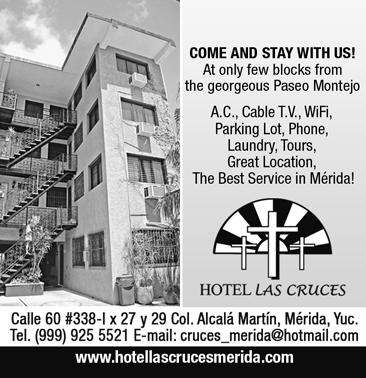
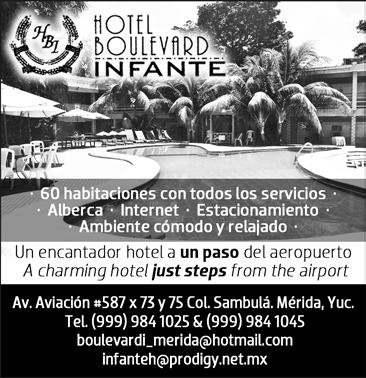
37 Where To Go and How! Hotel Chichén Itzá Calle 15 #45, Pisté Chichén Itzá (985) 851 0022 www.mayaland.com 42 Mayaland Hotel & Bungalows Carr. Mérida - Cancún Km 120 Chichén Itzá (998) 240 8247 www.mayaland.com 52 San Miguel Arcangel Calle 31-A #308 x 30 y 30-A Izamal (988) 954 0109 www.sanmiguelhotel.com.mx 14 Hotel Tuul Calle 22 #302 x 31 y 33 Izamal (999) 442 9506 E Hotel Tuul Izamal Boulevard Infante Av. Aviación #587 x 73 y 75 Sambulá Mérida (999) 984 1025 www.hotelboulevardinfante.com 80 Casa Azul Calle 60 x 37 Centro Mérida (999) 925 5016 www.casaazulhotel.com 8 Diplomat Boutique Calle 78 #493-A x 59 y 59-A Centro Mérida (999) 117 2972 www.thediplomatmerida.com 4 Fiesta Americana Paseo de Montejo Centro Mérida (999) 942 1111 www.fiestamericana.com Hacienda Mérida Calle 62 #439 x 51 y 53 Centro Mérida (999) 924 4363 www.hotelhaciendamerida.com 10 Hotel del Peregrino Calle 51 #488 x 54 y 54 Centro Mérida (999) 924 3007 www.hoteldelperegrino.com Hyatt Regency Mérida Calle 60 #344 x 35 y Av. Colón Centro Mérida (999) 942 1234 merida.regency.hyatt.com 289 Las Cruces Calle 60 #338 x 27 y 29 Alcalá M. Mérida (999) 925 5521 www.hotellascrucesmerida.com 16 Luz en Yucatán Calle 55 #499 x 58 y 60 Centro Mérida (999) 924 0035 www.luzenyucatan.com 12 Mansión Mérida Calle 59 #498 x 58 y 60 Centro Mérida (999) 924 4642 www.mansionmerida.com 14 Rosas & Xocolate Paseo de Montejo #480 x 41 Centro Mérida (999) 924 2992 www.rosasandxocolate.com 17 Villa Mercedes Curio Collection Av. Colón #500 x calle 60 Centro Mérida (999) 315 7762 Q villamercedesmerida 127 Wayam Mundo Imperial Av. Colon #508 x 6 y 72 García Ginerés Mérida (800) 969 2926 www.wayammundoimperial.com 52 The Lodge at Uxmal Inside Archaeological Zone Uxmal (999) 368 4392 www.mayaland.com 40 Puuc Calle 55 #80 x 44 Oxkutzcab (997) 975 0103 www.hotelpuuc.com.mx 51 Domani Hotel & Suites Calle 19 #144-F x 72 y 74 Malecón Progreso (969) 935 0707 www.hoteldomanisuites.com 22 Hotel Amor Progreso Calle 29 #710 x 130 Yucalpetén Progreso (999) 361 7624 www.hotelamor.mx 3 TecnoHotel Express Carretera Tekax-Akil Tekax (997) 979 0010 www.tecnohotelexpress.com 20 Le Muuch Calle 42 #188-A x 35 y 33 Centro Valladolid (985) 856 4099 www.hotellemuuch.com 21 Olbil Calle 41 #169-G x 28 y 30 Santa Ana Valladolid (985) 244 2758 Q y E olbilhotelvalladolid 12 Yabucú Acanceh Acanceh (999) 944 1345 www.yabucu.mx 36 Chichén Resort Carr. Chichén Itzá - Valladolid Chichén Itzá (999) 920 8408 www.haciendachichen.com 30 San Francisco Tzacalhá Calle 22, San Francisco Manzanilla Dzidzantún (991) 915 5528 www.hotelhdasanfrancisco.com.mx 23 Xcanatun by Angsana Carr. Mérida - Progreso Km 12 Mérida (999) 930 2140 E Hacienda Xcanatun 18 Petac Carr. Mérida - Dzunancán Petac (999) 161 7265 www.haciendapetac.com 7 Hacienda Uxmal Inside Archaeological Zone Uxmal (998) 214 6487 www.mayaland.com 62 DÓNDE
Restaurante Bar Nombre Name Dirección Address Colonia Neighborhood Ciudad City Teléfono Telephone Sitio web Website Total cuartos Total rooms Villas El Encanto Carr. libre Mérida-Cancún Km 85 Holcá (997) 111 9418 E El Encanto Jardín de Eventos 5 Casa del Maya B&B Calle 66 #410-A x 45 y 47 Centro Mérida (999) 181 1880 www.casadelmaya.com 6 Casona Nikté Calle 59 x 80 y 82 Barrio Santiago Centro Mérida (999) 140 2926 www.casonanikte.com 6 Casa Tülup Sisal (999) 110 6838 Q casatulupsisal Hamaka Centro y norte de Mérida Sisal y Chelem (999) 965 8953 www.hamaka.mx Las Tunas Carretera Telchac San Crisanto Km 45.5 Telchac Puerto (999) 968 3687 Q lastunastelchac HOTELES • HOTELS B&B / CASAS DE HUÉSPEDES / DEPARTAMENTOS / RESIDENCIAS / CAMPING • B&B / GUESTHOUSES / APARTMENTS / RESIDENCES HACIENDAS • HACIENDAS
HOSPEDARSE
n Yucatán hay un enigmático mundo debajo de la superficie, con cenotes, cavernas y grutas para descubrir y explorar. En estos espacios sagrados para los mayas se resguardaba agua y se realizaban ceremonias. Hoy puedes recorrerlos y apreciar sus formaciones naturales. Por seguridad hazlo siempre con un guía y con ropa y zapatos adecuados.
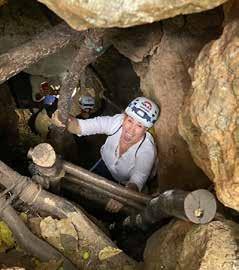
Aktún Usil (Maxcanú): Estas grutas fueron descubiertas recientemente, así que encontrarás altares, cerámica, vasijas y otros vestigios mayas. Aktún Usil también destaca por sus más de 60 metros de profundidad y los jeroglíficos en su techo. El recorrido tiene una duración de dos horas; se puede disfrutar toda la semana de 7 am a 10 pm.
E AKTUN USIL
Balankanché (Pisté): Fue un importante centro ceremonial, que destaca por su imponente altura de hasta 25 metros. Ahí verás objetos que se utilizaron en ceremonias y altares, incluídos el llamado Trono de Balam y una formación que asemeja a un árbol de ceiba.
Calcehtok (Oxkintok): Se caracteriza por contar con varios túneles en los que es posible hacer rapel y escalar. Fue utilizado como centro ceremonial por los antiguos mayas y como escondite durante la Guerra de Castas. Tiene formaciones naturales que parecen figuras humanas y de animales. En su interior se encontraron restos de asentamientos prehispánicos. Es requisito realizar la visita con un guía para hacer recorridos fáciles o extremos. Se recomienda llevar un cambio de ropa. Está a 1 hora de Mérida.
Chocantes (Tekax): Son unas impresionantes cuevas de cristal llenas de belleza. Sus interiores tienen hermosas formaciones minerales en forma de cascadas que brillan intensamente cuando se iluminan. Se requiere de gran condición física para hacer el recorrido de casi 8 km, ya que hay descenso, arrastre y caminata por espacios que pueden llegar a ser muy estrechos.
E Gruta chocantes
Las Sartenejas (Tekax): Son tres grutas con diferentes niveles de recorridos.
E Gruta Las Sartenejas II
Loltún (Oxkutzcab): Es muy accesible y grande. Se pueden observar figuras extraordinarias formadas con las estalactitas y estalagmitas. Es una excelente opción para conocer el llamado inframundo maya de
manera bastante tranquila. Ideal para familias con niños y personas mayores ya que se puede recorrer caminando.
Tzabnah (Tecoh): Es una gruta con formaciones de columnas y cúpulas que cuenta con varios cenotes cristalinos aptos para bañarte. El recorrido es de dos horas aproximadamente y sólo algunos tramos se hacen con arrastre. Al llegar a la comunidad se contrata al guía; el tour incluye linterna, casco y chaleco. El parador está en la salida a Telchaquillo.
also found in these caves. A guide is required for your visit; both extreme and easy tour options are available. Make sure to bring a change of clothes. Calcehtok is one hour from Mérida, near Maxcanú.
In Yucatán there is an enigmatic subterranean world to explore with a wide array of cenotes and caves to discover. These were sacred places for the Maya, where they stored water and conducted ceremonies. Today, many of these offer the opportunity of exploring them and marveling at their unique natural formations. For your safety, always make sure that you visit with a guide and dress accordingly.
Aktún Usil (Maxcanú): These caves were recently discovered, so you will find altars, pottery, and other Maya vestiges. Aktún Usil also stands out for its more than 60-meter depth and the hieroglyphs on its ceiling. The tour lasts two hours; it can be enjoyed all week from 7 am to 10 pm.
E AKTUN USIL
Balankanché (Pisté): It was an important ceremonial center. Its main feature is its astounding 25-meter height. Inside, you’ll find objects that were used in altars and ceremonies, including the Trono del Balam and a surprising Ceiba tree-shaped formation. The tour is approximately 30-40 minutes long. The site has a museum, bathrooms, and parking. Guided tours are available in English, Spanish, and French. There is an entry fee.
Calcehtok (Oxkintok): It’s known for having several tunnels where you can rappel and climb. It was used as a ceremonial center by the ancient Maya and also as a hiding spot during the Guerra de Castas. It has many natural beautiful formations with several resembling human and animal figures. Remains of pre-Hispanic settlements were
Chocantes (Tekax): These stunning caves are filled with crystal formations. Inside, you’ll discover beautiful walls of minerals that look like frozen waterfalls. You will also have the opportunity to see how brightly they shine when the light hits them. Exploring the caves requires you to do a fair amount of climbing, crawling, and walking for about 8 km through some spots that can get particularly tight. You’ll need to be in good shape to make this visit.
E Gruta chocantes
Las Sartenejas (Tekax): These three caves offer different levels of difficulty depending on your bravery and expertise.
E Gruta Las Sartenejas II
Loltún (Oxkutzcab): This is one of the most visited caves because of its easy accessibility and impressive size. Inside, you can gaze at the extraordinary stalactite and stalagmite formations. It’s an excellent way to get to know the “Maya Underworld” without too much physical effort. You can walk through them, so they’re ideal for a family excursion with kids or seniors. The site has bathrooms and parking. There is an entry fee.
Tzabnah (Tecoh): This is a very interesting cave with column and dome formations that also has many crystal clear cenotes that are perfect for swimming. The tour lasts about two hours and you only need to crawl along a few parts of it. Upon arriving to the site, you can hire a guide for this tour. You will be given a flashlight, a helmet, and a lifejacket.
38 Destinos
E FOTO: YUCATÁN TODAY
Gruta Chocantes, Tekax
Al momento de esta edición, las Grutas de Loltún y Balankanché están cerradas hasta nuevo aviso.
As we go to print, the caves of Loltún and Balankanché are closed until further notice.
AVISO / NOTICE
GRUTAS • CAVES
rescos, divertidos y dignos de una escapada para soltar la pesadez de la ciudad: éstas son algunas de las cualidades que acompañan a los cenotes. No son lagunas; tampoco charcas o estanques. Los cenotes son maravillosos espacios subterráneos inundados por agua filtrada a través del suelo calcáreo.
Tipos de cenotes
Encontrarás que los cenotes vienen en muchos colores, formas y condiciones; no hay dos iguales. Tradicionalmente hay tres tipos: los abiertos, los semiabiertos y los cerrados. Unos son muy turísticos, otros son más rústicos. Sea uno u otro, los cenotes son enigmáticos, hermosos y una ventana para echar un vistazo a otro aspecto de la cultura maya: el inframundo.
Los cenotes y el Xibalbá
Los mayas creían que los cenotes y las cuevas eran la entrada al inframundo, Xibalbá; por lo tanto, son considerados lugares sagrados y se debe entrar con respeto. Algunos han sido objeto de estudio por sus vestigios arqueológicos —por ejemplo, el cenote sagrado de Chichén Itzá— y otros todavía cuentan con pequeñas esculturas de sus guardianes. Si lo que quieres es aprender de mitos y leyendas, un guía o los pobladores del área te podrán llenar de magníficas historias.
¿Cómo escoger qué cenote visitar?
Ésta es una duda complicada de resolver: ¡hay demasiados! Y cada uno más bello que el anterior. Para tener un poco de luz respecto a dónde ir, empieza seleccionando un par según su ubicación, accesibilidad al agua y nivel de producción. Algunos cuentan con vestidores, baños y opciones para comer, ya que es posible que termines con ganas de un bocadillo o una bebida.
La realidad es que hay miles de cenotes en Yucatán; muchos tienen señales coquetas sobre la carretera. Explora con cuidado (sin tocar las estalagmitas y estalactitas), diviértete al máximo y, por favor, entra al agua libre de bloqueador solar o repelente para proteger las formaciones de piedra en crecimiento.
resh, fun, and well worth a getaway in nature: these are some of the things that come to mind when we think about cenotes. They’re not lagoons or ponds; cenotes are marvelous subterranean spaces that have been naturally flooded with limestone-filtered water.
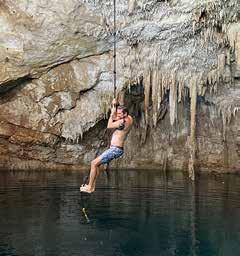
Types of cenotes
You’ll find that cenotes come in many colors, shapes, and conditions; no two are the same. Traditionally, there are three types: open (exposed, not enclosed in a cave), semi-open (partially exposed), and closed. Some are very touristy, others are more rustic. Whichever you choose, cenotes are enigmatic, beautiful, and a window into another aspect of Maya culture: the underworld.
Cenotes and Xibalbá
The Maya believed that cenotes and caves were the entrance to the underworld, known as Xibalbá; therefore, they’re considered sacred places and should be entered with respect.
GUÍA BÁSICA DE CENOTES:
BASIC CENOTE GUIDE:
Poblaciones con muchos cenotes Towns with many cenotes: Homún, Cuzamá y Cenotillo

Para niños y adultos mayores Suitable for kids & seniors Santa Bárbara (Homún)
Instagrameables • Instagram-worthy Hacienda y Cenotes Mucuyché (Abalá) Hacienda Oxmán (Valladolid) Suytún (Valladolid), Ik-Kil (Chichén Itzá)
Actividades adicionales • Activities galore Hacienda Selva Maya (Valladolid) Chichikan (Valladolid), X’Canché (Ek Balam) Hacienda Sotuta de Peón (Sotuta)
Rústicos cerca de Valladolid Rustic close to Valladolid Xcanahaltún, Palomitas, Dos Aguas, Sac Aua, Yokdzonot y X’Canché
Cooperativas cerca de Chemax e X-Can Co-ops close to Chemax and Xcan Cenote Pueblo Fantasma, Cenote y gruta Nohoch Actun, Cenote Choj Ha
Rústicos cerca de Uxmal Rustic close to Uxmal Kankirixché, Xbatún y el trío: Nah Yah, Suem y Noh Mozón
Nocturnos • Open at night San Ignacio (Chocholá), Zazil Tunich (Valladolid) y Cenote Chihuán (Holcá)
Dentro de la ciudad • Within the city Costco (Mérida) y Zací (Valladolid)
En sitios arqueológicos
At archaeological sites
Xlacáh (Dzibilchaltún), X’Canché (Ek Balam) y Cenote Sagrado (Chichén Itzá)
Visita privada • Private visit Los 7 Cenotes y Destino Mío
Some have been studied for their archaeological remains—for example, the Sacred Cenote at Chichén Itzá—and others still have sculptures of their guardians. If you want to learn about myths and legends, a guide or the community’s locals can tell you magnificent stories.
How to pick the right one for you?
Perhaps the most complicated question to answer, as there are so many cenotes! And each one is more beautiful than the last. To shed some light on where to go, start by selecting a handful based on their location, accessibility, and how wild you’d like for them to be. There are so many to choose from! Some have lockers, restrooms, and restaurants, which come in handy when swimming works up an appetite.
The reality is that there are thousands of cenotes in Yucatán; many have flirty signs on the road to show you where they are. Wherever you decide to go, explore with care, don’t touch the stalactites and stalagmites, have as much fun as possible, and please enter the water free of sunscreen or insect repellent, to protect the growing stone formations.
39 Destinations
F FOTO: YUCATÁN TODAY FOTO: YUCATÁN TODAY
Cenote Canunchén, Homún
Cenote Canunchén, Homún
F
CENOTES
Destinos
ZONAS ARQUEOLÓGICAS MAYAS
Aunque la cultura maya sigue viva hasta el día de hoy, no cabe duda que los vestigios de sus grandes construcciones prehispánicas son una de las atracciones más importantes de Yucatán. Todos los sitios abren de 8 am a 4 pm todos los días, y ofrecen entrada gratuita para residentes legales en México todos los domingos. A continuación te presentamos cuatro sitios menos visitados, que vale la pena conocer.
Ek Balam (estrella jaguar): Esta zona arqueológica, al norte de Valladolid, presenta algunos de los ejemplos más sorprendentes de esculturas y estucos que puedes encontrar en Yucatán. Sube al templo superior de la Acrópolis (¡todavía puedes hacerlo!) y maravíllate por las figuras de guerreros alados y un monumental monstruo de la tierra, cuyas fauces conducen al inframundo.
Aprovecha tu visita para refrescarte en el cenote X’Canché, vecino del sitio, puedes caminar los 2 km que conducen a él, rentar una bicicleta, o contratar un bicitaxi. Para comer, el sitio cuenta con un restaurante, o puedes pasar a Temozón a probar sus deliciosas longanizas y carnes ahumadas.
Entrada al sitio: $211 pesos para nacionales, $531 pesos para extranjeros.
Cómo llegar: Hay tours disponibles desde Mérida y Valladolid. Por tu cuenta, des-
EN CORTO
• Maya viene del antiguo nombre de Yucatán, Ma’ya’ab, que significa “los elegidos”.
• La cultura maya comenzó a formarse socialmente alrededor del año 2000 a.C.; sus primeras ciudades se fundaron alrededor del 700 a.C.


• La “desaparición misteriosa” de los mayas y el abandono de sus ciudades es mayormente un mito.
de Valladolid, toma unos 25 minutos en taxi (colectivo, $40 pesos por persona; privado, $250 pesos por vehículo).
Dzibilchaltún (lugar donde hay escritura sobre piedras planas): Su cercanía con Mérida (unos 15 km al norte) la hace un sitio ideal para una escapada, pero asegúrate de no subestimarla: fue una de las primeras ciudades mayas en fundarse, y una de las más pobladas de toda Mesoamérica durante su apogeo.
Su estructura más famosa es el Templo de las Siete Muñecas, donde tiene lugar un feonómeno arqueoastronómico: durante los equinoccios (en marzo y septiembre), se puede apreciar la salida del sol exactamente alineada a la puerta principal de la construcción. En estas fechas es posible visitar el sitio desde antes del amanecer.
Por las noches el sitio ofrece un espectáculo de video mapping; consulta nuestra pág. 14 para ver los horarios y tarifas.
Entrada al sitio: $175 pesos para nacionales, $303 pesos para extranjeros.
Cómo llegar: Desde Mérida, en autobuses Autoprogreso (Calle 62 x 65 y 67, Centro).
Mayapán (bandera de los mayas): Ubicado al sureste de Mérida, sobre la Ruta de los Conventos (pág. 45), este sitio es una de las zonas arqueológicas menos visitadas de Yucatán, pero una joya de la arquitectura y la historia de la región. Fue la sede de la Liga de Mayapán, una alianza entre los caciques de esta ciudad (los Cocom), los de Uxmal (los Xiu), y los de Chichén Itzá (los Itzá). Es importante recordar que los mayas prehispánicos no se consideraban un solo pueblo; cada ciudad era un estado independiente.
Conocida como la última capital maya, fue una de las últimas ciudades en fundarse; presenta varios edificios considerados réplicas de los de Chichén Itzá (incluyendo su icónico Castillo dedicado a Kukulkán), pero incorporando algunos elementos más modernos, correspondientes a su época. Además, es uno de los pocos sitios donde todavía se pueden admirar pinturas murales mayas prehispánicas
Entrada al sitio: $70 pesos.
Cómo llegar: Autobuses LUS ofrece salidas desde la terminal Noreste (Calle 67 x 50 y 52, Centro) a $65 pesos.
X’Cambó (lugar donde se realizan trueques): Este sitio arqueológico, uno de los más antiguos del estado, es el único en Yucatán que se ubica en la costa, a un kilómetro de la carretera Progreso - Telchac Puerto. Esta ubicación convirtió la ciudad en un importante puerto comercial, donde pr ductos locales, como la sal y el algodón, se cambiaban por mercancías provenientes de otras latitudes, como la obsidiana y el jade. X’Cambó es un sitio extenso, pero muy agradable de visitar gracias a su cercanía a la brisa marina. Puedes complementar tu visita con un recorrido por la aledaña salinera de Xtampú, donde una cooperativa local te guiará amablemente por el proceso de cultivo, secado y cosecha de sal (recorrido guiado: $20 pesos por persona).
Entrada al sitio: $75 pesos.
Cómo llegar: Si no vas en tu propio vehículo, la manera más sencilla es tomar un mototaxi desde Telchac Puerto; Autobuses Noreste (Calle 67 x 50 y 52, Centro) ofrece servicio a Telchac, a $65 pesos.
40 FOTO: LAURA PASOS
Mayapán
FOTO: YUCATÁN TODAY
X’Cambó


aya culture is alive and well, but there’s no question that the archaeological remains of some of its greatest pre-Hispanic constructions are one of the most important reasons to visit Yucatán. In addition to information on the most famous sites on the next pages, here you’ll find some tips to visit one of the lesser known Maya sites in the area. Most sites (not just the ones listed) are open 8 am to 4 pm every day, and offer free admission for legal residents in Mexico on Sundays.
Ek Balam (Jaguar Star): This archaeological site, north of Valladolid, offers some of the best preserved and most amazing examples of Maya stucco and sculpture work. Climb the Acrópolis (yes, you’re still allowed!) and be amazed by its figures of winged warriors, and the entrance to the underworld in the shape of a monster’s open jaws.
While you’re there, stop by cenote X’Canché; you can walk the mile and a half that separates it from the site, rent a bike, or hire a taxi-cycle. Hungry? The site offers a restaurant, but you can also stop at nearby Temozón to try a delicious Longaniza or Carne Ahumada (smoked meat) taco.
Admission $211 pesos for Mexicans and $531 pesos for foreigners.
How to get there: From Valladolid, a taxi (collective, $40 pesos per person; private, $250 pesos per vehicle) takes about 25 minutes.
Dzibilchaltún (Place where There is Writing on Flat Stones): Being so close to Mérida (about 10 miles north) makes it great for a quick visit, but don’t underestimate it: it was one of the first Maya cities founded, and, in its heyday, one of the most populated in Mesoamerica.

Its most famous structure is the Templo de las Siete Muñecas (Temple of the Seven Dolls), where an archaeo-astronomical phenomenon takes place: during the March and September equinoxes, you can watch the sun rise exactly aligned to the building’s main entrance. During those days you can enter the site before dawn.
At night, the site offers a video mapping show; current schedules and fees are listed on page 15.
Admission: $175 pesos for Mexicans and $303 pesos for foreigners.
How to get there: By bus, from the Autoprogreso terminal in Mérida (Calle 62 x 65 y 67, Centro).
Mayapán (Flag of the Maya): Located southeast of Mérida, on the Ruta de los Conventos (page 45), this is one of the least visited Maya sites in Yucatán, but a treasure of its history and architecture. It was the seat of the League of Mayapán, an alliance between its own rulers (the Cocom clan), the lords of Uxmal (the Xius), and those of Chichén Itzá (the Itzáes). It’s important to note that the pre-Hispanic Maya did not see themselves as one people; every city was its own independent state.
Known as the last Maya capital, it was one of the most recently founded; several of its buildings are considered to be smaller-scale replicas of those in Chichén Itzá (including the iconic Castillo de Kukulkán), but incorporating elements that were more modern at the time. It is also one of the few sites where Maya painted murals can still be seen.
Admission $70 pesos.
How to get there: Autobuses LUS offers bus services from Noreste terminal (Calle 67 x 50 y 52, Centro), $65 pesos.
X’Cambó (Place where Trades are Made): This archaeological site, one of the earliest in the state, is the only one in Yucatán to be found on the coast, just under a mile from the Progreso - Telchac Puerto road. Its location made this city an important trading port, where local products (such as salt and cotton) would be traded for merchandise brought from all over, including obsidian and jade. Visitors at X’Cambó are allowed to (respectfully) climb the structures; the site is extensive and very nice to visit due to its proximity to the coast and the sea breeze.
Round off your visit to X’Cambó with a visit to the neighboring Xtampú salt mines, where a local cooperative offers guided tours of the pools (which can shine bright pink, depending on the season) and share their knowledge regarding the salt cultivation, drying, and harvesting processes.
Admission: $75 pesos.
How to get there: As it happens with most of these less visited sites, the most convenient way there is to drive (check out rental options on page 36); travel agencies may also offer (most likely private) tours. By public transportation, you can take a mototaxi from Telchac Puerto; to get to Telchac Puerto by bus, go to Autobuses Noreste (Calle 67 x 50 y 52, Centro); $65 pesos per person.
QUICK FACTS
• Maya comes from Yucatán’s pre-Hispanic name, Ma’ya’ab, which translates to “the not many”, or “the chosen ones.”
• Maya social organization began around the year 2000 BCE; the first cities were founded around 700 BCE.
• The Maya’s “mysterious disappearance” is a myth that comes mostly from cities’ decline as their inhabitants moved elsewhere.
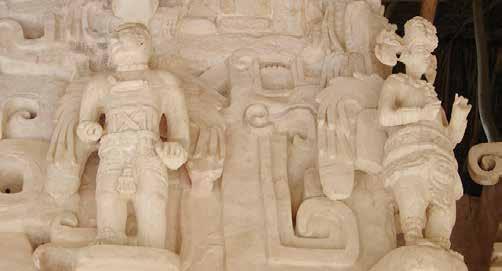
41 Destinations
M
MAYA ARCHAEOLOGICAL SITES
Dzibilchaltún
FOTO: CRALOS ROSADO
Ek Balam
FOTO: JUAN MANUEL MIER Y TERÁN C.
Alo largo de unos 40 km, la ruta Puuc comprende varios sitios que comparten una cultura, arquitectura y arqueología únicos en Yucatán. Fue declarada Patrimonio de la Humanidad por la UNESCO en 1996, y debe su nombre (Puuc, que significa cerro en maya) a que se ubica en la zona más alta de la Península. El nombre designa también al distintivo y muy ornamentado estilo arquitectónico de los sitios del área, que ofrecen, cada uno, un vistazo único a la maestría de la cultura maya. No es imposible visitar todos los sitios en un día, pero es más cómodo hacerlo en dos. Los domingos, los residentes nacionales están exentos de pago.
Labná (“Casa Vieja”): Su estructura más famosa, el Arco, es una joya del tallado en piedra por sus mascarones y figuras geométricas. Entrada: $70 pesos.
Xlapak (“Paredes Viejas”): Un sitio pequeño, cuyo edificio principal exhibe mascarones dedicados a Chaac, dios de la lluvia. Entrada: $70 pesos.
Sayil (“Lugar de las Hormigas”): Sobresale el Palacio, un edificio de tres niveles con más de 70 habitaciones, al igual que grabados y mascarones dedicados a Chaac en la fachada. Caminando entre la selva verás el Mirador, una estructura impresionante. Entrada: $70 pesos.
Kabáh (“Señor de la Mano Poderosa”): Es conocida por su imponente palacio tapizado de máscaras de Chaac. Sus construcciones principales son el Palacio, el Codz Pop y el Arco Maya. Entrada: $75 pesos.
Uxmal (“La Tres Veces Construida”): Este sitio (cuyo nombre se pronuncia ushmal) comprende varios edificios, todos con una asombrosa destreza artesanal en sus tallados y decoraciones. Siempre es buena idea recorrerla con un guía certificado para apreciar al máximo sus detalles y rincones ocultos. Además de su belleza de día, puedes visitarla de noche para disfrutar su video mapping, que abarca aspectos de la cosmogonía maya y la leyenda de la construcción de la ciudad.
UXMAL EN CORTO
· Horario: 8 am - 4 pm.
· Entrada: $531 pesos (extranjeros), $240 pesos (nacionales) y $90 pesos (residentes de Yucatán).
· Video mapping (diario): $719 pesos
· En el parador hay cafetería, tiendas de regalos y sanitarios.
A las afueras del sitio también se encuentran Choco-Story, Ecoparque Museo del Chocolate, que además de su recorrido por la historia del cacao y su importancia para el pueblo maya tiene una reserva ecológica. El Hotel Hacienda Uxmal, por su lado, ofrece restaurante y bar, además de recorridos a bordo de sus Land Rover vintage.
Para llegar: Hay tours a Uxmal saliendo todos los días; para la ruta necesitarás un tour privado o un auto. Checa opciones en nuestro listado en la página 36.
The Puuc route is a road (about 40 kilometers long) that connects several sites that share cultural, architectural, and archaeological aspects that are unique within Yucatán. The route itself was named a UNESCO World Heritage site in 1996, and owes its name to its location, on the hilliest point in the state (Puuc means “hill” in Maya). Puuc is also the name given to the distinctive, ornate architectural style of its archeological sites. It’s not impossible to visit then all in one day, but it’s far less exhausting to do it in two. Every site is listed with the translation of its Maya name below.
Labná (“Old House”): One of its most famous structures, the Arch, is an exquisite example of the Puuc-style geometric patterns and stonecarved masks. Entry fee: $70 pesos.
Xlapak (“Old Wall”): This site is located just 6 km from Labná. Although small, Xlapak features impressive masks dedicated to the rain god, Chaac. Entry fee: $70 pesos.
Sayil (“The Place of the Ants”): The main draw here is El Palacio, a three-story construction with over 70 rooms, decorated with carvings and masks honoring Chaac. In the jungle surrounding the site, you’ll find El Mirador (the lookout point), another impressive structure worth seeing. Entry fee: $70 pesos.
Kabáh (“Lord of the Powerful Hand”): This site is known for its palace, covered with Chaac masks made of carved stone. Other important structures here are El Palacio, El Codz Pop, and El Arco Maya (Maya Arch). Entry fee: $75 pesos.

Uxmal (“Three Times Built”): This site (whose name is pronounced ooshmal ) comprises several building, each of them boasting breathtaking detail in its carvings and decorations. It’s always a good idea to visit with a certified guide to fully appreciate its many hidden features. In addition to admiring it by day, you can also visit by night to enjoy its video map-
ping show, which covers aspects of the Maya world view and the legends behind the city’s construction.
Just outside the site, you can find Choco-Story, Chocolate Museum and Ecopark, which not only displays the history of cacao and its importance for the ancient Maya, but also serves as an environmental reserve. Hotel Hacienda Uxmal, also nearby, offers a bar and restaurant, plus tours of the area on vintage Land Rovers.
How to get there: Day tours to Uxmal depart Mérida daily; to do the full route you’ll need a private tour or a rental car. Check out options for both on our page 36.
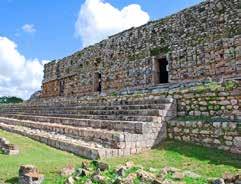
UXMAL IN FIGURES
· Hours: 8 am to 4 pm.
· Admission: $531 pesos (foreign visitors), $240 pesos (nationals), and $90 pesos (Yucatán residents).
· Video mapping (daily): $719 pesos.
· The visitor center includes a snack bar, gift shops, and restrooms.
42 Destinos
FOTO: JUAN MANUEL MIER Y TERÁN C. FOTO: JUAN MANUEL MIER Y TERÁN C.
Kabah
Labná
UXMAL / RUTA PUUC
bicada a 125 km de Mérida, Chichén Itzá, una de las siete maravillas del mundo moderno, es para muchos una visita obligada en Yucatán. Es el sitio maya mejor conocido por sus estructuras variadas y preservadas incluyendo el majestuoso Castillo de Kukulkán.
El nombre Chichén Itzá proviene de las palabras mayas: “Chi”, boca, “Chén”, pozo e “Itzá”, el nombre del pueblo que gobernaba esta región. En el sitio podrás observar una gran variedad de influencias arquitectónicas. De manera general, el sitio se divide en tres áreas: el Grupo Norte (con una clara influencia Tolteca), el Grupo Central (del periodo Temprano) y el que es conocido como Viejo Chichén (de estilo Puuc, pero que se encuentra cerrado para el público en general).
Entre las diferentes estructuras que se encuentran en Chichen Itzá, está el renom-
CHICHÉN ITZÁ EN CORTO
Abierto todos los días del año de 8 am a 4 pm. Entrada: $614 pesos (extranjeros), $272 pesos (mexicanos) y $90 pesos (locales). Entrada gratuita para mexicanos los domingos.
Espectáculo de luz y sonido: mar. - sáb. ($708 pesos) y dom. ($450 pesos). Boletos: www.nochesdekukulkan.com
brado Castillo de Kukulkán, protagonista principal durante los equinoccios de primavera y otoño; el Templo de los Guerreros, el Juego de Pelota, el Conjunto de las Monjas y el Caracol. También tienes que ver el Cenote Sagrado, donde se encontraron gran cantidad de ofrendas incluyendo cerámica, tela, oro, jade e incluso restos humanos. Es muy importante recordar que está estrictamente prohibido nadar aquí.
El parador está muy bien equipado con restaurantes, baños y tiendas de regalos. Desde el 2006, no se permite escalar ninguna de las estructuras de este sitio. Buena parte es accesible en silla de ruedas .

Para llegar: En automóvil, desde Mérida toma la carretera Mérida - Cancún de cuota (la forma más directa) y sigue los señalamientos hasta llegar a Chichén Itzá. Para llegar por autobus, ADO cuenta con varias salidas matutinas diarias para que puedas realizar tu visita. También puedes participar en alguna de las salidas diarias organizadas por una agencia de viajes.
ocated 125 km from Mérida, Chichén Itzá, one of the seven modern wonders of the world, is considered a must-see site in Yucatán. It’s without a doubt the best-known Maya archaeological site and part of what

makes it so special is its varied and well-preserved structures such as the Castillo de Kukulkán.
The name Chichén Itzá comes from the Maya words “Chi,” mouth; “Chén,” well; and “Itzá,” which was the name of the people that governed this region. At the site you will be able to observe a wide array of architectural influences; the site itself is generally divided into three areas: the north group (with a clear Toltec influence), the central group (from the early period), and what is known as Old Chichén (with Puuc-style constructions that remain closed to the general public.
The highlights include: the Castillo de Kukulkán, the Temple of the Warriors, the Grand Ball Court, the Nunnery, and the Observatory. Be sure to also take a look at the Sacred Cenote, where a large number of offerings were found including ceramics, fabrics, gold, jade, and even human remains. Just remember that swimming there is strictly forbidden.
At the main entrance you will find restaurants, bathrooms, and gift shops. Climbing any of the structures at this site has been forbidden since 2006.
A good part of this archeological site is wheelchair-accessible.
How to get there: By car, from Mérida, take the Mérida - Cancún toll highway (the most direct way), and follow the road signs to Chichén Itzá. By bus, catch one of the several morning departures at the ADO terminal. Many travel agencies also have daily departures (and tours) to the mighty Chichén Itzá.
CHICHÉN ITZÁ IN FIGURES
Open every day of the year from 8 am to 4 pm.
Entry: $614 pesos (foreign visitors), $272 pesos (Mexican citizens), and $90 pesos (locals).
Free admission for Mexicans on Sundays.
Video mapping: Tue. - Sat. ($708 pesos) and Sun. ($450 pesos).
Tickets: www.nochesdekukulkan.com
43 Destinations CHICHÉN ITZÁ
U L
El Castillo de Kukulkán
FOTO: JUAN MANUEL MIER Y TERÁN C.
as haciendas de México eran parte de un sistema económico iniciado por los españoles en el siglo XVI, similar al sistema feudal de Europa. Eran eficientes granjas y centros de manufactura que producían carne y otros productos para exportación. En Yucatán, las haciendas reforzaban el sistema de castas, basado en la raza, con los mayas como esclavos.
La mayoría de las haciendas yucatecas en el siglo XIX producían henequén, una variedad del cactus de agave, el cual era exportado por la creciente industria de transporte.

La casa principal era usualmente el edificio más grande, donde el hacendado tenía sus habitaciones centrales y donde ocurría la mayor parte de la administración.
El procesamiento de henequén tenía lugar en la casa de máquinas. Había usualmente una capilla, una casa del mayordomo en donde vivía el capataz y muchos otros edificios más pequeños para almacenamiento y habitaciones. Cada hacienda tenía una escuela, una enfermería, una tienda, una iglesia, un cementerio, un área hidráulica, una prisión y los establos.
Las haciendas de Yucatán llegaron a su apogeo a principios de 1900, cuando la economía local florecía gracias a la fibra de henequén usada para hacer soga, cuerda y cordel.
Hacienda Sotuta de Peón
Hacienda y Z. A. de Aké
Hacienda Mucuyché
Hacienda San Francisco Tzacalhá
Hacienda San Lorenzo Oxman
Hacienda Santa Cruz Palomeque
Hacienda Santa Rosa
Hacienda Santo Domingo de Yunkú
Hacienda Santuario Noc Ac
Hacienda Temozón Sur Hacienda Tepich
Hacienda Uxmal Plantation
Hacienda Yaxcopoil
Hacienda Zamná
Las casonas en el Paseo de Montejo y Avenida Colón en Mérida son las casas que el “oro verde”, el henequén, ayudó a proveer. Después de la Guerra de Castas en Yucatán y posteriormente la invención de fibras sintéticas, la mayoría de las haciendas fueron abandonadas, hasta la década de 1990, cuando muchas fueron restauradas a su gloria original.
Un viaje a Yucatán estaría incompleto sin visitar las haciendas del estado, ya que muchas de ellas han sido convertidas en hermosos hoteles de cinco estrellas, con elegantes cuartos, donde se sirven suntuosas cenas, con piscinas y magníficas tierras; otras haciendas son museos que proveen un vistazo a la época colonial; unas más están ocupadas por gente local, cuyos ancestros las reclamaron durante la Revolución Mexicana; y otras permanecen sin restaurar, abiertas a los daños del tiempo.
Visita www.yucatantoday.com/haciendas-yucatan para leer la versión extendida de este artículo.
• Carr. Tekik de Regil-Uayalceh
• Carr. Tahmek-Tixkokob
• Carr. Abalá-Telchaquillo
• Dzidzantún
Haciendas in México were the basis of an economic system that the Spaniards began in the 16th century, similar to the feudal system of Europe and the plantations of the southern U.S. They were efficient farming and manufacturing centers that produced meat and other products for export. The haciendas enforced a social system of castes, based on race, with the Maya as slaves. Most Yucatecan haciendas in the 19th century produced rope from Henequén (sisal), a variety of the agave cactus, which was exported for the booming shipping industry. The main house, or Casa Principal, was usually the largest building, where the Hacendado kept his living quarters and where the administration took place.
• Valladolid
• Mérida
• Maxcanú
• Carr. Mucuyché-Sacalum
• Carr. Mérida-Chuburná Puerto
• Abalá
• Acanceh
• Z.A. Uxmal
• Carr. Umán-Muna
• Carr. Baca-Timul
Henequén processing took place in the machine house, or Casa de Máquinas. There was usually a chapel, a Casa del Mayordomo, where the foreman lived, and many other smaller buildings for storage and living quarters. Each hacienda had a school, infirmary, store, church, cemetery, hydraulics area, jail, and stables.
The haciendas of Yucatán saw their heyday in the early 1900s when the local economy was booming due to the Henequén fiber that was used worldwide to make rope, cord, and twine. The mansions on Paseo de Montejo and Avenida Colón in Mérida are the rich homes the “green gold,” Henequén, helped provide. After the Yucatán Caste War and later the invention of synthetic fibers, most haciendas were abandoned to decay in the jungle until the 1990s, when many of them were brought back to their former state of glory.
Some haciendas in Yucatán have been renovated into beautiful five-star hotels, complete with elegant rooms, sumptuous dining facilities, swimming pools, and magnificent grounds. Other haciendas are museums, providing a glimpse into former colonial times. Others are lived in by locals whose ancestors reclaimed them during the Mexican Revolution; still others remain unrestored and open to the ravages of time.
Visit www.yucatantoday.com/haciendas-yucatanen to read the extended version of this article.

44 Destinos
L
HACIENDAS
TOURS • PASADÍA / TOURS • DAY PASS
Hacienda Sotuta de Peón
FOTO: TANIA LÓPEZ
rte sacro, sincretismo, historia y arquitectura colonial: esta ruta es para conocedores. La mejor forma de hacer este recorrido es en automóvil; las iglesias, en su mayoría del siglo XVI, no tienen horarios fijos de apertura; tendrás mejor suerte de martes a sábado, entre 8 y 10 am y de 4 a 7 pm.
Acanceh: Frente a la Plaza de las Tres Culturas (nombrada así por reunir las culturas maya, colonial y contemporánea) está la iglesia de Nuestra Señora de la Natividad y la capilla de la Virgen de Guadalupe. Aquí encontrarás también, justo a un costado, dos pirámides que puedes todavía escalar.
Tecoh: Éste es el sitio de una imponente iglesia en honor de la Virgen de la Asunción. Cuenta con mucha piedra labrada, un retablo maravilloso y varias pinturas, incluyendo una atribuida al renombrado artista novohispano Miguel Cabrera.
Telchaquillo: En la fachada de la iglesia dedicada a Nuestra Señora de la Concepción verás glifos mayas grabados y, sobre ellos, una imponente cruz que corona el templo. La iglesia es austera en su interior, pero cuenta con esculturas que sin duda te llamarán la atención.
Tekit: Visita la parroquia dedicada a San Antonio de Padua para admirar su vibrante retablo rojo y dorado; a un costado verás una estatua dedicada a este santo, a quien se le encomendó el pueblo y sus cosechas.
Mama: La iglesia en honor de Nuestra Señora de la Asunción cuenta con cinco capillas y, en un atrio cerrado, un colorido retablo con representaciones de distintos pasajes de la Biblia.
Chumayel: La iglesia de la Purísima Concepción alberga a un Cristo de madera negra que es muy venerado por considerarse muy milagroso, y que suele estar adornado con prendas donadas en agradecimiento por sus bendiciones.
Teabo: Entre muros y verdes jardines se erigen la parroquia y el exconvento dedicados
AL PLANEAR TU VIAJE, TOMA EN CUENTA
· Lleva monedas y billetes de baja denominación, ya que no siempre hay cambio.
· Hay pocos baños accesibles, así que aprovéchalos cuando estén disponibles.
- Agenda tu recorrido por el antiguo convento de Maní en direccionturismo2022@gmail.com

a San Pedro y San Pablo. En su retablo se representa la Pasión de Cristo con detalles impresionantes.
Maní: En este Pueblo Mágico encontrarás una de las iglesias más grandes del estado, dedicada a San Miguel Arcángel, y un histórico convento que precede al de Izamal. Reserva un recorrido ($35 pesos) para visitarlo y escuchar la historia del Auto de Fe que tuvo lugar aquí, infame por la destrucción de incontables documentos mayas. Aprovecha tu visita para conocer el Solar Maya U Lu’umil Kuxtal, los meliponarios U Naajil Yuum K’iin y Lool-Ha, las grutas con un pequeño cenote, y algún taller de bordado; prepara tu cartera, querrás llevarte todo a casa.
Religious art, syncretism, history, and colonial architecture: this route is not for the uninitiated. The best way to do this tour is by car. The churches, most of them dating from the 16th century, dont have a fixed schedule, so your best bet is to visit from Tuesday to Saturday between 8 am and 10 am, and from 4 to 7 pm.
Acanceh: You can’t miss the church of Our Lady of the Nativity or the chapel devoted to Our Lady of Guadalupe; another sight you couldn’t miss if you tried is the Maya pyramids right across the streets, which you can still respectfully climb.
Tecoh: This impressive church honors Our Lady of the Assumption. As it was built on top of a Maya temple, you’ll see plenty of engraved stone, a beautiful altarpiece, and several paintings, including one by renowned colonial artist Miguel Cabrera.
Telchaquillo: On the façade of the church of The Immaculate Conception you’ll see Maya glyphs and a large cross that crowns the temple. Inside, the church is modest, but it has several sculptures that will grab your attention.
Tekit: Visit the parish of San Antonio de Padua to catch a glimpse of its uniquely vibrant red and gold altarpiece; outside on the side street you can see a sculpture of this saint, charged with the protection of Tekit and its corn harvests.
Mama: This church also honors Our Lady of the Assumption. Inside there are five chapels and, within a closed atrium, you’ll find a colorful altarpiece with representations of different passages from the Bible.
Chumayel: The Immaculate Conception church houses a statue of Christ made of black wood that is very revered and known to grant difficult miracles; you’ll often see offerings at the statue’s feet.
Teabo: Surrounded by walls and sitting next to lush gardens, you’ll find the former convent of San Pedro y San Pablo (Saint Peter and Saint Paul). The altarpiece in this temple has images of the Passion of Christ with incredible detail.
Maní: This Magical Town is home to one of the largest churches in the state, devoted to St. Michael and a convent that predates the one in Izamal. Book a tour ($35 pesos) to visit and hear about the Auto da Fe that took place here, infamous for causing the destruction of most pre-Hispanic Maya documents and artifacts. While you’re here, visit Solar Maya U Lu’umil Kuxtal, the U Naajil Yuum K’iin and Lool-Ha native bee farms, the caves of Xcabachén, and an embroidery workshop.
WHEN PLANNING, KEEP IN MIND
· Bring cash in coins and small bills; there are no ATMs on this route.
· Restrooms can be scarce, make sure to use them when available.
· Book your tour of the former convent in Maní by emailing direccionturismo2022@gmail.com
45 Destinations RUTA DE LOS CONVENTOS • CONVENT ROUTE
A
Muna Hacienda Sotuta de Peón Hacienda Ochil Hacienda Teya Tecoh Telchaquillo Tekit Mama Z.A. Mayapán Xcanchacán Acanceh Hacienda Sta. Cruz Hacienda Petac Hacienda Yaxcopoil Umán Z.A. Aké Kanasín Mérida Cuzamá Homún Chunkanán Temozón Sur S. Antonio Mulix Ticul Oxkutzcab Dzan Sta. Elena Akil Tekax Teabo Chumayel Maní Tipikal Z.A. Uxmal Choco-Story Museo del Chocolate © YUCATÁN TODAY
Maní, Meliponario Lol Ha
YUCATÁN
FOTO:
TODAY
bicado a tan solo una hora de la capital, Izamal es uno de los Pueblos Mágicos de Yucatán. Notarás de inmediato que la conocida “Ciudad de los Cerros” está pintada de un amarillo brillante; hasta te parecerá que irradia felicidad. Por las distancias, Izamal es una ciudad ideal para recorrer en bicicleta.
Convento San Antonio de Padua: Te percatarás de su impresionante atrio de casi 8,000 m2. Es el atrio cerrado más grande de toda América. El convento, fundado por Fray Diego de Landa en 1549, se construyó sobre la base del templo maya Pap-Hol-Chac.
Nuestra Señora de Izamal (la patrona del estado que se celebra cada 8 de diciembre) pasa sus días dentro de un altar ornamentado de estilo barroco. Visita su camarín, un amplio y elegante cuarto donde los vestidos y accesorios de la Virgen son resguardados.
Arqueología: Dentro de la ciudad, la cultura maya vive; se pueden apreciar seis sitios arqueológicos: Kinich Kakmó (es el principal atractivo maya de Izamal y la pirámide más grande en superficie del estado), T’u’ul (El Conejo), Habuk, Itzamatúl (el cual pasó por tres etapas de construcción), Kabul y Chaltún Ha. El acceso es gratuito y puedes escalar las estructuras.
Centro Cultural y Artesanal: Una excelente parada para los amantes del arte. Podrás contemplar interesantes e innovadoras propuestas y escoger una pieza única para llevarte a casa (entrada $25 pesos).
Compras: Maravíllate con la tienda Hecho a Mano, llena de arte popular mexicano. Visita el taller de Don Esteban Abán, o adquiere artesanías y productos locales en la Plaza Constitución.
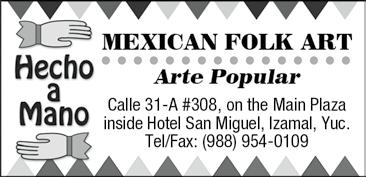
Ceremonia Maya: En el santuario del Hermano Maya podrás participar en diversas ceremonias o realizarte una limpia
Hospedaje: Hotel San Miguel Arcángel.
Cocina Regional: Kinich, Zamná o Los Arcos.
Video Mapping: Jue. - sáb. 8 pm, Parque de los Cañones, Izamal. Entrada: $104 pesos (mexicanos) y $149 pesos (extranjeros).
Para llegar: En coche deberás tomar la autopista Mérida - Cancún, desvíate en el km 48 hacia Izamal, duración aprox. 45 min en carro. En autobús, la terminal está en la Calle 67 x 50 y 52, con salidas cada hora. En van hay más salidas y precios económicos; el paradero está en la Calle 65 x 52 y 54
LO QUE NO PUEDE FALTAR WHAT YOU SHOULDN’T MISS
El Convento de San Antonio de Padua. Un almuerzo regional.
· El Video Mapping. La pirámide Kinich Kakmó. Una ceremonia maya.
· The San Antonio de Padua convent.
· A Yucatecan lunch.
· The Video Mapping.
· The Kinich Kakmó pyramid.
· A Maya ceremony.
Located one hour away from the capital, Izamal radiates happiness. You will immediately notice that the famous “City of Hills” is painted in bright yellow. Make your way through the market and begin your day with a regional breakfast at one of its diners.
Izamal is a perfect city to discover on foot or bicycle; always wear comfortable shoes.


Convent: A mandatory stop is the Convento de San Antonio de Padua (find guides at the entrance). Its impressive atrium measures almost 8,000 m2 and is the largest closed atrium on the continent. The convent, founded by Fray Diego de Landa in 1549, was built on top of the Maya temple Pap-Hol-Chac.
Inside the church itself, you will see the beautifully restored altarpiece, the stained-glass window of St. Francis of Assisi, and many statues along the walls. The second floor is where the statue of Our Lady of Izamal, Queen and Patron Saint of Yucatán, is housed.
Nuestra Señora de Izamal is celebrated every December 8. Visit her Camarín (dressing room) on the upper floor, an ample and elegant room where the Virgin’s elaborate dresses and accessories are kept.
Archaeology: Inside the city, Maya culture is front and center with six main sites: Kinich Kakmó (the main Maya attraction and the largest pyramid in the state sur- face-wise), T’u’ul (“The Rabbit” in Maya), Habuk, Itzamatúl (built in three stages), Kabul, and Chaltún Ha. Access is free and climbing the structures is allowed.
Centro Cultural y Artesanal: An excellent stop for art lovers to contemplate interesting and innovative artworks (entrance $25 pesos).
Shopping: Discover artisans’ talent at Hecho a Mano and be marveled by Mexican folk art. Visit Don Esteban Aban’s workshop. On Plaza Constitución you can buy a variety of handcrafts and local products.
Maya Ceremony: Another must is Hermano Maya’s sanctuary, where you can participate in traditional ceremonies, or even have a “cleanse” done to do away with bad luck.
Where to stay: Hotel San Miguel Arcángel.
Where to eat: Be delighted by exquisite regional food at Kinich, Zamná, or Los Arcos.
Video mapping: Thu. - Sat. 8 pm, Parque de los Cañones, Izamal. Entry fee: $104 pesos (Mexicans) and $149 pesos (foreigners).
To get there: From Mérida, take the toll highway towards Cancún and exit at km 48 towards Izamal at Hoctún exit. By bus, the terminal is on Calle 67 x 50 y 52, with departures every hour. Vans offer more departures; the stop is at Calle 65 x 52 y 54, Centro.
46 Destinos
U
IZAMAL
FOTO: JUAN MANUEL MIER Y TERÁN
Convento
Muchas riquezas hacen de Valladolid un Pueblo Mágico, como sus bellas calles e iglesias, su gastronomía y su gente. Lo que sobra en esta ciudad es paz, aunque no siempre fue el caso. Fundada en 1543, fue el escenario de vastas confrontaciones entre los conquistados y los conquistadores, desde la Guerra de Castas en 1847 a la Primera Chispa de la Revolución Mexicana en 1910. Hoy es una encantadora ciudad en la que vale la pena quedarse cuando menos un día.
La Calzada de los Frailes: Puedes pasar días recorriendo esta calle emblemática que se construyó en el siglo XVI para llegar al barrio de Sisal. Comienza en la esquina de las “cinco calles” y finaliza en el exconvento San Bernardino; ahí encontrarás varias boutiques y rincones para los amantes del café.
Sitios de Cultura: La Casa de los Venados es una parada esencial en tu visita. Una pareja estadounidense abre las puertas de su casona restaurada y comparte su colección de más de tres mil piezas de arte popular mexicano, la más grande en manos privadas. Están también los museos MUREM (Museo de Ropa Étnica Mexicana) y de San Roque, y la Casa Ramón Mendoza. Choco-Story, por su parte, te llevará por un recorrido fascinante por la cultura maya y su historia con el cacao.
San Bernardino de Siena: Visita el exconvento fundado en 1552 por los franciscanos que llegaron de Siena, Italia. No podrás resistir una sesión fotográfica tras otra, tanto en su magnífica fachada y sus jardines como en su interior color de rosa.
Barrios: La ciudad cuenta con seis de origen colonial, cada uno con su propia iglesia, encantador parque y atractivo: Santa Lucía,
Video mapping: todos los días, en español e inglés, en las paredes del ex-Convento San Bernardino de Siena. Entrada libre.
Para llegar: En auto desde Mérida, toma la carretera de cuota y sigue los letreros hacia Valladolid. Por autobús, hay salidas diarias desde la Terminal ADO Mérida Centro Histórico o de los Autobuses del Centro.
LO QUE NO PUEDE FALTAR
· Toma el tour gratuito todos los dias desde la plaza, verifica los horarios.
· Prueba los lomitos de Valladolid, la longaniza de Valladolid o el escabeche oriental.
· Nada en un cenote cristalino.
· Visita Ek Balam o Chichén Itzá.
There are quite a few riches that make Valladolid a “Pueblo Mágico,” such as its beautiful streets, churches, gastronomy, and people. What this town is not lacking is peace, though this was not always the case! Founded in 1543, it was the stage of vast confrontations between the Maya and the Conquistadores during events such as the Guerra de Castas (1847) and the first spark of the Mexican Revolution (1910). Today, Valladolid is a charming Yucatecan city worth a day-long visit, at the very least.
La Calzada de los Frailes: You can spend days strolling along this charming street built in the 16th century for access to the Sisal neighborhood. It starts at the corner of the Cinco Calles, and ends at the former convent San Bernardino de Siena. You’ll find boutiques and charming spots for coffee lovers.
Cultural Sites: Casa de los Venados is a must. An American couple opens the doors of their restored Casona and shares their more than 3,000-piece collection of Mexican folk artthe largest in private hands. The city is also home to MUREM (Museum of Mexican Ethnic Clothing), Museo de San Roque, Casa Ramón Mendoza and Choco-Story, a museum that takes you through Maya culture and its history with cacao.

San Bernardino de Siena: Head over to the former convent San Bernardino, founded in 1552 by the Franciscans from Siena, Italy. You won’t resist a photo shoot after another while visiting its magnificent façade, gardens, and pink and beautifully lit corridors.
Barrios: The town has six colonial neighborhoods, each with its own church, park, and particular charm: Sisal, Santa Lucía, Candelaria, San Juan, Santa Ana, and Centro.
Video mapping: available in English and Spanish, on the walls of the former convent San Bernardino de Siena. Free entry.
How to get there: By car from Mérida, take the Mérida - Cancún toll highway, and follow the road signs to Valladolid. By bus, there are daily departures from Terminal ADO Mérida Centro Histórico or from Autobuses del Centro.
CalzadadelosFrailes
WHAT YOU SHOULDN’T MISS
· Take the free walking tours starting at the main plaza every day at 10 am and 7 pm, (schedules may vary).
· Try the Lomitos de Valladolid, Longaniza de Valladolid, or the Escabeche Oriental.
· Swim in one of its many crystal-clear cenotes.
· Go to Ek Balam or Chichén Itzá.
47 Destinations
La Candelaria, Sisal, San Juan, Santa Ana y el Centro.
Cenote Dzitnup 7 km Chichén Itzá 40 km Calle 37 Calle 51 Calle49 Calle 45 Calle 45 Calle 33 Calle 41 Calle 36 Calle 40 Calle 54 Calle 48 Calle 39 Calle 35 Calle 43 Calle 38 Calle 46 Calle 50 Calle 52 Calle 42 Calle 44 ADO Iglesia de San Servacio Casa Ramón Mendoza Mercado Zací Choco-Story San Roque Santa Ana Casa de los Venados Le Muuch Convento de San Bernardino de Siena Autobuses de 2a.
Calle 34 Calle 34 Calle 47 Calle 47 Calle47 Cancún (Cuota) 156 km Mérida (Cuota) 160 km Hotel Olbil 300 m Tulum Libre 102 km Cancún Libre 160 km Museo de Ropa Étnica de México Calle 49 Video mapping © YUCATÁN TODAY
VALLADOLID
Casa de los Venados
FOTO: OLIVIA CAMARENA CERVERA
os caminos del sur de Yucatán te llevan a Tekax, una ciudad que guarda muchas anécdotas para contar, momentos históricos y sociales que ocurrieron durante la Guerra de Castas, así como alguna que otra leyenda.
Ubicada en la zona más alta de la Península, es también conocida como “La Sultana de la Sierra”. Se encuentra a poco más de hora y media de Mérida, y tiene todo un circuito que reúne historia, paisajes, cultura maya comunitaria, gastronomía, grutas y mucha aventura.

Edificios de Tekax: Destacan la iglesia dedicada a San Juan Bautista (construida en 1609) y la ermita de San Diego, ubicada al extremo sur sobre una colina. Puedes visitarla de martes a domingo; es inmejorable para obtener magníficas panorámicas y fotografiar la villa. También están La Capilla del Padre Eterno y La Casa de los Tres Pisos.
Grutas: Tekax cuenta con un sinfín de opciones de grutas para todos los niveles de destreza y valentía, aunque todas requieren el acompañamiento de un guía. Las grutas son operadas por tres cooperativas: Cooperativa Las Sartenejas II, Cooperativa Gruta Chocantes y Parque Ecoturístico Kaalmankal. Cada uno ofrece distintos servicios, como tirolesas, camping, senderismo y alimentos; es recomendable reservar con anticipación. Conoce más sobre las grutas yucatecas en la página 38.
Pirámides Mayas: Está la zona arqueológica de Chacmultún (“El Lugar de las Hormigas Coloradas” en maya) con muchos otros túmulos sin restaurar por todo alrededor.
El Tumbaito: Este trenecito recorre lugares icónicos en 30 minutos; $15 pesos. Horario: viernes, sábado y domingo de 6 a 10 pm.
PARA CONOCER MÁS
· Tekax era una importante región productora de licor de caña de azúcar.
· Aquí nació el trovador Ricardo Palmerín, co-autor de “Peregrina”, clásico de la canción yucateca.
· La Iglesia San Juan Bautista es la segunda más grande del estado después de la Catedral de San Ildefonso.
· En la puerta principal de la casa de tres pisos aún se pueden ver machetazos de la época de la Guerra de Castas.
Feria de Tekax: Del 8 al 13 de noviembre, la ciudad honra a su santo patrono: San Diego de Alcalá.
Dónde comer: No dejes de probar los famosos tacos de Us, la Cochinita del Alacrán Torres y el antojito Waj tu kit (también conocido como Kiwiwuaj).
Hospedaje: TecnoHotel Express en la entrada a Tekax; también puedes encontrar hoteles pequeños en el centro.
Para llegar: En automóvil conduce por la carretera Muna - Ticul - Oxkutzcab o por la nueva autopista “Nuevo Mundo Maya” (Mérida - Mayapán - Grutas de Loltún). En colectivo, la parada está en el Parque de San Juan (Calle 64 x 69 y 71).
The roads of southern Yucatán take you to Tekax, a city with many stories to tell, moments in history that go back to the time of the Guerra de Castas (Caste War), and local legends that just might turn this into your new favorite place to visit.
Tekax is located on the highest point of the peninsula, and is also referred to as the “Sultana of the Mountain.” It takes just over an hour and a half to drive from Mérida, and it has a series of attractions for different interests: history, landscapes, Maya communities, gastronomy, caves, and plenty of adventure!
Buildings in Tekax: Its colonial buildings include the parish devoted to St. John the Baptist (San Juan Bautista), built in 1609. The Ermita de San Diego is located on a hill at the southern end of town; open Tuesday through Sunday, it’s a great place to get a good view and pictures of Tekax. You can also visit the Chapel of the Eternal Father and La Casa de los Tres Pisos (the three-story house).
Caves: Tekax boasts endless cave options for every level of skill and bravery, though all of them require a guide. The caves here are operated by three separate co-ops: Cooperativa Las Sartenejas II, Cooperativa Gruta Chocantes and Parque Ecoturístico Kaalmankal.
Each offers different services, including zip lines, camping, hiking, and meals; it’s always better to book in advance. Find out more about caves in Yucatán on page 38.
Maya pyramids: There is a Maya site called Chacmultún (“The Place of the Red Ants”). There are many other unrestored mounds over the area.
El Tumbaito: This little train takes you on a 30-minute ride through iconic corners of Tekax for $15 pesos. Hours: Friday, Saturday, and Sunday from 6 to 10 pm.
Tekax fair: From November 8 to 13, the village honors its Patron Saint during the San Diego de Alcalá fair. In addition to religious celebrations, you’ll see parades, bullfights, fireworks, dances, and mechanical rides.
Where to eat: Be sure to try the famous tacos of Us, the Cochinita del Alacrán Torres, and the antojito Waj tu kit (also known as Kiwiwuaj).
Where to sleep: The Technohotel Express at the entrace to Tekax, or a small hotel downtown.
How to get there: You can get to Tekax via rental car, bus, or the collective transportation that is located on the San Juan Park in Mérida. If you drive yourself, you can take the Muna - Ticul - Oxkutzcab route or the new Mundo Maya Highway that goes from Mérida to Mayapán and the Loltún Caves.
· Tekax was an important sugar-caneliquor-producing region.
· It’s the birthplace of Ricardo Palmerín, co-author of “Peregrina,” a Yucatecan classic.
· The San Juan Bautista Church is the second largest in the state after the San Ildefonso Cathedral.
· At the entrance of the three-story house you can still see machete strikes from the Caste War.
48 Destinos TEKAX TO LEARN MORE
FOTO: YUCATÁN TODAY L
Caricoa Cacao

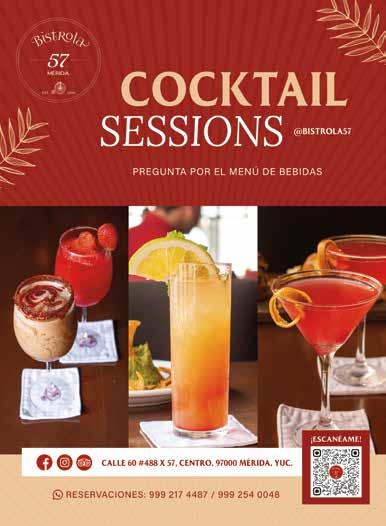


isal: Es uno de los pueblos mágicos de Yucatán, y el único que se encuentra en la costa. Desde el siglo XVI se convirtió en el principal puerto del estado y el punto de entrada y salida de mercancía y viajeros, incluida la emperatriz Carlota de México en 1865. Sin embargo, el fuerte de su volumen de carga estuvo en el henequén, que de hecho es conocido como “sisal” en el extranjero debido a que las cajas que lo contenían traían el sello de este puerto.
Visita el muelle y el Fuerte de Santiago; la pequeña plaza te invita a tomarte fotos con los cañones y sillas confidentes. En la ex-Aduana, edificio histórico que hoy alberga una biblioteca, encuentras una amplia oferta de actividades para todas las edades e intereses: buceo, pesca deportiva y artesanal, avistamiento de aves, pasadías en la bocana, en el manglar y en los petenes, visitas al ojo de agua, snorkel en el arrecife, barcos y cañones hundidos (únicos en la zona), tours especializados en fotografía de aves, flamencos o cocodrilos, senderismo (a pie o en bicicleta) o paseos a caballo por la playa. Todas están disponibles a través de guías locales certificados.
Para una estancia más relajada, pasa el día en sus amplias playas, visita el muelle y disfruta de los pescados y mariscos que se ofrecen en sus restaurantes.
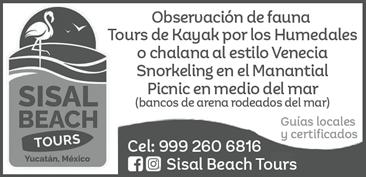

Celestún: Celestún es considerado desde 1979 como Patrimonio Mundial de la Reserva Especial de la Biósfera. Aquí, de noviembre a marzo, encontrarás una de las colonias de flamencos rosados más grandes del mundo. Estos factores son la razón por la que miles de visitantes de todas las edades vienen a este puerto localizado a 96 km de Mérida.
La forma más segura de avistar aves y apreciar la belleza natural de este puerto es mediante un un tour en lancha. En la entrada del puerto encontrarás un parador con estacionamiento, baños, tienda y el embarcadero. El paseo tiene una tarifa fija de $2,200 pesos por lancha, con cupo para hasta seis personas adultas (o cuatro adultos y dos niños). El tour dura poco más de una hora e incluye la visita a la zona de flamencos, el recorrido por el manglar y el acceso al ojo de agua Baldiosera, donde puedes bañarte.
Por tu propia seguridad y la de la naturaleza, asegúrate de contratar tu tour únicamente con guías certificados.
Para llegar desde Mérida: En auto, toma la salida a Tetiz desde Periférico; para ir a Sisal tomarás la desviación hacia Hunucmá. En ambos casos, el viaje durará aproximadamente una hora. En autobús, las salidas a Sisal son desde la terminal 50 (Calle 50 x 65 y 67, Centro), diariamente a las 5 pm y los regresos a las 6 am; los domingos hay una corrida adicional que sale a las 8:30 am y regresa a las 6 pm. A Celestún puedes ir en taxi colectivo (Calle 67 x 48 y Av. Primero de Mayo, Centro); el viaje dura aproximadamente 75 minutos. No hay horarios fijos de salida, pero cuestan alrededor de $65 pesos.
isal: It’s one of Yucatán’s four Magical Towns, and the only one by the beach. Back in the 16th century, it became the state’s main port and sole entry point for visitors, including Empress Carlota de México in 1865. Sisal was also where Henequén fibers were exported from Yucatán to points all over the world; the port’s stamps on the cargo boxes are the reason the fiber is known worldwide as sisal.
Visit the pier and the Fort of Santiago; the square is perfect for photos with authentic cannons and traditional confidant chairs. At the former Customs Office, you will find information on a variety of activities for all ages and interests: snorkeling, scuba diving, sport and artisanal fishing, bird watching, day tours to the estuary, the mangrove, and the freshwater spring, tours to see the sunken ships and cannons (unique in this region), hiking and bike rides, and even horseback riding on the beach. All these activities are available with certified tour guides.
For a more relaxed stay, spend the day on its sandy beaches, walk along the pier, and enjoy the fish and seafood offered at its many restaurants.
Celestún: Celestún was appointed World Heritage Biosphere Reserve in 1979; here, especially between November and March, you’ll find one of the largest pink flamingo colonies in the world. Any of those may be the reasons why thousands of people make the hour-long trip to this port every year.
The best way to see the birds and appreciate Celestún’s natural beauty is taking a boat tour. As you’re driving into town, just by the bridge, there’s a visitor center with parking, restrooms, a store, and a dock. You can hire the tour at a fixed rate of $2,200 pesos for up to six adults (or four adults and two children). The tour lasts a little over an hour and includes a visit to see the flamingo colony, an expedition through the mangrove, and access to the Baldiosera water spring, where you can swim.
For your own safety and that of the local wildlife, make sure to hire your tour from licensed guides only.
How to get there: By car, take the Tetiz exit on Periférico (it goes all the way to Celestún) and follow the signs; for Sisal, you’ll take the detour to Hunucmá. Both trips are roughly an hour drive. By bus to Sisal, Autobuses Oriente (Calle 50 x 67, Centro) offers one daily departure to Sisal leaving at 5 pm, and from Sisal to Mérida at 6 am. On Sundays, there is an additional run leaving Mérida at 8:30 am and Sisal at 6 pm. To Celestún, a shared van (Calle 67 x 48 y Av. Primero de Mayo, Centro) trip is about $65 pesos. There aren’t set schedules; vans leave as they fill up.
49 Destinations
S FOTO: CASSIE PEARSE
SISAL / CELESTÚN
S
Sisal
rogreso de Castro es hoy en día uno de los puertos más reconocidos de México, y sin duda el más importante de la Península de Yucatán. Sin embargo, a comparación del resto del estado, es una población bastante joven: se fundó en 1871 por la necesidad de trasladar la aduana, que entonces estaba en Sisal, a un lugar más cercano a Mérida. Su muelle, que data originalmente de los 1930s, comenzó midiendo 2 km de largo; la poca profundidad del Golfo de México ha dado lugar a ampliaciones y extensiones que lo han llevado a ser el más largo y de los más icónicos del mundo, con 6.5 km de longitud.
Progreso ofrece oleaje tranquilo y seguro para nadar o sólo disfrutar la playa. Puedes ir temprano para ocupar lugar en un restaurante o un club para disfrutar todo el día en la playa, o dedicarte a recorrer el Malecón y detenerte en las distintas atracciones que ofrece para todas las edades. En cualquier caso, seguro lo pasarás muy bien.
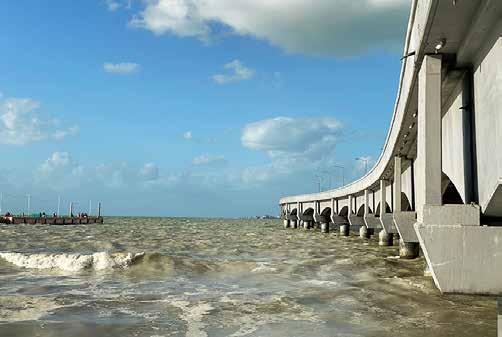
Progreso ofrece cada vez más cosas para deleitar a visitantes y residentes; aquí te compartimos una probadita de algunas.

Malecón Tradicional: Del lado derecho del muelle (viendo hacia el mar), verás espacios icónicos, como La Casa del Pastel o las letras de Progreso, y varios restaurantes que tienen vista al mar.
Malecón Internacional: Al lado izquierdo del muelle encontrarás juegos para niños, un jardín de lectura, cine al aire libre, carrusel, rueda de la fortuna, baños y muchas estatuas con las que te divertirás posando para una foto. Es perfecto para visitarlo a cualquier hora, sin embargo, en la tarde es particularmente agradable.
Museo del Meteorito: ¿Sabías que una buena parte de Yucatán se encuentra en el cráter de impacto del meteorito que acabó con los dinosaurios hace 65 millones de años? Progreso ahora cuenta con un museo
interactivo que te llevará por la historia del planeta, incluyendo las varias extinciones masivas, la vida de los dinosaurios y las consecuencias del impacto que les puso fin.
Además de ser una experiencia educativa fascinante, las mega esculturas de distintos tipos de dinosaurios serán un hit entre chicos y grandes. Consulta sus tarifas en nuestra página 10.
Qué comer: Lo más típico son los ceviches y el pescado frito (disponibles en varios restaurantes), pero las opciones son infinitas. ¿Te gustaría comer con vista al mar? Acércate a Crabster, Eladio’s, Almadía, El Ha Guay o Mobula. Si buscas un espacio más allá del Malecón, están Silcer Club de Playa, La Antigua y Yum Ixpú.
Comida callejera: Si eres aventurero, anímate a probar los dulces de las bandejas que llevan de un lado a otro de la playa: los hay de coco, pepita, cacahuate y merengues, además de paletas y caramelos.
Otras golosinas que te ofrecerán en la playa son vasos de fruta con chile, helados y granizados, además de cocos fríos. Por la tarde, asegúrate de probar también una marquesita, un esquite, o un elote preparado para realmente disfrutar de Progreso como los yucatecos.
Ecoturismo: Visita la Reserva Ecológica El Corchito para ver manglares, ojos de agua y la flora y fauna de la costa. Otra opción es la Ría de Progreso, en donde, además de ver familias pescando con cordel, puedes realizar tours en kayaks dentro de los manglares, practicar stand-up paddle, o solamente pasear.
Más puntos de interés: Visita Pig Beach entre 8 am y 6 pm para ver a los cerditos;
50 Destinos
P PROGRESO
FOTO: YUCATÁN TODAY
míralos nadar (¡o acompáñalos!) de jueves a domingo entre las 12 y la 1 pm. Complementa tu visita con una clase de kitesurf, o visitando el Sendero Jurásico en Chicxulub (detalles en la pág. 53).
Para llegar: Manejando desde Mérida, sólo sigue al norte en la Calle 60 o Paseo de Montejo hasta llegar a Progreso. En autobús, Autoprogreso opera desde las 5 am hasta las 10 pm. Puedes tomarlo desde la terminal (Calle 62 x 65 y 67) o en cualquiera de las paradas a lo largo del trayecto entre Mérida y Progreso.
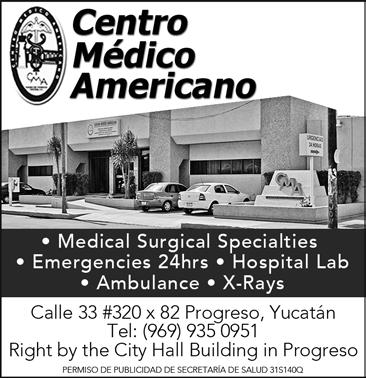
Progreso de Castro is, nowadays, one of México’s most recognizable ports, and, without a doubt, the most important ports in the Yucatán Península. However, it’s a rather young settlement compared to other places in the state: it was founded in 1871, with the explicit purpose of avoiding the longer travel time to the more historical port of Sisal. The Progreso dock was originally built in the 1930s, measuring 2 km (1.3 mi). The shallow waters of the Gulf of Mexico have given way to extensions that have led to it becoming the longest in the world (as well as one of the most iconic), currently 6.5 kilometers (4 miles) long.
Progreso usually offers small, gentle waves that are safe for swimming or just enjoying the beach. If you’re there early, you can get yourself a table at a restaurant or beach club to enjoy a full day at the beach, or spend it strolling down the Malecón (boardwalk), leisurely stopping at the many attractions it offers for people of all ages. You’ll have a great time either way.
The number of sights and attractions available here never stops growing; here are a few:
Malecón Tradicional (Traditional Boardwalk): On the right side of the pier, overlooking the sea, you will catch several landmarks, such as the Casa del Pastel (you can’t miss it, it looks like a three-layer cake!), the Progreso giant letters which you can take lots of pictures with, and restaurants with a stellar view of the Gulf of México.
Malecón Internacional (International Boardwalk): To the left of the pier (if you’re facing the sea), there are several attractions such as playgrounds, a reading garden, an outdoor cinema, a carrousel, a Ferris wheel, bathrooms, and lots of cool statues you’ll have tons of fun taking pictures with. It’s perfect for a visit anytime, but late afternoons (and the sunset) tend to be the highlight of the day.
Meteorite Museum: Did you know that a good portion of Yucatán is inside the impact crater left behind by the meteorite that killed the dinosaurs 65 million years ago? Progreso now has an interactive museum that will give you a tour of the history of the planet, including the various mass extinction events, the life of the dinosaurs, and what exactly happened when the meteor struck.
It’s a fascinating educational experience on its own, but the different types of dinosaur sculptures will impress children and adults alike. Check out the museum’s rates on page 10.
What to eat: Locals’ favorite dishes include fresh ceviche and fried fish, but options are endless, for both restaurants and dishes. Are you looking for a place to eat with a nice view of the beach? Go to Crabster, Eladio’s, Almadía, El Ha Guay, or Mobula. If you are looking for a place beyond the boardwalk, you could try Silcer Club de Playa, La Antigua, or Yum Ixpú.
Fun Street Food: If you’re feeling really adventurous, try the candy sold on trays that are carried up and down the beach; you’re guaranteed to see at least one vendor. There are coconut, pumpkin seed, and peanut options, as well as meringues and caramels in all shapes, colors, and sizes.
Other daytime vendors include baggies or cups of tropical fruit (dressed with powdered chili to taste), ice cream and shaved ice, and cold coconuts. In the afternoons, Marquesitas and dressed corn (both in cups or on the cob) are additional options to really enjoy Progreso like the locals.
Ecotourism: Visit El Corchito Ecological Reserve to see mangroves, springs, and the coastline’s plants and wildlife. Another great option is the Ría de Progreso, where, in addition to seeing local families line-fishing, you can do many activities like taking mangrove tours; there’s also a rowing area where you can rent kayaks and canoes to get a low-impact workout out in nature .
Additional attractions: Visit the piggies at Pig Beach between 8 am and 6 pm; stop by Thu. - Sun. 12 - 1 pm if you want to see them swim (or join them!). Feeling adventurous? There are several kitesurfing schools that offer beginner lessons. For additional dino-fun for kids, visit Sendero Jurásico (details on page 53).
How to get there: Driving from Mérida just go north until you reach Progreso. You can’t miss it! By bus, the Autoprogreso bus leaves every 10 minutes between 5 am and 10 pm. You can take it at the terminal (Calle 62 x 65 y 67) or at any of its stops along the road to Progreso.
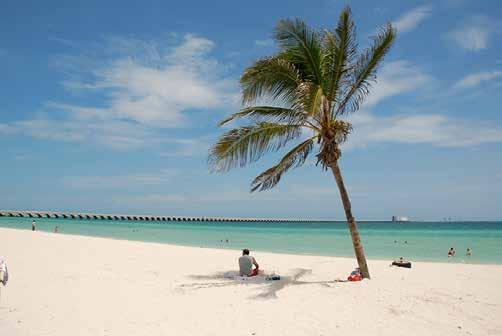
51 Destinations
FOTO: JUAN MANUEL MIER Y TERÁN C.
PROGRESO
P
Cómo llegar: Toma la desviación hacia Chelem en la carretera Mérida a Progreso y sigue hacia el oeste; también puedes tomar la nueva carretera a través de Sierra Papacal.
Chelem: Este tranquilo poblado se encuentra 10 kilómetros al oeste de Progreso, pero separado del mismo por el puerto de abrigo y varias marinas. Cerca de la plaza principal, encontrarás minisúpers, un centro de salud, un mercado y una parada de colectivos que viajan desde y hacia Progreso.
Chelem tiene una cantidad sorprendente de restaurantes de comida regional e internacional; también hay múltiples restaurantes familiares que sirven pescados y mariscos frescos. De postre, detente en cualquier puesto de cocos para probar alguna de las múltiples presentaciones que manejan.
Chicxulub Puerto: Este pequeño pueblo pesquero está 7.5 km al este de Progreso. Su nombre se hizo de fama internacional en los últimos años, pues al ser el poblado más cercano al punto de impacto del meteorito que acabó con los dinosaurios hace unos 65 millones de años, el cráter ahora lleva su nombre. Aunque el Museo del Cráter de Chicxulub se encuentra en Progreso (más información en la pág. 50), aquí encontrarás el Sendero Jurásico, una experiencia interactiva a lo largo de tan sólo unos cuantos metros. Si tienes el tiempo contado, toma en cuenta que puedes ver las enormes efigies desde el libramiento (la carretera contigua a la ría).
Cómo llegar: Puedes desviarte hacia el este justo antes de llegar a Progreso, o tomar la ruta directa, desviándote desde la carretera Mérida - Motul.
T
La Ría de Chelemhe ports of Chuburná, Chelem, and Chicxulub are among visitors’ favorite beach destinations, one reason being their proximity to Progreso. At Easter and summer, you might think everyone in Mérida has moved here. In the winter, they’re all popular snowbird destinations.
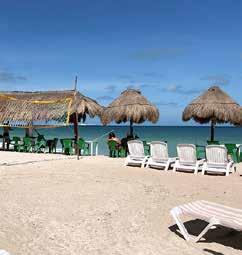
Chuburná Puerto: This tiny village, 20 kilometers west of Progreso, is the westernmost point of Yucatán’s main coastal road. It is also home to Playón Las Dunas, a large expanse of beach that would seem to be endless. On weekends, you’re bound to find locals having picnics at El Playón, as well as kitesurfers making the most of all that space.
How to get there: Take the detour to Chelem from Carretera Mérida - Progreso, and keep going west; if you’re coming from the city’s west, there is also a new road that goes through Sierra Papacal.
Chelem: This little port is located 10 kilometers west of Progreso, just across the harbor and several marinas. Around the main square, you’ll find small supermarkets, a health center, a lo-

cal market, and a Colectivo (van) stand offering transportation to and from Progreso.
Chelem has a surprising number of restaurants serving both local (mainly seafood) and international style meals. For dessert, stop at a coconut stand to try one of their many sweet specialties.
Chicxulub Puerto: The name of this fishing village, just 7.5 kilometers east of Progreso, is pronounced cheek-shoo-loob. It is also a name known around the world, as the crater left by the meteorite that wiped out the majority of dinosaurs 65 million years ago bears its name, due to its proximity to the epicenter. While the Chicxulub Crater Museum is actually by the Malecón in Progreso (see p. 51), here you’ll find the Sendero Jurásico (Jurassic Trail), an interactive experience several meters long. If you don’t feel like stopping, you can take a look at the dinosaur effigies from the road along the estuary.
How to get there: Follow the signs to turn east just before you enter Progreso; you can also take a direct route from the Mérida - Motul road, exiting right before you get to Conkal.
52 Destinos
Calle 17 Calle 24 Calle 22 Calle 20 Calle 18 Calle 19 Calle 23 Calle 27 Calle 25 Chuburná Puerto 10 km RÍA DE CHELEM
Calle 28 Calle 30 Calle 21
Yucalpetén 5 km Progreso 12 km Golfo de México
Área de Flamencos Flamingo Area Mercado Plaza / Main Plaza
Ojo de Agua / Natural Water Spring Embarcadero / Wharf Autobuses
or su proximidad a Progreso, los puertos de Chuburná, Chelem y Chicxulub se encuentran entre los predilectos de visitantes de todas partes. Durante Semana Santa y verano, podrías creer que todos los habitantes de Mérida se encuentran en estas tres poblaciones; en el invierno, te encontrarás sobre todo extranjeros huyendo del frío.
Chuburná Puerto: Este pequeño poblado, 20 kilómetros al oeste de Progreso, marca el inicio de la carretera costera. Chuburná es el hogar del Playón Las Dunas, una larga extensión de playa que parece no tener fin. Este tramo de playa es muy frecuentado por los yucatecos, que disfrutan hacer picnics, y kitesurfistas buscando sacar el máximo provecho al espacio disponible.
FOTO: YUCATÁN TODAY FOTO: YUCATÁN TODAY CHUBURNÁ PUERTO / CHELEM / CHICXULUB PUERTO
Chicxulub
ntre 40 y 80 kilómetros al este de Progreso, sobre la costa, se encuentran tres poblados que ofrecen cada uno un gran rango de atractivos y actividades que te encantarán. Elige uno o visítalos todos; cada uno tiene algo mágico qué mostrarte.
Telchac Puerto: Telchac es conocido por su amplia extensión de dunas, que lo hacen ideal para disfrutar la playa y nadar en el mar. En el centro del poblado hay un muelle desde donde los telchaqueños pescan con cordel, y tiendas y restaurantes que ofrecen variedad de mariscos y dulces de coco para todos los gustos. La oferta hotelera va desde casas completas (que se pueden rentar por días, semanas e incluso meses) hasta habitaciones de hotel.

San Crisanto: En este pequeño pueblo, a 10 km de Telchac Puerto, las vocaciones principales son la pesca y el cultivo de coco. Pasa el día en el balneario Zac-Ha; hay palapas, baños, regaderas, área de estacionamiento y espacio para acampar. (pasadía: $110 pesos por persona, de 9 am a 5 pm;. campamento: $180 pesos por persona). También puedes hospedarte en las cabañas ubicadas un kilómetro más adelante, disponibles con previa reservación.
San Crisanto cuenta con un proyecto sustentable que reúne a los pobladores en actividades turísticas, artesanales y de conservación; parte del mismo consiste en paseos por el manglar en barcas sin motor que finalizan con una visita a un ojo de agua dulce ($110 pesos por persona).
Dzilam de Bravo: Aunque no tiene playa, este puerto pesquero, el último de la carretera costera, es ideal para hacer tours, incluyendo un enorme ojo de agua en el mar que vale la pena el viaje. Los lugares a visitar en los tours son las Bocas de Dzilam, Punta Arena, playa El Cielito, el famoso ojo de agua Xbuya-Ha, el cenote Elepetén y las piedras de Chacaltún para hacer snórkel. También hay tours especializados para hacer pesca deportiva o avistamiento de aves. No dejes de checar los tours de bioluminscencia, disponibles todo el año en las condiciones adecuadas (E Tico’s Tours).
Cómo llegar: En autobús, desde Mérida, por Autobuses del Noreste (Calle 67 x 50, Centro). Desde Progreso también hay varias salidas en combis y autobuses.
ACTIVIDADES CERCANAS
· Sayachaltún: Paseos ecoturísticos en el manglar.
· X’Cambó: Una de las zonas arqueológicas más extensas de Yucatán, y la única que se encuentra en la costa.
· Xtampú: Salinera comunitaria donde es posible ver lagunas rosadas.
· Más información en la página 40.
Between 40 and 80 kilometers (25 and 50 miles) east of Progreso, also on the coast, you’ll find three villages that offer fun and plenty of activities you’ll enjoy for sure. Pick one or visit them all; you’ll find each onehas something incredible to offer.

Telchac Puerto: Telchac is known for its wide, sandy beaches, perfect for both sunbathing and swimming. The village has a dock from where Telchaqueños practice line fishing, as well as shops and restaurants with a variety of seafood and coconut-based delicacies. Lodging options include houses (which you can rent by the day, week, or even for months at a time) as well as hotel rooms.
San Crisanto: The San Crisanto beaches are some of the less visited by tourists, which means more space to enjoy yourself. The beach club Zac-Ha offers different services like Palapas, restrooms, showers, a parking area, and camping space (Day passes: $110 pesos per person, 9 am - 5 pm; overnight camping: $180 pesos per person). You can also spend the night at the cabins located a kilometer away, by prior reservation only.

Through a sustainable project that fosters local tourism, handcrafts, and biodiversity conservation activities, locals offer mangrove tours on a man-powered boat, including a swim in a crystal-clear, freshwater spring ($110 pesos per person).
Dzilam de Bravo: Despite not having a proper beach, this fishing town (the last one on the coastal road) offers an endless number of tours, including one to a freshwater spring in the ocean that make the trip worth it. Ask about tours to Bocas de Dzilam, Punta Arena, El Cielito beach, the famous Xbuya-Ha freshwater spring, the Elepetén cenote, and snorkeling in Chacaltún, as well as fishing and birdwatching tours. Stunning bioluminescence tours are also available year-round. For more information, check out E Tico’s Tours.
How to get there: Autobuses del Noreste (Calle 67 x 50, Centro) offers bus options from Mérida; from Progreso, you can get there by van or bus.
NEARBY ACTIVITES
Sayachaltún: Environmentallly friendly tours of the mangrove.
X’Cambó: One of the largest, oldest archaeological sites in Yucatán, as well as the only one on the coast.
Xtampú: A community salt mine where the lagoons turn bright pink depending on the mining process More information on page 41.
53 Destinations
E
FOTO: YUCATÁN TODAY FOTO: YUCATÁN TODAY
Dzilam de Bravo Telchac
© YUCATÁN TODAY TELCHAC PUERTO / SAN CRISANTO / DZILAM DE BRAVO
Buscas rincones más retirados? En el noreste de Yucatán te esperan dos destinos que te ofrecen bellos paisajes y un ambiente tranquilo.
Tizimín: Esta ciudad, cuyo nombre viene de Tsíimin, la palabra maya para el “tapir” (el animal sagrado y totémico del dios supremo de los mayas), fue fundada por los padres franciscanos que venían con los conquistadores en 1544. Curiosamente, con la llegada de los españoles, la que era la tierra de los tapires se fue convirtiendo en la tierra de los caballos, que, por lo alargado de su cara, también se llaman Tsíimin en maya.
Además de una activa industria de aserradero, la tierra fértil de Tizimín mantiene los pastos y granos para el ganado; es aquí que encontrarás el grueso de esta actividad en el estado. Esto se refleja no sólo en la vestimenta y costumbres de sus habitantes, sino en sus tradiciones gastronómicas, que incluyen más platillos a base de res y carnero.
Actividades: Visita el Parque Ecológico El Monte y el poblado de San Manuel km 11 para actividades de ecoturismo con la familia. Para un chapuzón en algún cenote, visita el Cenote Kikil. También podrás visitar la Laguna Nachi Cocom. Y si no quieres salir de la ciudad, te esperan el Salón de Arte e Historia y su centro.Las pirámides mayas más cercanas incluyen Ek Balam y la casi desconocida Kulubá, ubicada al suroeste de Tizimín.
Cómo llegar: En autobús desde la terminal Noreste se ofrecen dos salidas diarias; también hay taxis colectivos (Calle 52 x 65 y 67) que ofrecen salidas cada 75 a 90 minutos.
El Cuyo: Conocido como el tesoro escondido de la Costa Esmeralda de Yucatán, es una pequeña comunidad playera donde disfrutarás de un ambiente típico y tranquilo de un pequeño puerto que te invita a
relajarte y disfrutar la hermosura de la naturaleza. El pueblo conserva su arquitectura tradicional: coloridas casas hechas de paneles de madera con palapas y techos bronceados por el sol, y ofrece también un sinfín de actividades acuáticas.
Este paraíso está situado en la Reserva Especial de la Biósfera de Ría Lagartos, la cual es internacionalmente famosa por los 20,000 flamencos rosados que anidan en ella entre enero y septiembre. También podrás observar más de 250 diferentes especies de aves que visitan la zona.
Actividades: Puedes conocer el faro, rentar cuatrimotos, contratar un carrito de golf, hacer kitesurfing y descansar. Dirígete hacia la arena o al pequeño puerto para observar el majestuoso atardecer al norte de la costa de Yucatán.
Cómo llegar: Para llegar en automóvil desde Tizimín, dirígete al este hasta Colonia Yucatán, y luego al norte hasta El Cuyo. Si vas en transporte público, hay autobuses que van de Tizimín a El Cuyo pasando por Colonia Yucatán.
ooking for more secluded corners? Two destinations with beautiful sights and plenty of peace await in northeast Yucatán.

Tizimín: This city, whose name comes from Tsíimin, the Maya word for tapir (the sacred and totemic animal of the supreme Maya god), was founded by Franciscan friars in 1544. Interestingly, after the Europeans’ arrival, the land of tapirs became the land of horses, which were also named Tsíimin in Maya because of their long, tapir-like faces.
Besides an active timber industry, Tizimín’s fertile land supports pasture and grain for livestock, which is the main driver behind its booming economy. This is easily seen not only
in locals’ dress and habits, but in their food, which include more beef- and lamb-based dishes.
Tizimín offers comfortable hotels, restaurants with varied cuisine, such as Casa Makech, and travel agencies promoting tours to nearby sites. Between December and January, you’ll find the city transformed by the celebration of its patron saints, the biblical Magi. The festivities include masses, pilgrimages, parades, vaquerías, cattle exhibits, agricultural, industrial, and commercial exhibits. Plan ahead if you’d like to visit, as accommodation can be scarce this time of the year.
Activities: Visit the Parque Ecológico El Monte and the village of San Manuel km 11 for ecotourism activities (for all ages!). Looking for a cenote in the area? Go to Cenote Kikil. Also in the area: the Nachi Cocom lagoon. If you don’t want to leave the city, the Art and History Hall and its city’s Centro are a perfect option. Nearby Maya pyramids include Ek Balam and the almost unknown Kulubá, located southwest of Tizimín.
How to get there: By bus, Terminal Noreste offers two daily departures. There are also shared vans (Calle 52 x 65 y 67, Centro) leaving every 75 to 90 minutes.
El Cuyo: Known as Costa Esmeralda’s hidden treasure, El Cuyo is a small beach community where you’ll enjoy the tranquil ambiance of a small port. Everything about it invites you to relax and enjoy the beauty of nature. For the most part, the village conserves its traditional architecture: colorful rooms made from wooden slabs or concrete, topped off with palapas and sunburned concrete roofs.
This paradise is nestled in the Ría Lagartos Special Biosphere Reserve, which is internationally famous for the 20,000 pink flamingos that nest there between January and September every year. With more than 250 different birds visiting Río Lagartos, it is also a fantastic place for birdwatching.
Activities: Check out the lighthouse, take rides on quad bikes, hire golf carts, kitesurf, and chill out here. Head to the beach or small pier to take in the majesty of the sun setting along the north coast.
How to get there: From Tizimín, go east towards Colonia Yucatán, and then north to El Cuyo; refer to our map of the Yucatán peninsula for details. By public transportation, buses go from Tizimín to El Cuyo via Colonia Yucatán.
54 Destinos TIZIMÍN / EL CUYO
¿ L
FOTO: AYUNTAMIENTO DE TIZIMÍN
Tizimín
Las Coloradas

stos pequeños poblados ubicados en la costa norte de Yucatán son simplemente estupendos. Desde ambos puedes explorar manglares y salineras, observar pájaros y animales, así como disfrutar mientras te relajas en la playa.
San Felipe: Este pintoresco pueblo de pescadores es la puerta de acceso a la Reserva de la Biósfera de Ría Lagartos, una de las maravillas naturales del estado de Yucatán.
Una de las características de San Felipe es la construcción de las viviendas en madera y de todos los colores, lo que hace que sea uno de los poblados visualmente más alegres de todo Yucatán. San Felipe cuenta con aproximadamente 500 casas de este estilo.
Toma un recorrido en lancha para explorar el ojo de agua, Playa Bonita e Isla Cerritos. Los tours salen de una palapa al fondo del pueblo. Los precios se manejan por lancha, no por persona. Toma en cuenta que sólo es posible llegar hasta la playa en barco. No olvides hacer una parada en El Popular Vaselina para comer.
Río Lagartos: A 9 km está Río Lagartos. Ahí encontrarás hoteles y restaurantes con opciones para visitar la ría y bellas playas. La Biósfera de Ría Lagartos es famosa por ser el hogar de la población más grande de flamencos en México durante una parte del año. Probablemente te encuentres con varias especies de aves locales y migratorias al igual que cocodrilos mientras paseas por la ría.
Mientras caminas por el pintoresco pueblo pesquero, asegúrate de conocer los pe-
queños muelles, ya que algunos tienen columpios bastante divertidos y dignos de ser publicados en tu Instagram.
Las Coloradas: Este pequeño puerto presenta un escenario que impacta todos tus sentidos, un espectáculo visual. No te pierdas una visita a este apacible lugar, donde podrás apreciar aguas rosadas naturales y un horizonte limpio, y hasta confundir donde comienza el cielo y las nubes. Las Coloradas es un destino que ha atraído a visitantes de todo el mundo.
Si te preguntas a qué se debe este color rosado, la explicación es sencilla: la pigmentación es producida por microorganismos y algas que se encuentran en las aguas de este puerto, debido a la alta concentración de sal.
Las Coloradas están a 20 minutos de Río Lagartos por tierra o por mar. Puedes recorrerlas a pie o admirarlas desde lo alto en la torre mirador de 12 metros. Como sugerencias generales te recomendamos contratar un guía, ya sea en el poblado o desde Río Lagartos. Además, te recomendamos visitar al mediodía para apreciar apreciar tonos aún más contrastantes y escenarios dignos de fotografías increíbles.
TOURS DISPONIBLES AVAILABLE TOURS
Tours de pesca.
· Tours de avistamiento de aves.
Tours de cocodrilos.
Tours de las lagunas rosas de Las Coloradas: a pie, en bicicleta y en vehículo tipo safari.
Tours depart from the Palapa at the far end of the village. Prices are per boat rather than per person. Note that the beach here is only accessed via boat ride. Don’t forget to stop at El Popular Vaselina for a delicious lunch.
Río Lagartos: 9 km down the road is Río Lagartos, where you’ll find hotels, restaurants, and options for tours of the estuary, and stunning beaches. The Río Lagartos Biosphere is famously home to the largest American flamingo population in México for much of the year. You’re also likely to see many other species of local and migratory birds, as well as crocodiles whilst touring the estuary from here. There are also specialized wildlife tours available.
As you stroll through this quaint fishing village, be sure to check out the small jetties as some have Instagram-worthy swings that are fun for everyone.
Las Coloradas: This small port presents scenery that will dazzle all of your senses. You’ll see natural pink water pools create a clean horizon, and blur the line where the sky and the clouds begin. This is a destination that has attracted visitors from all over the world. If you’re wondering about the water’s pink hues, the explanation is simple: the pigmentation is produced by micro-organisms and algae that are found in the waters of this port due to the high concentration of salt.
· Fishing tours.
· Birdwatching tours.
· Crocodile tours (at night).
· Las Coloradas pink salt lakes tours: by foot, by bike, and by safari vehicle.
These small (tiny) towns along the north coast of Yucatán are truly stunning. They’re all great starting points to explore mangroves and salt fields, practice birdwatching, and enjoy a relaxing time at the beach.

San Felipe: This picturesque fishermen’s village is the gateway door to the Ría Lagartos Biosphere Reserve, one of Yucatán’s impressive natural wonders. San Felipe looks different to its neighbors because of its over 500 wood houses painted in every color; they make San Felipe one of the cheeriest-looking villages in Yucatán.
Visit San Felipe to enjoy a serene time on the water. Take a Lancha (boat) tour to explore the Ojo de Agua, Playa Bonita, and Isla Cerritos.
Would you like to visit? The famous pink lagoons are 20 minutes away from Río Lagartos by land or sea. You can just stroll around or see them from a 12-meter lookout tower.
As a general suggestion, we recommend hiring a guide, either once you get there or from Río Lagartos. Visit around noon to see the water at its pinkest.
55 Destinations
E
FOTO: YUCATÁN TODAY
SAN FELIPE / RÍO LAGARTOS / LAS COLORADAS San Felipe FOTO:
TODAY
YUCATÁN
BIENVENIDO A YUCATÁN
En Yucatán, las calles llevan números en vez de nombres; los números pares suelen ir de norte a sur, y los impares de este a oeste. Fuera del centro, los números de las calles pueden cambiar de una colonia a otra.
Diversión al aire libre: En Yucatán es seguro caminar, trotar y correr; de lo que deberás cuidarte es del calor. Usa protector solar, manténte en la sombra e hidrátate con agua purificada; evita beber del grifo.
Propinas: Las propinas son esenciales para prestadores de servicios como camaristas de hotel y guías en sitios arqueológicos y grutas. En restaurantes, el 15% del consumo es una propina justa.
CONDUCIR EN YUCATÁN
Estacionamiento: En el centro está prohibido estacionarse en banquetas pintadas de rojo y amarillo, lo que limita los espacios disponibles. Busca estacionamientos públicos, que cobran hasta $40 pesos por hora. Las tarifas deben estar publicadas a la entrada.
Gasolineras: En México no hay gasolineras de autoservicio. Pídele al despachador la cantidad que necesites (en pesos o litros) y asegúrate de que la bomba marque ceros. La mayoría de las gasolineras aceptan tarjetas de crédito, pero es mejor preguntar.
Topes: Sobre todo en el interior del estado, ten mucho cuidado con los topes; en algunas poblaciones, los habitantes los construyen por su cuenta, lo que significa que pueden no estar debidamente señalizados.
SOBRE COVID-19
Al cierre de esta edición, nuestro gobierno estatal indica que el uso de cubrebocas es opcional y voluntario en lugares públicos cerrados (a excepción de hospitales, centros de salud y unidades médicas donde es obligatorio), pero exhorta a la población a continuar tomando precauciones a largo plazo. Por tu propio bien, mantente atento y obedece las instrucciones oficiales vigentes.
Encuentra más información en nuestro sitio web: www.yuc.today/consejos-viaje
WELCOME TO YUCATÁN
Yucatán city streets go by numbers instead of names; even numbers usually go north-south, while odd numbers go east-west. Beyond Centro, street numbers may change from one sector (Colonia) to the next.
Outdoor fun: Walking, jogging, and running are generally safe in Yucatán; the one thing to look out for is the heat. Wear sunscreen, remain in the shade when possible, and stay hydrated by drinking purified water only; avoid drinking from the tap. Against mosquitos, insect repellent and long sleeves are the best protection, especially during the rainy season.
Tipping: Tips are essential to travel industry staff, like hotel maids and guides at archeological sites and caves. In restaurants, 15% of your bill is a fair tip; for musical trios, $100 pesos for three songs. Gas station and parking attendants expect $5 to $10 pesos.
DRIVING IN YUCATÁN
Drinking and driving: You might run into police breathalyzer checkpoints; should the alcohol concentration in your breath be 0.40 mg/L or above, you could be fined or jailed, and your vehicle towed.
Parking: Street parking is limited in Centro, and parking by curbs painted yellow or red is forbidden. Keep and eye out for public parking lots (Estacionamiento Público), which may charge up to $40 pesos per hour; rates should be posted at the entrance.
Gas stations: There are no self-serve stations in México. Ask the attendant for the amount you need (in pesos or liters) and make sure the pump is set to “zero.” Credit cards are accepted at most stations, but it’s a good idea to ask beforehand.
Speedbumps (Topes): When driving anywhere, but especially in villages, keep an eye out for surprise speedbumps; some residents build their own, meaning they may not be properly signaled, nor up to code.
COVID-19 ADVISORY
At the time of printing, the use of masks in indoor public spaces in Yucatán is optional (though encouraged), except in hospitals and medical centers, where it is mandatory. Mask mandates vary by state; what goes in Quintana Roo may not apply here. Please follow posted signs.
Visit www.yuc.today/travel-tips for more information to make the most of your stay in Yucatán.

TELÉFONOS DE EMERGENCIA • EMERGENCY PHONE NUMBERS
Emergencia / Emergency m 911
Bomberos / Fire department m 999 924 9242 y 060
Cruz Roja / Red Cross m 999 924 9813 y 065
Policía Estatal / State police m 999 930 3200
Ángeles Verdes (auxilio vial) Green Angels (roadside help) m 999 983 1184 y 078
Policía turística / Tourist police m 999 930 3200 ext. 462
Denuncia anónima Anonymous complaint m 089
Guardia Nacional / National Guard m 999 946 1223 / 999 946 1203
Policía de Mérida / Mérida Police m 999 942 0060 y 999 942 0070
CONSULADOS • CONSULATES
Instituto Nacional de Migración
Mexican Immigration Office m 999 925 5009
Alemania • Germany
m 999 944 3252 / merida@hk-diplo.de
Belice • Belize
m 999 928 5421 / consbelize@dutton.com.mx
Canadá m 998 883 3360 / 555 724 9795
Chipre • Cyprus
m 999 924 6821 / tonyabxa@hotmail.com
Cuba m 999 944 4215
España • Spain
m 999 948 3489 / consulado.es.mid@gmail.com
Estados Unidos • U.S.A.
m 999 942 5700 / meridacons@state.gov
Francia • France
m 999 930 1500 / chfrances@gmail.com
Honduras
m 999 923 1978 /consulhonyuc.@hotmail com
Líbano • Lebanon
m 999 925 9957 / rdodajemahum@msn.com
Luxemburgo • Luxembourg merida@consul-hon.lu
56 Destinos
Referencia Rápida
CONSEJOS DE VIAJE • TRAVEL TIPS





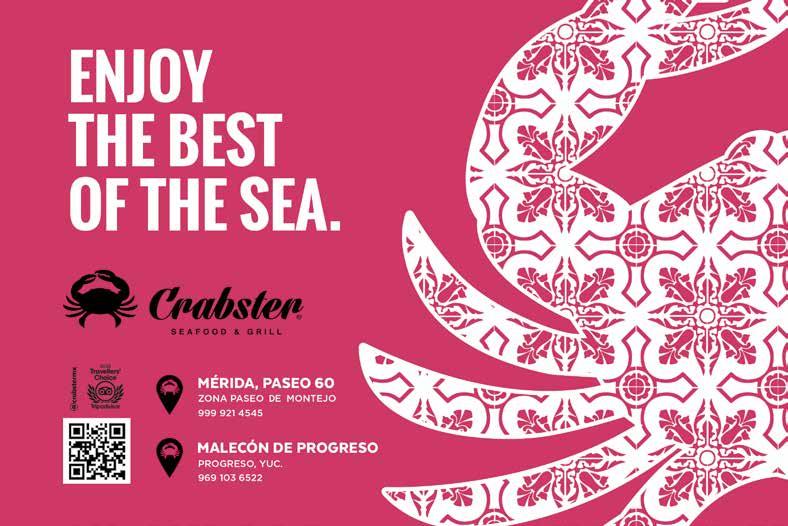

















 E Cenote Zací
E Cenote Zací


























































 Halachó, Yucatán
Halachó, Yucatán






































































